Hey there, person who's seen my blog! This was mainly a Splatoon-related blog, but it's become as much the place where I talk about guitars, my hobbies, and generally life as a whole.
Don't wanna be here? Send us removal request.
Text
Another update, because this was posted last Tuesday, before I went up to my aunt's, and actually before we found out some massive information about quite a few parts.
Let's start with the first thing - we know what polarity the Trisonic is! Specifically, it's a North Pole Up, rather than a South Pole Up, which we found out by attempting to stick the Trisonic to the Broadcaster pickup, the easiest and generally the most accurate method of ascertaining the polarities of a pickup, as long as you have a frame of reference, being the polarity of one of the pickups.
Considering we've known since the start that the Broadcaster pickup is a CSU pickup (clockwise, south up), we had a pretty decent frame of reference available for use. As such, I can quite safely say that the RWRP Kent Armstrong Works Trisonic pickup is one of either CNU (clockwise, north up) or ANU (anti-clockwise, north up), and as such, we can Chekhov's Gun our way into an even better function.
See, the Red Special, the guitar where I got the idea of using DPDT slide switches for turning on each pickup, has 6 switches, but only 3 pickups. The reason why is because the phase of each pickup can be switched, which gives even more tonal options than just the 3 pickups on their own. So, why do I bring it up? Well, I had to buy a minimum of 5 slide switches to get any of them in the first place. Doesn't sound too massive until you realise that 4 will be installed as default, even if only 3 will be wired up to start with.
Speaking of, lemme explain that. See, for a while, I've been doing some thinking, what some may say is a dangerous thing for me, mostly over whether I should get the piezo saddles and relevant electronics first, or something slightly more sensible and nab the locking tuners and humbucker first, and retrofit the piezo at a later date (using accommodations we'd make in the design during the build process). Considering how I described those, you should know which one I chose, on the advice of my aunt - not least because trying to test the piezo without a method of securing the strings is a) a waste of strings, and b) too bloody hard, because you can't easily get a reading from a piezo.
So why is it a Chekhov's gun that I got 5 switches? Well, it means that 4 can be dedicated to switching on and off each pickup, and the 5th, if need be, can be used for a phase switches for the middle pickup. That way, we don't need to know whether it's CNU or ANU, all we need to know is that it can be mounted, wired in a specific way, and can function in that way. Now, if it turns out that the pickup is constructed as ANU rather than CNU, the addition of a phase switch won't really matter. Considering my luck and Sod's law, however, I can't be certain that it's wound one way or another. So it's likely that I might add a phase switch anyway to make sure that, if I want to, I can get both pickups to quack and growl together.
Now, onto other matters than this. First off, the top's joined up, which is a Good Thing, but also, when I went up last Friday, we got what can, comparatively, be called "a lot" done. My best proof?
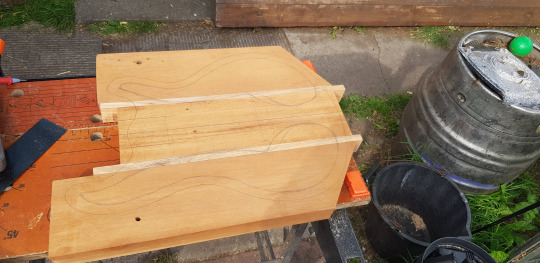
This is how we've ended up sketching out the chambers of the body, as well as how we drew the body shape on in the first place. We decided the walls of the chambers will be about 15-17mm, depending on the area it's located, with the floor of the chamber being about 10mm, to match with the current majority of the top's thickness.
The interesting thing of how we designed the chambers is that the prevailing design rule was no 90° corners - mostly because you can't really do sharp corners using a router bit. Or really any bit, for that matter. Even a theoretical square bit will have round edges if you want to actually drill or cut with it.
Now, sure, that's neither here nor there, when we're talking about the routing of chambers in a body blank made of 3 pieces solid mahogany and 2 strips of solid English ash, heavy as fuck even if you disregard the (likely) 1kg of bookmatched flame maple top, but I just thought it was interesting to mention. Importantly, though, you might notice that there's a few holes in the wood. Those are from when the wood was used as a door, and is, quite luckily, outside the bounds of the body, and on the sections of the blank which will be considered offcuts.
Speaking of adjustments, the neck, which I've been treating as if it'd be joining the body with that natural heel cap at the 20th fret, is instead going to be shifted inwards to have a more "expected" and "traditional" 19th fret join to the body, like the SG, the 335 and its thinline brethren (excepting the 330, because that got switched back over to the 16th fret join like the Epi Casino). This allows for greater neck security over a 20th or 21st fret neck join, even if I'm doing a tenon like PRS, or something else entirely, and it might just allow for better sustain of notes compared to a neck that is barely in the body altogether, though I'm not going to try and compare a '91 All-American CE24 to this, because they are two entirely different beasts, even if I'm effectively building a CE24 with slightly different, wackier specs.
Let's see... what else... ah, yes, the size and design of the central block! That, of course, is strange looking as it is in the drawing on the blank, but simply enough, it's to accommodate for everything I've got. The 3 magnetic pickups have to fit into a space about 6.25" with wildly different footprints in each case. A Wide Range, in theory, takes up around 2" of that space. I assumed, quite incorrectly, that a space of 4.25" would be able to fit both a tilted Trisonic and a baseplate-mounted Tonerider bridge pickup.
I was wrong. Quite simply, there's not enough room to have the tilted bridge and middle pickup while keeping the guitar at a 25" scale. So I had a choice to make. I could use a different pickup, omit one of the pickups altogether, or change the orientations of the pickups as they are now. I chose the latter, and decided to straighten out all of the pickups. Not just the Trisonic, but also the Tonerider as well, even if it fucks with the pole spacing and the response of each string to the pickup, like that 7 string pickup Leo Fender was messing about with in the late '50s.
Other than that, though, I think that about wraps it up for this update. Sure, not exactly expansive, but maybe I'll have something next week or the week after. It might not be another reblog, it might be the same post, but rest assured, I'm going to try and keep updates semi-consistent.
It's Guitar Update Time!
So, last I talked about this thing properly was March, when I thought it was gonna be made of iroko rather than mahogany. Crazy how I thought that for a solid 2 weeks, but couldn't be arsed changing the spec sheet to reflect that thought. At the same time, I'm glad I didn't, because that would be a waste of a spec sheet iteration, and we're only just getting to Version 9.
I fully expect to have 34 .txt files named some variant of "The Crusader (Guitar Specs)" by the time this thing is finished, even if the only difference is a couple lines added or removed and an extra thing crossed off the price list (even though there's... 5 things left to go before I'm clear of buying parts).
Anyway, back on topic, progress is progressing. Me and my aunt actually built a body blank in the past 3 months. Here it was about... a month and a half ago, on April 25th.

Just now do I realise that this update has been long overdue, but fuck it, we ball.
So, as said, this is where it was a month and a half ago. A body blank, ready to be glued, and waiting on other parts. About a week and a bit later, because I want a full thickness maple top on this bastard, even if it's a PRS carve, and not the full arch, I got this massive lump of wood.
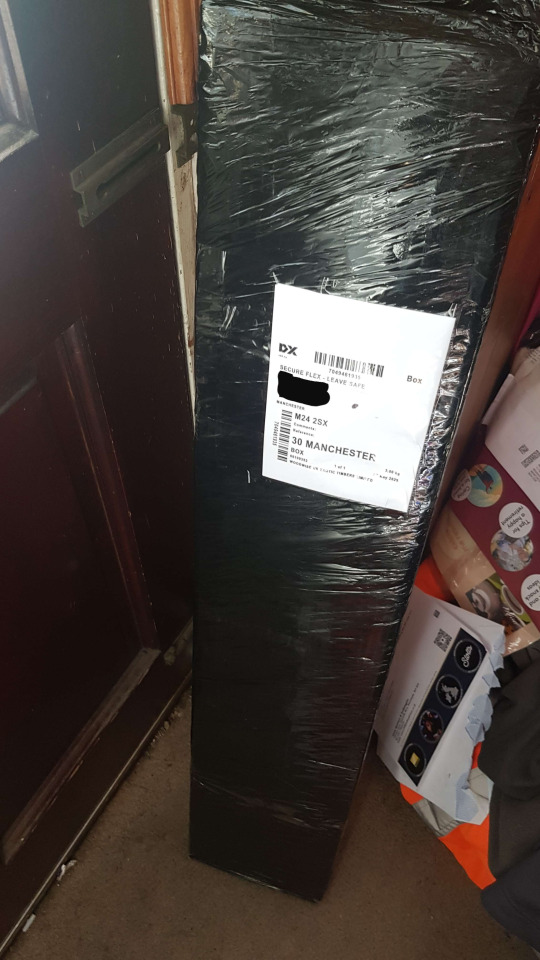
I know, you're probably wondering why it's still wrapped up if I'd just received it. Well, due to my policy of 1 visit every 2 weeks (worked out back in January of last year, because I felt me being up there every week, like I was when building the Fretless, was a bit too much), I received this the Tuesday of the week I was back up there. I mainly kept it in the packaging to make sure that a) it was kept safe from any scarring, denting or similar, and b) I wanted to see it in person for the first time when I was up there, where the natural light would most efficiently bring out the figure and dance of the wood.
Plus, figured wood doesn't like being in really different conditions. It tends to warp, quite easily. So anyway, I took it up that Friday, and we ended up nattering about stuff. Like, for example, the fact that caffeine is an irritant to your nervous system. That's why someone can get used to it, and even require it to function, and why it wakes you up so efficiently... as long as you're not too tired. How tired is "too tired"? My answer is when, after 2 mugs of coffee, I was still yawning and needed a guitar in my hands just to stimulate my brain to avoid falling asleep.
It... didn't work. Was nice having a snooze out in the sun, but also annoying, because I fell asleep in the first place. As much as my sleep schedule may as well not exist to begin with, doesn't mean I can't hate sleeping outside of "normal hours". Maybe it also has something to do with secondary school, but that is a kinda private story, and definitely not something I'm comfortable sharing to the 25 people that will actually see this on their dash (even if I talk to about half of them on the regular).
Anyway, that day, while it resulted in me falling asleep in the sunshine (something both rare and annoying, because how did I let it get that far), it also resulted in me and my aunt discussing stuff relating to the build. For one, we determined that the inlays of the guitar would be made of bocote. I know, wood names sound like they're all made up of random letters in a random order, like we're playing Countdown. "Iroko", "bocote", "panga panga", "cocobolo", "zelkova", they all sound like we're fucking with everyone who isn't slightly clued into anything related to wood and trees, but no, they're all real names for woods. You can look them up, I'm not joking.
Anyway, bocote. It's also known sometimes as Mexican rosewood, and is not to be confused with Madagascar rosewood, also known as palisander (side note: if you search up "palisander wood", you'll see a Merriam-Webster definition saying that palisander is Brazilian rosewood - this is false, it is most definitely not Brazilian rosewood, as you can still buy palisander without a CITES certificate being present at quantities and weights above 10kg). How do we qualify what rosewoods are? Well, there's a few ways.
The key one, really, is to look at the genus. True, genuine rosewoods with the fame and wonder are of the genus dalbergia. I've mentioned 2 already: Madagascar rosewood, and Brazilian rosewood, which each come from the genus of dalbergia, the former commonly being d. baronii or d. greveana, while the latter is of one specific species: dalbergia nigra. If you hear about a massive seizure of illegally-traded woods, it's likely to be this, due to its immense rarity and being the tonewood to end all tonewoods.
In case you've stumbled across this post with no knowledge of why Brazilian rosewood is the most sought-after tonewood in the world, on par with old-growth swietenia mahagoni, it's because they got used in Bursts. If you're new to the history of the electric solid body guitar, or don't really read about this stuff, a Burst (yes, the capital B is required, we're talking about big shit here) is a Gibson Les Paul guitar from between 1958 to 1960, subject to a common joke of "Of 1,500 made, only 2,000 are present and accounted for," making fun of the fact that "Bursts" keep appearing despite there being no way that some of them could have been made in that 3 year period.
Common characteristics of a Burst include a 1-piece mahogany neck with Brazilian rosewood fretboard, a mahogany body with 2-piece flame maple top, mounted with 2 PAF humbuckers, 500k Chicago Telephone Supply potentiometers, a post-mounted ABR-1 Tune-o-Matic bridge with stopbar tailpiece, and the "open book" headstock pitched at a 17° angle from the flat of the neck, a 2-screw "bell" truss rod cover, with a wide bevelled edge, with "Standard" never written on it, unless the truss rod cover has been replaced (though with how that would severely devalue the guitar, that basically never happens).
In short, Bursts are highly valued pieces of history (it often costs a buyer £500,000 to have it in their hands) which have also influenced woods. Now, where was I...
Oh yeah, bocote. Fuck, how did I get to Bursts from bocote? I don't know, I'm just going with it. Anyway, Bursts aside, and back to the build, the inlays, designed after a favourite of mine, the Rickenbacker 4003, will be made of bocote, and made to also act as the side markers using something similar to Gretsch's thumbnail inlays on their "neo-classical" fretboards, which are placed right at the edge to act as both the fret marker and side marker. Mind you, this design decision is only possible because the fretboard will be unbound. The main reason is that it makes refretting it far easier down the line, because I envision that I'll most likely play it that much, but the other reason is that I don't really like the vibes of a bound fretboard.
On acoustics, sure, I'm fine with those, especially if the binding is indistinct from the wood of the fretboard. But it doesn't really serve a purpose outside of that, from what I see, especially with Gibson's stupid fret ends that get removed 9 times out of 10 when you refret the things.
And that's putting aside the fact that this is my guitar and I get to decide what I do with it. But that's the be-all and end-all, isn't it? My shit, I get to decide what I do with and to it, up to and including custom graphics or silly little easter eggs that only I and my aunt will know about, usually because it ends up under the finish.
But that's neither here nor there. Importantly, what is here or there is that this is taking from some old Les Paul Customs known as "Blonde Beauties", which are kinda a counterpoint to the age-old Black Beauty LPC that has a completely black finish with ebony fretboard and (sometimes) 3 pickups. Blonde Beauties are known as such because they are natural finishes with maple fretboards, like a Fender neck. More specifically, this build is taking from the Blonde Beauties of last decade, when people were saying stuff along the lines of, "Why does it have to be richlite? Why can't we have real wood fretboards?", which was then swiftly followed by a sudden influx of dealers ordering Customs with maple fretboards for the first time since the 1970s (when the feature was first even a thing). The only massive differences between Henry J maple fretboards and Norlin maple fretboards is that the former were on mahogany necks and unlacquered, while the latter were on 3-piece maple necks and lacquered, which prevented them from becoming dirty worn to the bare wood and naturally stained too quickly.
As a point of contention, though, we went to talking about whether I wanted to make my guitar's maple fretboard out of the remainder of a plank she got in or around 1992 for her second build, or wanted a flame maple fretboard to go along with the top. I chose the latter, because flame maple is nice to use, even if it's a bitch to work with sometimes. Plus it meant that I could get a pre-sized fingerboard rather than having to cut it off that 30-something year old which has a split in it.
So that left me with an entirely new question - what fingerboard to get (fingerboard and fretboard are interchangeable, I don't care which one I use). I had six options when I first looked, and ended up doing a poll in the Curated Tumblr Discord Server just to see what others actually felt in terms of opinions.
While I think on, here's what the flame maple actually looked like beneath the packaging, if you were curious:
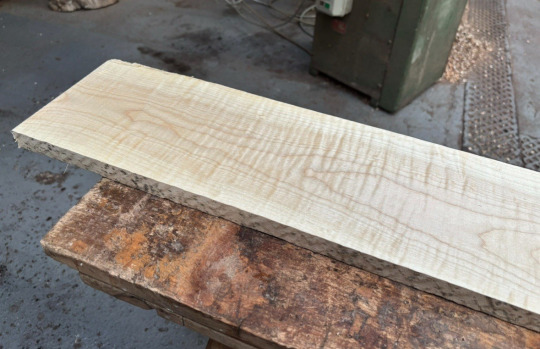
And to return to what I was talking about, with the flame maple fingerboards (I've now decided on using "fingerboard" to refer to the unfretted piece, and "fretboard" to refer to the "final" product), in making the poll, I had to obviously provide images of the 6 options I had available to me. Being that all six were the same price (£21.95 + P&P, which ended up being £28.90), it was mostly a hope for decisions based on figuring and grain.
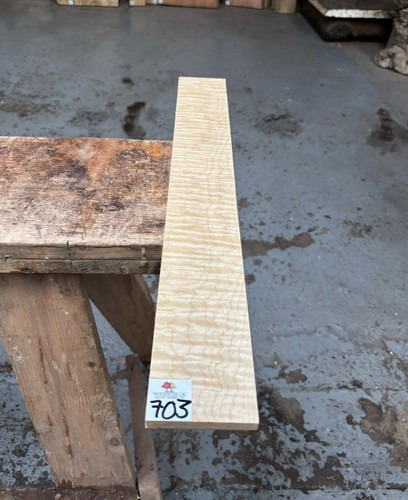
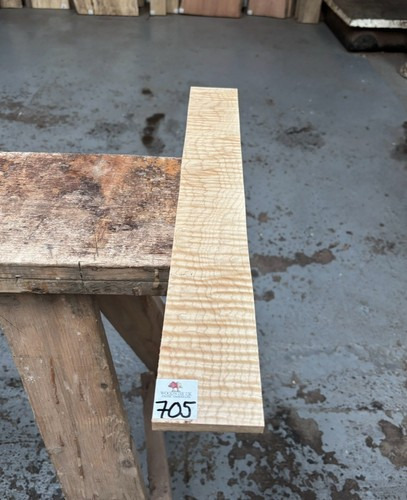
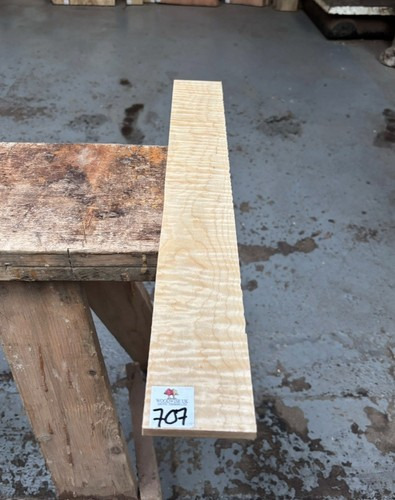
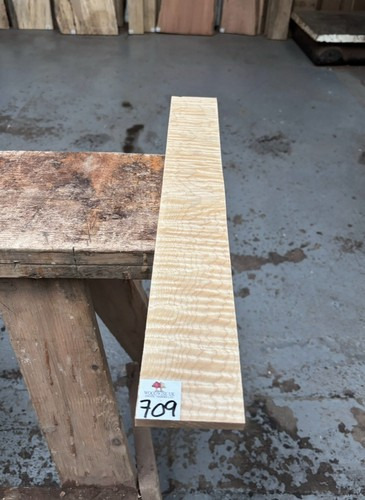
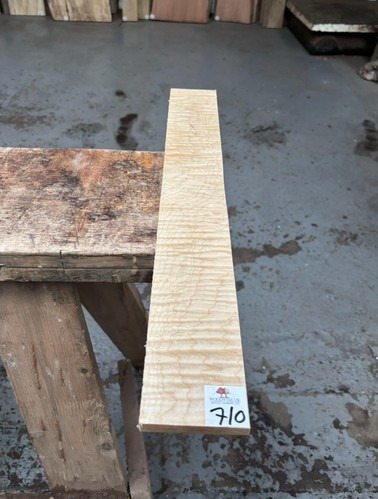

Now, as you can probably guess, this stuff is about as variable as anything, on par with the weather here (I have a term for this, nabbed from a friend a bit further south - ADHD weather. Fits, doesn't it?). The main reason that it's so variable is because how figured woods grow, and how they get harvested. You can't just randomly find figuring in a rock maple tree. It just doesn't grow like that. Trees will want to instinctively grow upwards to maximise the amount of sunlight that they get. The thing is, they can sometimes start off sprouting at a somewhat extreme angle, or the land under them can slip and end up tilting the tree off the vertical, which the tree will naturally correct to continue growing vaguely upwards and out. These corrections are how you get flame figuring in wood. They are caused by the fibers becoming stressed. Other times, it can be caused by a fungus, or a bacteria eating at the wood, which will cause spalting. Spalting is most common in the white and black limba woods, the former also being known as korina.
Side note, korina isn't the actual name, that's just what Gibson called it. If you see someone selling limba wood, and it looks like spalted korina, it's the same thing, it's just someone not using what effectively amounts to a brand name, like how Vauxhall cars are named Opel in Europe. It's just a special name, they're the exact same thing.
So anyway, back to the fingerboards, the poll ended up resulting in a win for Option 6, which was numbered 711, so I wonder why that ended up winning (just kidding I know exactly why). I wasn't complaining, though, that's a really nicely figured piece, so it really felt like a win-win situation, if that makes sense.
After nabbing that off of eBay, and it getting delivered to my house from Staffordshire (which is just a couple counties down from Greater Manchester), that got taken up on the 23rd of May, and ofc while I was up there on that day, we got to nattering about all sorts of bollocks, including, quite obviously, the guitar, which is where the next spec update came in: chambering.
Now, I know what you're thinking - I said this wouldn't be chambered in every spec sheet variant I've made up until recently. I know I have, and the reason I did is because I was expecting that, with the amount of mass I'd need to remove to make this an actually functional guitar (cavities for the controls and the trem spring, plus the drop through for the trem itself, and then the pickup cavities and the neck pocket), I wouldn't need to chamber it out.
How wrong I was. See, it turns out that a 5-piece body made of solid mahogany and ash weighs quite a bit - about 4.46kg, including the two pieces of the top. For my readers over the pond, that's 9lbs, 13.32oz to 2sf. In short, despite wanting to avoid it as much as possible, I somehow made a boat anchor rather than something reasonable in weight. Needless to say, as soon as I found that out, I relented, and agreed that we might, just might, want some chambering in this bugger.
If you're confused where I got the term "boat anchor" from, I got it from watching Trogly, who uses it to refer to Norlin Les Pauls, as does just about everyone in the guitar sphere. Not that you'd actually want to use a '70s LP as a boat anchor, they're just coming up to the side of vintage that makes them appealing. That, and the water'd just ruin the wood. Sure, Henry J era Gibson made a few "sunken treasure" Les Pauls (no seriously, the run was literally called that), but you can't exactly get solid lumps of 50 year old mahogany anymore.
So anyway, the upside to learning all of this is that we got a plan of action for how everything's going to be implemented. Due to me getting some small yet necessary components early on (truss rod, pots, pickguard material for the backplates), we don't need to worry about those bits, and can get them sorted quickly and easily, with this plan of chambering also allowing us far more flexibility with the allocation of space for everything, considering what I want to put in and how I want to put it in.
Let me lay out how I want it to work: 4 pickups (one of which is a saddle-based piezo, so that's going to be interesting to install and wire up), all connected to separate switches that turn on or off the pickup, like the Red Special, all connected to and running through a stacked concentric 1MΩ pot with audio taper, acting as the volume control, with one being used for the piezo and the other for the magnetic pickups. These pots are then connected to 2 individual linear taper 1MΩ pots to act as the tone controls. These then meet up at the output jack where they would hopefully, hopefully, function as intended, and allow me both classic-style magnetic tones and more crisp and manipulable acoustic tones.
That's just the electronics side, though, and something that will only get done when I have all the prerequisite components. Speaking of components, the thing I figured that I'd need to get around this time is the bridge. Don't ask me why I've gotten the bridge but still not the tuners or neck pickup, I'm not rightly sure myself, but that's currently how it is. The neat thing with it, though, is that it's a real and genuine PRS part, even if it's most likely intended for use on the SE guitars rather than CE or higher.
Now, when I brought the bridge system with me last time I went up, as usual, nattering happened (putting the world to rights, and similar), but we figured out what specific style of chambering, if any, I wanted for the guitar: a modified version of the Telecaster Thinline's chambering.
In case you didn't see it when I posted it, I talked about the Telecaster Thinline in my post cataloguing what can basically be called the Life and Times of Leo Fender through the lens of someone with both too much and not enough time on their hands, an internet connection and a hyperfixation on guitars so massive, it took me three weeks to write the post because I wanted it to be accurate (and I still missed shit and fucked up the proofreading, so hey, what a surprise). I mentioned how it's a Telecaster with a thin-ish sheet of body material removed from the back, routed through the top, with the F-hole added, then they return a thin sheet of the material the body's made of to the back, so it looks basically untouched (as long as you don't know where to look). What I didn't get to show in that post, however, is this:
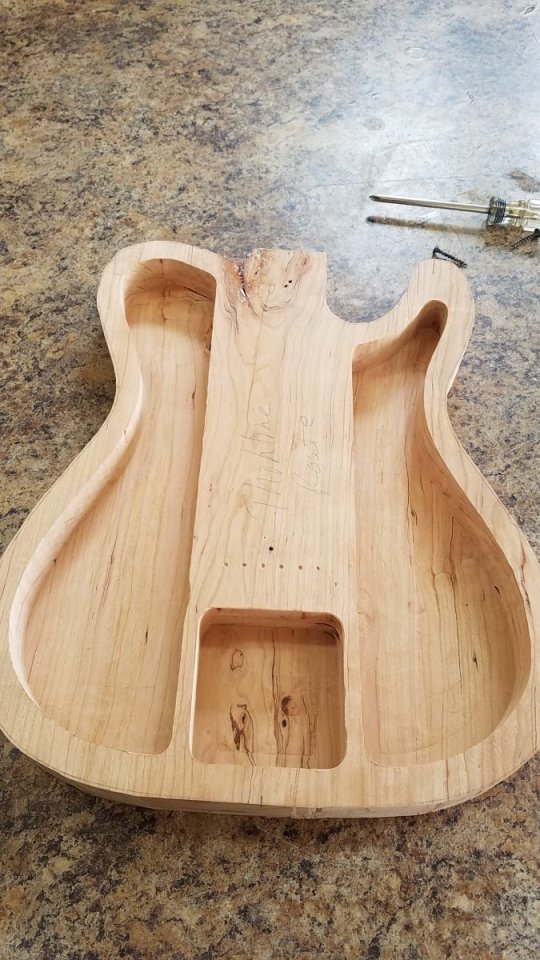
This is someone's recreation of the internal chambering of a Telecaster Thinline. More often than not, nowadays, it appears that people route from the top, rather than the bottom, to allow for figured tops (which I understand). As you can see, it's 2 large separated chambers, with a third behind the bridge, with interior walls of about 1/4" (just by eyeball, could be wrong) and the usual 1¾" deep body.
Now, I said that I chose a modified version of the Thinline chambering, so you may be wondering what I meant by that. Well, what I meant by that was just getting rid of the third chamber by smushing the two interior walls together, the logic being that by removing that third chamber, it makes it generally easier to chamber the entire thing, while keeping the main mass of wood in a block where the pickups and bridge will go. Also, I mostly made the decision over deliberation that lasted the better part of 2 or 3 hours while we sat and talked shop and our usual brand of natter; really just what I'd call putting the world to rights, but with less politics and more music.
That now leads us to today, really. Most of the massive things with the build happened 6-8 weeks ago, what I need now, more than anything, is the last few bits and bobs to properly assemble the bugger. As I'm writing this, the next bit I've ordered is that RWRP Tri Sonic that I've been talking about for literal months, reason being that I don't know what the direction is for the winds or the way the magnet's facing. No shade to Armstrong Music, apparently these are the best replicas if you don't want to get Adeson pickups (which, let's be honest, fuck that), but they could have done a solid and listed the wind direction and magnet facing, because that'd mean I'd know if we have to flip the magnets, swap the leads, do both or do neither, considering I'm looking at a CSU construction on the bridge pickup, so I'm hoping against hope that it's an ANU construction, to save us some work, but I wouldn't be surprised if it's anything like CNU or ASU, or if it's another CSU pickup. Sod's law can be like that, y'know?
Anyway, that's it, post is over, go home. I'll try to be more forthcoming with updates, and if I don't remember, well, c'est la vie. Who knows, maybe I'll manage to get the build done before New Year's Day 2026 (which may actually be difficult). That, of course, remains to be seen, though, and in the meantime, I'll leave you with this update.
#guitar building#guitar#tw swearing#lutherie#watch me forget to update in 2 weeks#wouldn't be surprised if that happened#or maybe i won't forget#who knows at this point
1 note
·
View note
Text
It's Guitar Update Time!
So, last I talked about this thing properly was March, when I thought it was gonna be made of iroko rather than mahogany. Crazy how I thought that for a solid 2 weeks, but couldn't be arsed changing the spec sheet to reflect that thought. At the same time, I'm glad I didn't, because that would be a waste of a spec sheet iteration, and we're only just getting to Version 9.
I fully expect to have 34 .txt files named some variant of "The Crusader (Guitar Specs)" by the time this thing is finished, even if the only difference is a couple lines added or removed and an extra thing crossed off the price list (even though there's... 5 things left to go before I'm clear of buying parts).
Anyway, back on topic, progress is progressing. Me and my aunt actually built a body blank in the past 3 months. Here it was about... a month and a half ago, on April 25th.

Just now do I realise that this update has been long overdue, but fuck it, we ball.
So, as said, this is where it was a month and a half ago. A body blank, ready to be glued, and waiting on other parts. About a week and a bit later, because I want a full thickness maple top on this bastard, even if it's a PRS carve, and not the full arch, I got this massive lump of wood.

I know, you're probably wondering why it's still wrapped up if I'd just received it. Well, due to my policy of 1 visit every 2 weeks (worked out back in January of last year, because I felt me being up there every week, like I was when building the Fretless, was a bit too much), I received this the Tuesday of the week I was back up there. I mainly kept it in the packaging to make sure that a) it was kept safe from any scarring, denting or similar, and b) I wanted to see it in person for the first time when I was up there, where the natural light would most efficiently bring out the figure and dance of the wood.
Plus, figured wood doesn't like being in really different conditions. It tends to warp, quite easily. So anyway, I took it up that Friday, and we ended up nattering about stuff. Like, for example, the fact that caffeine is an irritant to your nervous system. That's why someone can get used to it, and even require it to function, and why it wakes you up so efficiently... as long as you're not too tired. How tired is "too tired"? My answer is when, after 2 mugs of coffee, I was still yawning and needed a guitar in my hands just to stimulate my brain to avoid falling asleep.
It... didn't work. Was nice having a snooze out in the sun, but also annoying, because I fell asleep in the first place. As much as my sleep schedule may as well not exist to begin with, doesn't mean I can't hate sleeping outside of "normal hours". Maybe it also has something to do with secondary school, but that is a kinda private story, and definitely not something I'm comfortable sharing to the 25 people that will actually see this on their dash (even if I talk to about half of them on the regular).
Anyway, that day, while it resulted in me falling asleep in the sunshine (something both rare and annoying, because how did I let it get that far), it also resulted in me and my aunt discussing stuff relating to the build. For one, we determined that the inlays of the guitar would be made of bocote. I know, wood names sound like they're all made up of random letters in a random order, like we're playing Countdown. "Iroko", "bocote", "panga panga", "cocobolo", "zelkova", they all sound like we're fucking with everyone who isn't slightly clued into anything related to wood and trees, but no, they're all real names for woods. You can look them up, I'm not joking.
Anyway, bocote. It's also known sometimes as Mexican rosewood, and is not to be confused with Madagascar rosewood, also known as palisander (side note: if you search up "palisander wood", you'll see a Merriam-Webster definition saying that palisander is Brazilian rosewood - this is false, it is most definitely not Brazilian rosewood, as you can still buy palisander without a CITES certificate being present at quantities and weights above 10kg). How do we qualify what rosewoods are? Well, there's a few ways.
The key one, really, is to look at the genus. True, genuine rosewoods with the fame and wonder are of the genus dalbergia. I've mentioned 2 already: Madagascar rosewood, and Brazilian rosewood, which each come from the genus of dalbergia, the former commonly being d. baronii or d. greveana, while the latter is of one specific species: dalbergia nigra. If you hear about a massive seizure of illegally-traded woods, it's likely to be this, due to its immense rarity and being the tonewood to end all tonewoods.
In case you've stumbled across this post with no knowledge of why Brazilian rosewood is the most sought-after tonewood in the world, on par with old-growth swietenia mahagoni, it's because they got used in Bursts. If you're new to the history of the electric solid body guitar, or don't really read about this stuff, a Burst (yes, the capital B is required, we're talking about big shit here) is a Gibson Les Paul guitar from between 1958 to 1960, subject to a common joke of "Of 1,500 made, only 2,000 are present and accounted for," making fun of the fact that "Bursts" keep appearing despite there being no way that some of them could have been made in that 3 year period.
Common characteristics of a Burst include a 1-piece mahogany neck with Brazilian rosewood fretboard, a mahogany body with 2-piece flame maple top, mounted with 2 PAF humbuckers, 500k Chicago Telephone Supply potentiometers, a post-mounted ABR-1 Tune-o-Matic bridge with stopbar tailpiece, and the "open book" headstock pitched at a 17° angle from the flat of the neck, a 2-screw "bell" truss rod cover, with a wide bevelled edge, with "Standard" never written on it, unless the truss rod cover has been replaced (though with how that would severely devalue the guitar, that basically never happens).
In short, Bursts are highly valued pieces of history (it often costs a buyer £500,000 to have it in their hands) which have also influenced woods. Now, where was I...
Oh yeah, bocote. Fuck, how did I get to Bursts from bocote? I don't know, I'm just going with it. Anyway, Bursts aside, and back to the build, the inlays, designed after a favourite of mine, the Rickenbacker 4003, will be made of bocote, and made to also act as the side markers using something similar to Gretsch's thumbnail inlays on their "neo-classical" fretboards, which are placed right at the edge to act as both the fret marker and side marker. Mind you, this design decision is only possible because the fretboard will be unbound. The main reason is that it makes refretting it far easier down the line, because I envision that I'll most likely play it that much, but the other reason is that I don't really like the vibes of a bound fretboard.
On acoustics, sure, I'm fine with those, especially if the binding is indistinct from the wood of the fretboard. But it doesn't really serve a purpose outside of that, from what I see, especially with Gibson's stupid fret ends that get removed 9 times out of 10 when you refret the things.
And that's putting aside the fact that this is my guitar and I get to decide what I do with it. But that's the be-all and end-all, isn't it? My shit, I get to decide what I do with and to it, up to and including custom graphics or silly little easter eggs that only I and my aunt will know about, usually because it ends up under the finish.
But that's neither here nor there. Importantly, what is here or there is that this is taking from some old Les Paul Customs known as "Blonde Beauties", which are kinda a counterpoint to the age-old Black Beauty LPC that has a completely black finish with ebony fretboard and (sometimes) 3 pickups. Blonde Beauties are known as such because they are natural finishes with maple fretboards, like a Fender neck. More specifically, this build is taking from the Blonde Beauties of last decade, when people were saying stuff along the lines of, "Why does it have to be richlite? Why can't we have real wood fretboards?", which was then swiftly followed by a sudden influx of dealers ordering Customs with maple fretboards for the first time since the 1970s (when the feature was first even a thing). The only massive differences between Henry J maple fretboards and Norlin maple fretboards is that the former were on mahogany necks and unlacquered, while the latter were on 3-piece maple necks and lacquered, which prevented them from becoming dirty worn to the bare wood and naturally stained too quickly.
As a point of contention, though, we went to talking about whether I wanted to make my guitar's maple fretboard out of the remainder of a plank she got in or around 1992 for her second build, or wanted a flame maple fretboard to go along with the top. I chose the latter, because flame maple is nice to use, even if it's a bitch to work with sometimes. Plus it meant that I could get a pre-sized fingerboard rather than having to cut it off that 30-something year old which has a split in it.
So that left me with an entirely new question - what fingerboard to get (fingerboard and fretboard are interchangeable, I don't care which one I use). I had six options when I first looked, and ended up doing a poll in the Curated Tumblr Discord Server just to see what others actually felt in terms of opinions.
While I think on, here's what the flame maple actually looked like beneath the packaging, if you were curious:

And to return to what I was talking about, with the flame maple fingerboards (I've now decided on using "fingerboard" to refer to the unfretted piece, and "fretboard" to refer to the "final" product), in making the poll, I had to obviously provide images of the 6 options I had available to me. Being that all six were the same price (£21.95 + P&P, which ended up being £28.90), it was mostly a hope for decisions based on figuring and grain.






Now, as you can probably guess, this stuff is about as variable as anything, on par with the weather here (I have a term for this, nabbed from a friend a bit further south - ADHD weather. Fits, doesn't it?). The main reason that it's so variable is because how figured woods grow, and how they get harvested. You can't just randomly find figuring in a rock maple tree. It just doesn't grow like that. Trees will want to instinctively grow upwards to maximise the amount of sunlight that they get. The thing is, they can sometimes start off sprouting at a somewhat extreme angle, or the land under them can slip and end up tilting the tree off the vertical, which the tree will naturally correct to continue growing vaguely upwards and out. These corrections are how you get flame figuring in wood. They are caused by the fibers becoming stressed. Other times, it can be caused by a fungus, or a bacteria eating at the wood, which will cause spalting. Spalting is most common in the white and black limba woods, the former also being known as korina.
Side note, korina isn't the actual name, that's just what Gibson called it. If you see someone selling limba wood, and it looks like spalted korina, it's the same thing, it's just someone not using what effectively amounts to a brand name, like how Vauxhall cars are named Opel in Europe. It's just a special name, they're the exact same thing.
So anyway, back to the fingerboards, the poll ended up resulting in a win for Option 6, which was numbered 711, so I wonder why that ended up winning (just kidding I know exactly why). I wasn't complaining, though, that's a really nicely figured piece, so it really felt like a win-win situation, if that makes sense.
After nabbing that off of eBay, and it getting delivered to my house from Staffordshire (which is just a couple counties down from Greater Manchester), that got taken up on the 23rd of May, and ofc while I was up there on that day, we got to nattering about all sorts of bollocks, including, quite obviously, the guitar, which is where the next spec update came in: chambering.
Now, I know what you're thinking - I said this wouldn't be chambered in every spec sheet variant I've made up until recently. I know I have, and the reason I did is because I was expecting that, with the amount of mass I'd need to remove to make this an actually functional guitar (cavities for the controls and the trem spring, plus the drop through for the trem itself, and then the pickup cavities and the neck pocket), I wouldn't need to chamber it out.
How wrong I was. See, it turns out that a 5-piece body made of solid mahogany and ash weighs quite a bit - about 4.46kg, including the two pieces of the top. For my readers over the pond, that's 9lbs, 13.32oz to 2sf. In short, despite wanting to avoid it as much as possible, I somehow made a boat anchor rather than something reasonable in weight. Needless to say, as soon as I found that out, I relented, and agreed that we might, just might, want some chambering in this bugger.
If you're confused where I got the term "boat anchor" from, I got it from watching Trogly, who uses it to refer to Norlin Les Pauls, as does just about everyone in the guitar sphere. Not that you'd actually want to use a '70s LP as a boat anchor, they're just coming up to the side of vintage that makes them appealing. That, and the water'd just ruin the wood. Sure, Henry J era Gibson made a few "sunken treasure" Les Pauls (no seriously, the run was literally called that), but you can't exactly get solid lumps of 50 year old mahogany anymore.
So anyway, the upside to learning all of this is that we got a plan of action for how everything's going to be implemented. Due to me getting some small yet necessary components early on (truss rod, pots, pickguard material for the backplates), we don't need to worry about those bits, and can get them sorted quickly and easily, with this plan of chambering also allowing us far more flexibility with the allocation of space for everything, considering what I want to put in and how I want to put it in.
Let me lay out how I want it to work: 4 pickups (one of which is a saddle-based piezo, so that's going to be interesting to install and wire up), all connected to separate switches that turn on or off the pickup, like the Red Special, all connected to and running through a stacked concentric 1MΩ pot with audio taper, acting as the volume control, with one being used for the piezo and the other for the magnetic pickups. These pots are then connected to 2 individual linear taper 1MΩ pots to act as the tone controls. These then meet up at the output jack where they would hopefully, hopefully, function as intended, and allow me both classic-style magnetic tones and more crisp and manipulable acoustic tones.
That's just the electronics side, though, and something that will only get done when I have all the prerequisite components. Speaking of components, the thing I figured that I'd need to get around this time is the bridge. Don't ask me why I've gotten the bridge but still not the tuners or neck pickup, I'm not rightly sure myself, but that's currently how it is. The neat thing with it, though, is that it's a real and genuine PRS part, even if it's most likely intended for use on the SE guitars rather than CE or higher.
Now, when I brought the bridge system with me last time I went up, as usual, nattering happened (putting the world to rights, and similar), but we figured out what specific style of chambering, if any, I wanted for the guitar: a modified version of the Telecaster Thinline's chambering.
In case you didn't see it when I posted it, I talked about the Telecaster Thinline in my post cataloguing what can basically be called the Life and Times of Leo Fender through the lens of someone with both too much and not enough time on their hands, an internet connection and a hyperfixation on guitars so massive, it took me three weeks to write the post because I wanted it to be accurate (and I still missed shit and fucked up the proofreading, so hey, what a surprise). I mentioned how it's a Telecaster with a thin-ish sheet of body material removed from the back, routed through the top, with the F-hole added, then they return a thin sheet of the material the body's made of to the back, so it looks basically untouched (as long as you don't know where to look). What I didn't get to show in that post, however, is this:

This is someone's recreation of the internal chambering of a Telecaster Thinline. More often than not, nowadays, it appears that people route from the top, rather than the bottom, to allow for figured tops (which I understand). As you can see, it's 2 large separated chambers, with a third behind the bridge, with interior walls of about 1/4" (just by eyeball, could be wrong) and the usual 1¾" deep body.
Now, I said that I chose a modified version of the Thinline chambering, so you may be wondering what I meant by that. Well, what I meant by that was just getting rid of the third chamber by smushing the two interior walls together, the logic being that by removing that third chamber, it makes it generally easier to chamber the entire thing, while keeping the main mass of wood in a block where the pickups and bridge will go. Also, I mostly made the decision over deliberation that lasted the better part of 2 or 3 hours while we sat and talked shop and our usual brand of natter; really just what I'd call putting the world to rights, but with less politics and more music.
That now leads us to today, really. Most of the massive things with the build happened 6-8 weeks ago, what I need now, more than anything, is the last few bits and bobs to properly assemble the bugger. As I'm writing this, the next bit I've ordered is that RWRP Tri Sonic that I've been talking about for literal months, reason being that I don't know what the direction is for the winds or the way the magnet's facing. No shade to Armstrong Music, apparently these are the best replicas if you don't want to get Adeson pickups (which, let's be honest, fuck that), but they could have done a solid and listed the wind direction and magnet facing, because that'd mean I'd know if we have to flip the magnets, swap the leads, do both or do neither, considering I'm looking at a CSU construction on the bridge pickup, so I'm hoping against hope that it's an ANU construction, to save us some work, but I wouldn't be surprised if it's anything like CNU or ASU, or if it's another CSU pickup. Sod's law can be like that, y'know?
Anyway, that's it, post is over, go home. I'll try to be more forthcoming with updates, and if I don't remember, well, c'est la vie. Who knows, maybe I'll manage to get the build done before New Year's Day 2026 (which may actually be difficult). That, of course, remains to be seen, though, and in the meantime, I'll leave you with this update.
#takosader's ramblings 17(000000)#okay so aside from guitar talk#why do we always use 17 as the qualifier for a massive number#why is 17 the most common “random” number#what's so special about it#gibson guitars#fender#warning: may contain woods#obligatory “fuck gibson” because £10k for a guitar is ridiculous#tw swearing
1 note
·
View note
Text
Non-Specific Ramble
Okay, so this is going to be mostly stream-of-consciousness stuff, but there's a lot of shit I think about, mostly guitar-related, but still there nonetheless.
Let's start with the offcuts of my builds. Of course, I've been building using either reclaimed wood or wood I bought online. The remainders of these woods are probably going to get reused in... something, but in the meantime, I've still got to finish building the thing. Speaking of, we're actually at the stage where there's a body and a top!
Last I checked in, the top was unfinished, as in, it wasn't two pieces unfolded and joined via glue, but there is at least a body blank, made just as specified in the spec sheet using 3 rather large chunks of mahogany, and smaller strips of ash. But of course, I mentioned the maple top, didn't I?
The thing with that is that there will, inevitably, be an offcut. I only needed about half of it, so of course that means we cut it to the size we needed, and then started levelling out the middle so we had a clean, flat and straight surface to glue across. I know, a sentence you'd never otherwise read on Tumblr, yet here we are.
While I was building it, an idea cropped up in my head, related to something I remembered my aunt telling me about. See, for the build, she bought a bespoke fretting jig off a guy in Pembrokeshire, meant for fretting 25" scale lengths. She also mentioned what other scale lengths he covered: 25.5, 24.6, the usual stuff. She also mentioned that he had one for 21.375", which caught my attention.
I think I've talked about this before, but to cover my bases, here we go again. So, if you're at all familiar with John Lennon or the Beatles or anything, you'll know about the Rickenbacker 325, the top-of-the-line short-scale of the 300 Series of guitars, calculated from base models at 310, 330, 360, plus some weird and wacky things that also just so happened to be numbered in the 300s, such as the 350 (long-scale variant of the 325), 380L (Laguna model, came with optional piezo, based on 360), 381 (also based on the 360, but with a German carve on the top and the back, making it thicker than a normal 360), plus some oddball acoustics in the '50s at the very top end (390-394) based on the designs of Roger Rossmeisl's father, Wenzel Rossmeisl.
Now, how were they calculated from these base models? Simple: add 5 to the model number to get a vibrato, add 10 to get an extra pickup, and add 15 to get both. You could also add 6 to select 12-string models to get a comb mechanism that muted the octave strings, or just write "/12" next to a model number to attempt to get a 12-string variant, not that you'd always get it. Some models just don't exist as 12-strings, while others do. Interestingly enough, while being effectively identical to a 320/12, Rickenbacker made one model that physically shouldn't exist, especially not by most people's standards for 12 strings.
That's going to need a small tangent to explain. See, in the world of guitars, especially in 12-strings, people tend to accept that you just don't put vibratos or trem systems on a 12-string model. They are either hardtail top-loaders or hardtail string-throughs. Rickenbackers, with their tailpieces, are hardtail top-loaders, while Fender's Electric XII, with a very specially designed bridge system, is a hardtail string-through. That doesn't stop some companies from trying though, or Chinese copycats from including it as a feature for some reason. For example, a couple years ago, I saw a Gretsch-style 12-string with a Bigsby B7 copy. No, there wasn't any other tailpiece, and no, it wasn't on a doubleneck. Meanwhile, for reputable retailers, the Burns Double Six Apache is fitted with a Bigsby-style Rez-O-Tube system, and was designed for Hank Marvin, oddly enough.
Getting back on track, the reason why it shouldn't exist is because it doesn't align with the addition-based feature calculation. A 325 has 3 pickups and a vibrato system, either the Kauffman Vibrola for models before 1960, or the Ac'cent Vibrato for models afterward (except, of course, the V59 reissues which came stock with a Bigsby B5, to match John Lennon's famous modification. C58 reissues came stock with a Kauffman), but that's not how they do the 12 string models. They just leave the vibrato off, and give you the trapezoid tailpiece, or in rare cases, the R-tailpiece, but that's only if you're lucky. As a result, 325/12s, of which an approximate total of 161 exist, 25 from 1985-1986, and 136 from 1999, are effectively the same as the 320/12s they made a few years before, but badged as 325s instead because of John Lennon.
Yes, seriously, he had a 325/12 in 1964. It was a one-off model for their 1964 tour across North America, and here's what it looks like:

And they say that the images can't be viewed in full-screen or downloaded. I call bull. Anyway, this all leads me back to what I was talking about with the offcuts of flame maple. Seeing as the 325 is a 3/4 guitar, with what some might call a 5/8ths neck because it's so short a scale, I could, in theory, build a flame-topped all-maple 325 with it. Now, that would require a lot of maple, but it'd be at least playable, considering the small size and the hollow body. Plus, it'd give some use to the offcuts that isn't building a Les Paul out of a door, or whatever I decide to do with the offcuts of mahogany.
So yeah, that's how my 2 month "hiatus" has gone. No specific reason I disappeared, I just didn't have much to talk about. The build's going well, I've got the bridge on its way, and the only remaining bits I *need* are electronic except the tuners, and aren't all that pressing a requirement as the bridge in order to properly build the thing. The neck is a different kettle of fish, though, because I'm cutting that myself. That'll be a fun thing. Same goes for the fretboard, but slightly more difficult, because flame maple is a bit wild with its grain.
#guitar#guitar building#lutherie#rickenbacker#burns guitars#takosader's ramblings 1(¹¹⁄₁)6#that's meant to be a joke on the guitar nut width of 1¹¹⁄₁₆"#but ofc we're on number 16 of these now#so i wanted to be smart with it
2 notes
·
View notes
Text
Don't Ask Me To Play Wonderwall - a Thing I needed to say.
You know, I get quite a few requests from friends now and again to play Wonderwall, if and when I decide to play guitar "live" over a Discord call or whatever, and I always give the same answer: I refuse to learn it. Not only is it an incredibly overrated song (and Liam could certainly stand to lose a level of ego or two), but it's not even the best song off of Morning Glory.
Call it bias or whatever you want, my preferred answer is Don't Look Back In Anger, because it's by far the most Beatles track they ever wrote (and, considering that 1, the Beatles conquered the world for 8 straight years, and 2, they seemed to actively trying to be a pastiche of the Beatles but Mancunian, which they did pretty damn successfully, it's a "good going on that front, lads" from me).
But back to Wonderwall, it's a good tune, don't get me wrong, but it's a meme in music for a reason, not least that the better part of all amateur guitarists attempt to play it, in an attempt to show off. I honestly don't get it, either. Hundred years of guitar music to choose from, and you choose one of the easiest songs of the '90s. I don't say that as a diss against the song, it's just overdone. You've got a chord tab that's been viewed nearly 15 million times, and it honestly is a meme at this point.
Might as well outlaw it in guitar stores, like Stairway To Heaven and Smoke On The Water. And it requires a capo too, just to make it even worse. Yes, I do mean "requires", you're not getting those first A or F#m7 chords right if you play them first position or barred. Why? Because nearly all the chords require all 4 fingers, and it's bloody ridiculous. Why would you do 6 different chords for a song, and have 4 or 5 of them all require you're fretting with all 4 fingers?
I'd mention the last of my frustrations, but I can't think of how to word it without it seeming like a bit of a Thing. In short, just don't ask me to play Wonderwall - I'll just say no.
#guitar#oasis band#shorter post this time around#mostly because i can't be arsed this time.#none of this is hyperbole either#i outright refuse to learn the song#i just don't want to be inundated with requests to play it or similar things along those lines
2 notes
·
View notes
Text

@tsfmtsu That was me making a mistake at something like 3 or 4 in the morning. I thought that was where the gravestone was. What it actually is, is the black box where the player gets teleported to upon interacting with the plug in the Brutalist House, or the clapperboard in the Fake Beach.
MyHouse.WAD rambling time
Okay, so I've been kinda smitten with the newest topic the internet has latched onto, mainly because it's a mix of narrative twisting, liminal spaces and DOOM.
I haven't been so fortunate as to play MyHouse.WAD myself, but BOY HOWDY DO I KNOW A LOT ABOUT IT ANYWAY.
Probably the saddest part of my knowledge about this shit is that I went full House of Leaves on a copy of the automap (which you shouldn't really have, but WADs need to have map geometry somewhere.
Big spoilers for MyHouse.WAD ahead! Read on at your own peril!
...
Still here? It appears you're quite brave. Well, let us delve into the map of the House.
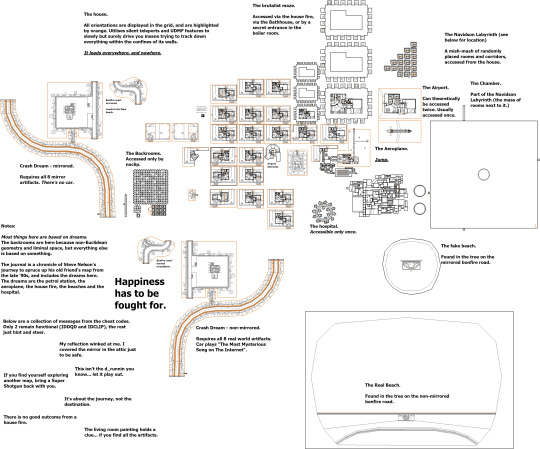
Among the map of the House, you might notice where, and what I've written. I won't spoil it. Delve into the file for yourself, see my 3AM ramblings.
You can see the main thing I latched onto, clear as day:
"Happiness has to be fought for."
And why shouldn't I? It's arguably the most profound message this map gives you. At the top, there's a small summary I gave about MyHouse, and its inner workings. Quote:
The house. All orientations are displayed in the grid, and are highlighted by orange. Utilises silent teleports and UDMF features to slowly but surely drive you insane trying to track down everything within the confines of its walls. It leads everywhere, and nowhere.
I know, chilling. right? Looking at the writings, you'd think I was only half there when I wrote them.
Probably the only other massively chilling thing is the message for disabling IDDQD (god mode for those uninitiated into the circles of Ye Olde Doom):
There is no good outcome from a house fire.
AND BOY, DOES IT SURE LIKE TO REMIND YOU OF THAT FACT IF YOU GO AHEAD WITH IT ANYWAY!
Ending 1 is the creepiest bit of the house's machinations. You trip the breaker, the lights go dark, and suddenly, you hear screaming from above you. Children, adults, who knows, all you know is that the air is thick with smoke, and they just keep screaming. You can't find them upstairs, so you check back downstairs, only to notice...
The walls have changed. The house is no longer wallpaper and carpet. The only thing remaining on the house's walls is the windows, and they show that even the garden has changed. Where there was plant life, there is now only stalagmites. Going to the boiler room shows you the garage door has returned... but it doesn't lead to the garage.
I'm leaving that there. If you want to play MyHouse.WAD for yourself, please, as a reminder, use GZDoom, not DOOM II: Hell On Earth. As much as the original was good, the WAD is just a bit too chunky for it to run in the original game. DOS software is only so powerful, after all.
#myhouse.wad#myhouse#doom modding#doom#doom 2 hell on earth#i think i just exported the image#so i couldn't tell you even if i wanted to#also this is a 2 year old post so a) i doubt i can remember what i wrote at 3am in 2023#and b) how are people still finding this post#shameless self plug: go read my guitar posts
150 notes
·
View notes
Text
Far shorter post, this time around.
Mostly detailing little ideas that I've had in the past few weeks, but have no idea how to go about them, or why I'd want to go about them in the first place.
Our first candidate is actually a mod I thought of: modifying a Jazz Bass to have 3 pickups. Now, sounds normal, right? Right up until I delve into the little bits. See, I had this thought after watching the R30 concert. From there, you can likely guess which bassist inspired this thought.
In short, this would be modifying a Jazz Bass (most likely a kit, modding a guitar you spent £2k on is not something I feel good about) to have a Rickenbacker neck pickup, most likely a high-gain, but a toaster would be good for those extra vintage tones. Now, people have generally noticed that specifically Jazz Basses and Rickenbackers have similar kinds of thud and twang to them. Hell, 44 years on, we're still arguing the toss about which songs Geddy used the Ricky and the J-Bass for on Moving Pictures.
As an aside, my personal opinion on that matter is that he uses the Ricky for Red Barchetta, and every other song on Side 1 is the J-Bass. Back to it, though, this is my basic comp idea for the thing:

I'd have done a better job making it transparent, but Word's Background Removal is good enough for the purpose I need it for. Anyway, this mostly stems from the large amount of similarity between the two basses, in terms of punchiness. The main difference is that the J-Bass has more midrange, while the Ricky has more low-end growl. That's my experience, anyway.
In my head, I've got a couple names for this, but the one that feels best is the Jazzbacker. Also, in case you're curious, I took the neck pickup and toggle switch (which I imagine would be mounted akin to a Jazzmaster or modern Mustang, with the toggle going parallel to the pickups instead of perpendicular) from an image of a vintage lefty Rickenbacker 4001 from 1980. Why is it lefty? For no better reason than Shits and Giggles.
There's also things I've had ideas for in passing, but not directly thought of as "Oh yeah, I'll do that!" For example, now and again I'll get the idea to build an 8-, 10- or 12-string bass, for reasons beyond my understanding half the time, but nothing ever comes of them. Sometimes, it pops in my head when I'm playing my bass, and try playing something like Jeremy or Achilles Last Stand (yes, it's written like that; I thought there'd be an apostrophe in the title, but no). As for why my first instinct is to build rather than buy, the reason 9 times out of 10 is that no one offers a decent option, no one offers the option at all, or they did and ended up discontinuing it later down the line. The 1 time out of 10 that none of those are an issue, the factor at fault ends up being money, or a lack thereof.
So, back to the matter at hand: what would I design this dual/triple-course bass to look like? On the one hand, I could be sensible, and go with a pre-established shape. On the other, I could do something incredibly wacky, like basing it on the Crusader. Or it could forever stay in my mindscape, never to be built. Who knows.
Now, you might be wondering why this isn't an addition to the Ideas Archive. Quite simply, it's because I can't be arsed adding onto that until there's a big enough change, such as, y'know, something actually being finished? No word on how long that's gonna take, aside from "it'll take as long as it'll take", which is probably the most accurate and least satisfying answer I can give.
Also, slight correction to the last post: apparently we were right in the first place??? For anyone finding me for the first time through this post in specific, the last post was an update on my scratch build, talking about how it started, how it's going, where we're up to, et cetera, et cetera. I mentioned how we ended up thinking it was iroko, because of the coarse and interlocked grain.
Yeah, uh, that turned out to be wrong. It was, in fact, mahogany the whole time. And to be honest, we should have expected this. A thing to remember about wood is that they can be used for a multitude of things based on the "quality" of the cut. If you're going to have an ornate piece of furniture, you're going to want high-quality cuts. The result of this, of course, is that the lower quality cuts, the stuff that might be a bit too difficult or annoying to work, may have an unappealing grain or something akin to those qualities, all those cuts get used for stuff where you won't generally see the grain.
Now, where would you not see the grain on something wooden? If it's painted over with a thick enough paint and varnish combination, of course! Where did we get these "low-quality" solid pieces of mahogany? From a 40-something year old door that was being taken out and being replaced. What do you do to protect a wooden door from the elements? You paint and varnish it.
So yeah, the wood was mahogany the whole time. The spec sheet has not changed, everything is as it was before March 14th. If we make any more progress, I'll make a post about it. Until then, have your fun. See ya!
#guitar#guitar building#lutherie#fender jazz bass#takosader's ramblings xv#fifteen of these already?#wow i do some yapping don't i#tw swearing#i think this is the shortest post i've made in the past year#which is impressive but also surprising#but yeah nothing gets set in stone with these projects#things are done when they're done#next post will be something more concretely related to rush probably#that's if i finish listening to every song and don't get distracted by specific songs... again#unrelated but the seeker and time stand still are both surprisingly good
0 notes
Text
Hey there, it's me again.
I feel like I should probably try and bump up the post average for the year, especially after the 3 month silence while I was working on the Lerxst post, so let's do that, with an update post on my scratch build.
The main question, of course, is where are we up to? Well, as of yesterday and/or today (not actually all that sure), the wood is ready to be glued together, after having chosen the pieces to be used on the Friday before last. Also, some might have been unaware, but I have had a long-standing specification sheet for this build, with my first saved iteration being last modified on November 3rd, but dating back all the way to October 12th.
So yeah, I've been real serious about this. Let's review, now that we're 5 months into the build. Keep reading under the cut if you want to.
Part 1: First Iterations
Where did we start? For that, we have to go back to September, when I was trying to figure out what the build was even going to be. At first, I was dead-set on building a Marauder Type II, albeit with some... modifications, such as a humbucker and a KAW Tri-Sonic instead of 3 Strat-style single-coils. But, on the last Friday of the month, when I went up to visit my aunt, more specifically when I was leaving, she posed me a question: do I really want to copy everyone else's design, or do I want to do something original? The specific wording was "do something original, don't copy someone else," but the question was clearly there either way.
Now, I do admit, that's a bit of a loaded question for me. I don't like copying, even if I do it quite a bit sometimes. Hell, I wouldn't have the TSR if I didn't do some copying. But this scenario was different. I wasn't working from a kit I could fuck around with and modify. I was contemplating a from-scratch build, out of what we believed to be actual, good quality mahogany. Nothing special like Honduran mahogany, and not entirely perfect stuff, because that would be old growth timber, and that doesn't generally get made into a door and frame, but it'd still be actual mahogany.
But here's the thing. All prototypes of the Marauder, types I and II, they were both made using alder, not mahogany. Why? Because it's cheaper. As I outlined in my post about him, Leo Fender was a cheap, frugal man who nonetheless still cared about quality. This is why people still get, want or have vintage Fender guitars - they're good quality for a relatively cheap price for a vintage guitar, especially when compared to, say, a vintage Gibson.
But that's getting off track. Back to my debacle, I spent the next week kind of mulling the idea over in my head. I started out simple on the ideas, looking at different guitars, seeing what I liked and what I didn't. My first idea was a mixture of the Gibson SGV and Burns UK Flyte...


...but I quickly nixed the idea. I thought about potentially doing something like the CS-336 (a variant of the ES-335 that has a single piece of mahogany carved into the back and sides), but also nixed that quickly, because it was far less "original", which was more and more becoming my aim. I kept coming back to the combination of Flyte and SGV, which I nicknamed "Squid Guitar with Demon Horns", but of course, this has defintiely changed.
I also had to figure out what join I wanted for the neck. There's a lot of stuff you have to consider, and there's 3 main styles for necks:
Bolt-on: screwing the neck on, using 3-4 large, long screws. Two subvariants of this style exist - neck plate, and threaded inserts. The former uses the neck plate as a distributed surface of pressure to clamp the neck into the pocket. The latter does much the same, except it stops the neck plate leaving an imprint in the finish.
Set-in: Using a type of glue to keep the neck in the pocket. The type of tenon can change the level of sustain that you get from the guitar, but needs to be done precisely to get the right neck angle.
Neck-through: there is no different between the neck and body. In effect, the neck is the body. The sides of the body are called "wings", and glued onto the sides of the body portion of the neck. This is also one of the hardest styles to get right.
At first, because it was going to be a Marauder recreation, I was thinking of making it a bolt-on, but then I moved to my current idea: a set-neck guitar. Partially, the idea was motivated by doing something original, but it was also the want of a new sound. I don't have a set-neck guitar, aside from my acoustic, and that's a sound unto itself.
So, by the midday of September 28th, I had my first idea laid out: the Squid Guitar with Demon Horns. It definitely didn't last, but it was the starting point I could work from. I knew I couldn't just do a neck-through guitar, due to the lack of material available to me, but that's all I had isolated, apart from the idea of a heel carve for upper fret access - quite like a Les Paul Axcess. Other than that, I couldn't think of anything for about a week.
I did some solid contemplation for the next few days, and on October 3rd, I came up with... this...
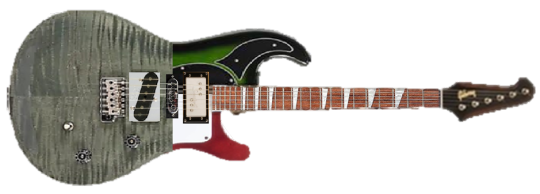
It... well.
I'm not proud of it, okay? It's shit. I know it is. What's shit about it? Well, let's go from the top - or rather, the headstock. It's a Firebird headstock, which is fine, and it's at least somewhat well-proportioned with the neck, though I cheated by actually taking the full neck of a Firebird. The fretboard is nabbed off of a Rickenbacker 360, because that's the inlay style and number of frets I wanted.
The pickups, meanwhile, are taken from 3 separate guitars: the neck pickup was a Wide Range humbucker snipped from the image of a Squier CV Starcaster on Fender's website, the middle pickup is from an MIK Burns Red Special, and the bridge pickup is nabbed from an image of an American Performer Telecaster. I later isolated the bridge pickup itself, but I already made the image, so I didn't end up using it.
My biggest fuck-up was using 3 different finishes. As well as using my entire brainpower to use the worst Strat-style body to ever exist, in Greenburst, of all things. God, that was fucking stupid. And if that wasn't enough, I positioned it against, of all things, a Burgundyglo Rickenbacker 4001. In case you don't know colour theory (and I'm not even going to talk about The Post), red is literally the opposite colour to green. And not only is it red against green, it's a black guard against a white guard. I'm actually impressed with how badly I fucked up with this one.
I also fucked up the body's proportions! If you want to have a frame of reference, I really give you one. The long and short of it is that it's too fucking long!!! I'd suspect it's like a metre long, aka Too Fucking Long. On the plus side, however, we fixed that with the template. But oh boy, I fucked it up something fierce at first.
I tried redrawing it, afterwards, at least.

Please note, I am a "luthier" (not cut a neck yet, I will remove these air quotes once I have), guitarist, and compsci nerd. I am not an artist. I can't draw. When I tried redrawing the guitar after this, my instinct was to go for tracing. The bits and pieces of images came in pretty handy for my redraw.
You can see here what my concept was for the electronics at first: a simple, 1 volume, 1 tone, with Red Special-style switches for each pickup. Yes, the Wide Range is 2-conductor only, that's why I chose it. I actually compared it to the Scarred Reaper that Trogly first designed by smashing a Les Paul and SG together like Ryan Jarman and Kurt Cobain smushed together the Mustang and Jaguar. If you weren't aware, the former, Jarman created the Musuar as a contrast to the design of the Jagstang done by the latter, Cobain.
Part 2: Deciding Specifications
From this point, I had my scale length nailed down: 25" flat, based on my recently newfound preference for slightly shorter scale lengths than I used to play, that being 25.5". That doesn't mean I don't play 25.5" at all anymore, the TSR is a 25.5", generally slightly more beef on the neck than your average Ricky. A Ricky generally has a 24.75" scale, so the TSR is slightly longer than a Ricky as well.
I also locked down a Very Important Detail: I knew I wanted a trem, because I don't generally like hardtail guitars, excluding the ones where a hardtail is the only option (like Telecasters, or 12 strings - both of which the TSR is), but I didn't know what to go for. I had multiple ideas, really, for what to use. From my playing of PRSes, I knew I liked that trem, but I had more recently played another of my aunt's guitars, a 1991 Hamer USA Centaura. The Centaura is a Superstrat (something I wanted to avoid in body shape, so I wasn't looking to it completely for inspiration) with a reversed headstock, sweet switch, HSS pickup layout, master vol and tone, and 24 frets with Floyd Rose trem.
This is what it looks like, by the way:

Quite refreshing to see this as opposed to a shitty composite and shittier drawing, eh? Floyd Roses are... A Thing. Okay, let me explain.
The issue with a Floyd Rose is that it's a double-locking tremolo system (that name stems from a mistake made by Leo Fender 70-something years ago), which means it's a pain in the ass to change tunings and strings. More to the point, it's also a floating trem. What that means is that you can't even quickly slip to drop D, you have to retune the entire guitar. Usually this means two or three runs through just to get the guitar in tune for drop D. Afterwards, if you want to get back to standard tuning, or go to a different tuning, you have to do those two or three runs again. And you have to do that every time you want to change tunings.
That soured the thought of using them specifically. That, and the cost to actually buy the systems in the first place. It costs at least £203 for a Floyd Rose Original. It's slightly cheaper to get a Schaller version, at £185. Kahlers, meanwhile, are right out, much like counting to 5 with the Holy Hand Grenade. Not only do they cost at least US$480, but due to being far less popular than Floyd Roses, there's not much in the way of a second-hand parts economy. It's a shame, because floating trems are really nice to play, and fun to mess about with. In this case, though, it's too much of a deterrent to actually be worth it, especially at those prices.
So that left me with 2 options: get a Kent Armstrong copy of a PRS trem, or get an actual PRS trem. Both would come with all the accoutrements for their fit and function, but one was in gold colour, and the other, nickel. The nickel one, funnily enough, just so happens to be the aftermarket Real Deal.
That was second to having the actual idea, and getting it down in proper form. But, what were the specs at first? Apparently. I was thinking some strange stuff, because the original variant had a 3-piece sandwich body of sapele-ash-sapele. With no weight relief. I swear upon my life, I don't smoke, especially not anything that would make me think of shit like that.
The updated spec sheet from November 3rd has little extra, but there are little specific details that differentiate it from the original. For one, I had sense to change out the central ash plank for a mahogany piece, as ash woods, including Fraxinus excelsior (European ash), are generally quite heavy with a lesser level of chatoyancy, with only an average of 12.8 using the Pisari-Zanetta-Codoro measurements. Yeah, that's peak nerdery there. People have developed a way to measure how figured wood can get. It's only an average, but it's a pretty damn good one.
Part 3: The Spec Sheets
So let's move onto looking at the spec sheets as they were when I saved them. V2 was last modified November 25th, so 4 days after the original Ideas Archive post. It's a damn sight cleaner as well, and was done mostly on the 22nd November, where I took a razor blade to the thing, and started making it cleaner by force. The 22nd is also when I did this:
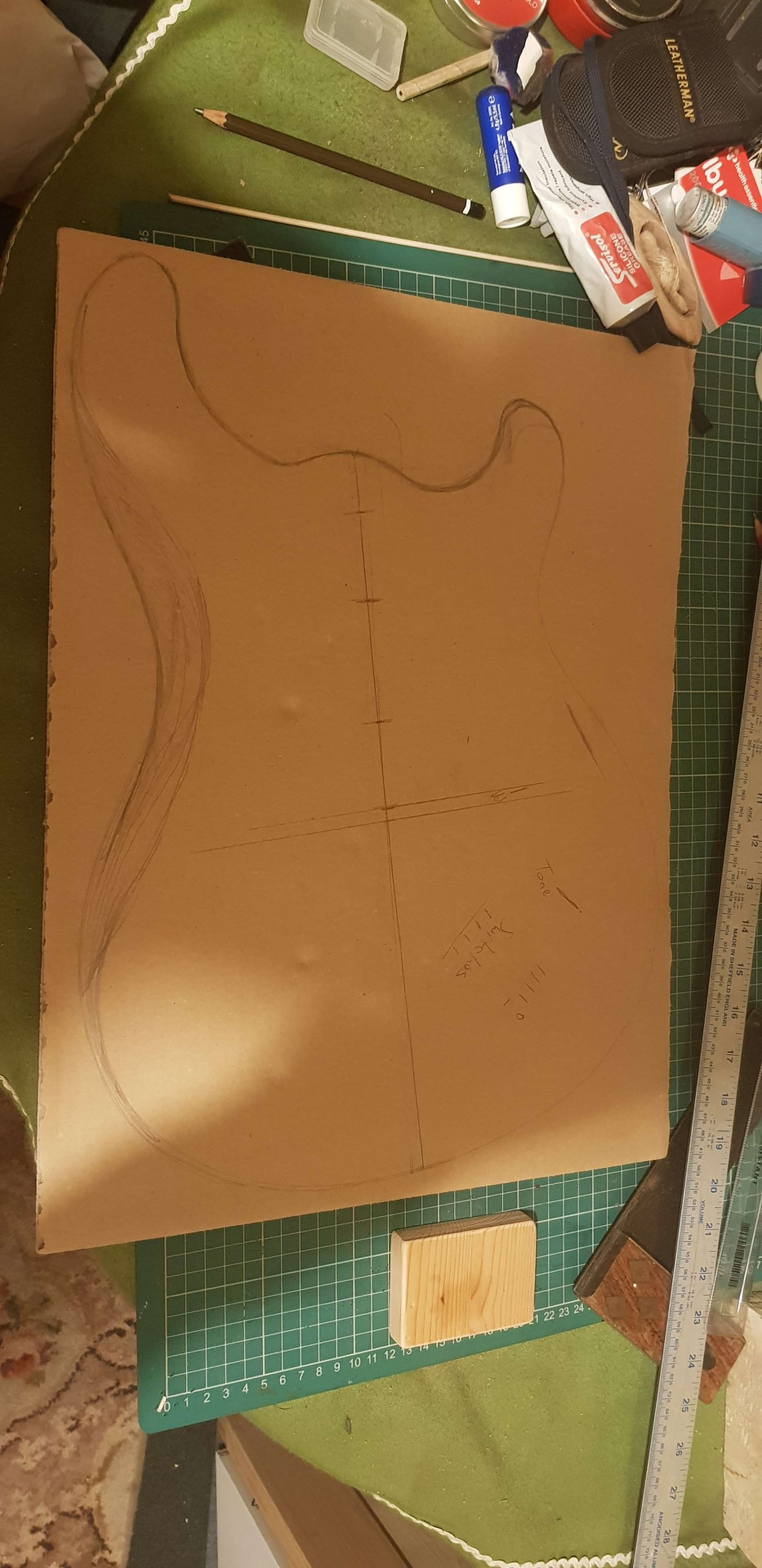
This is the original cardboard version of the design. Yep, CAD (cardboard-aided design) was used in the making of this guitar. This also shows something slightly different to the first sketch: four switches. Now, why four switches? It could be something normal, like a phase switch, or like the sweet switch on the Centaura. However, if you've followed this blog for any length of time, you know that what I do is seldom called "normal".
See, I had An Idea. Dangerous, I know, but it's generally not good to dismiss it without hearing it first. Anyway, this idea was something... interesting: installing a piezo pickup into the guitar. Why a piezo pickup? Because I want to do weird and strange shit with this build, and a piezo seems perfect for that. So, the idea was that I'd end up getting a piezo kit for this as well, specifically a Graphtech Ghost piezo saddle set and electronics kit, so I can have the closest approximation to acoustic while also being able to play with magnetic pickups.
And this was decided at some point between the 8th and the 22nd, though I don't know if I did it mostly as a Shits and Giggles idea, which then turned into "...hang on, that actually seems like it could be good," or if I did it like "hey, this gives me acoustic sounds as well!" It could have been both. Might have been neither as well, which feels just as likely as both. Some decisions I make are really, really weird.
One such example is actually the next decision I made: instead of having the Tri-Sonic straight, I decided on going for it tilted instead, matching it with the Tonerider pickup I got given. Interestingly, I know what the winding direction and the polarity is on the Tonerider, but the Tri-Sonic copy I'm looking at doesn't have its polarity listed at all. Which is a shame.
Why it's a shame, I don't have to explain, because I explained it 4 months ago, when I added onto the Ideas Archive, talking about the idea of making an Electric XII. If you don't want to seek it out, here's the long and short - there's 2 main ways of wiring pickups, being series and parallel, and there's 4 main ways that a pickup can be constructed, being CNU (clockwise, north up), CSU (clockwise, south up), ANU (anti-clockwise, north up), and ASU (anti-clockwise, south up), meaning there's a total of 8 ways you can wire a 2 pickup guitar, which I'm not going to write down here, because that's a lot, and just only 2 pickups. This would, technically, have four.
Now technically it doesn't matter, because I'm not trying to do it across the entire guitar. I'm only doing it between the middle and bridge pickup, the former being that RWRP Tri-Sonic, and the latter being that Tonerider Broadcaster pickup. What I have to hope is that the Tri-Sonic comes constructed as ANU instead of as anything else, because if it comes as anything else, it's going to range from "challenging" to "why" to change it to ANU.
Long and short, I'm going to try and turn this four pickup guitar into a three pickup guitar, by wiring the RWRP Tri-Sonic and Tonerider bridge pickup in series to make 2 humbuckers, with the bridge being Hot As Balls. Halloween, Turkey and Christmas will not be involved, but the jury's still out on School, though.
Part 4: Slow Goings
Now, I mostly made incremental changes to each iteration of the spec sheet, as and when I went up to work on the guitar. Version 4 adds the volute (that's the extent of the Gibson influences, unless you count the first designs having a Firebird headstock instead of a Hamer 6-in-line), and the price list, where I jotted down what I wanted to buy, and where I wanted to get it from.
To be honest, it's interesting that I even have a price list down for this at all. For the most part, the fact of a price list even existing makes me surprised. Consider it like this: you're sketching out ideas, and you've got everything down. You don't think it's going to go anywhere, not straight away, at least. And yet, here we are, already with a price list and everything.
V4 was last modified in January of this year, though, so I'm actually somewhat not surprised. Specifically, it was last modified 6 days after making this:
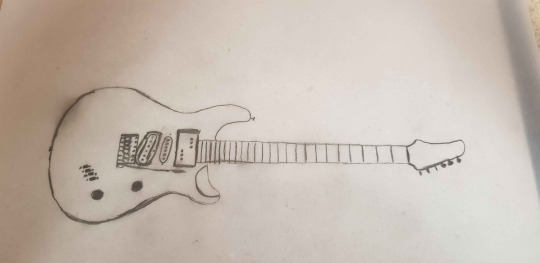
Yeah, you remember me saying that I went for tracing after the last time I tried drawing it? That was about this. This used 6 different source images, as well as a pre-loaded pickguard. I could tell you exactly how and what I used, but I could, just as easily, show you the original images:
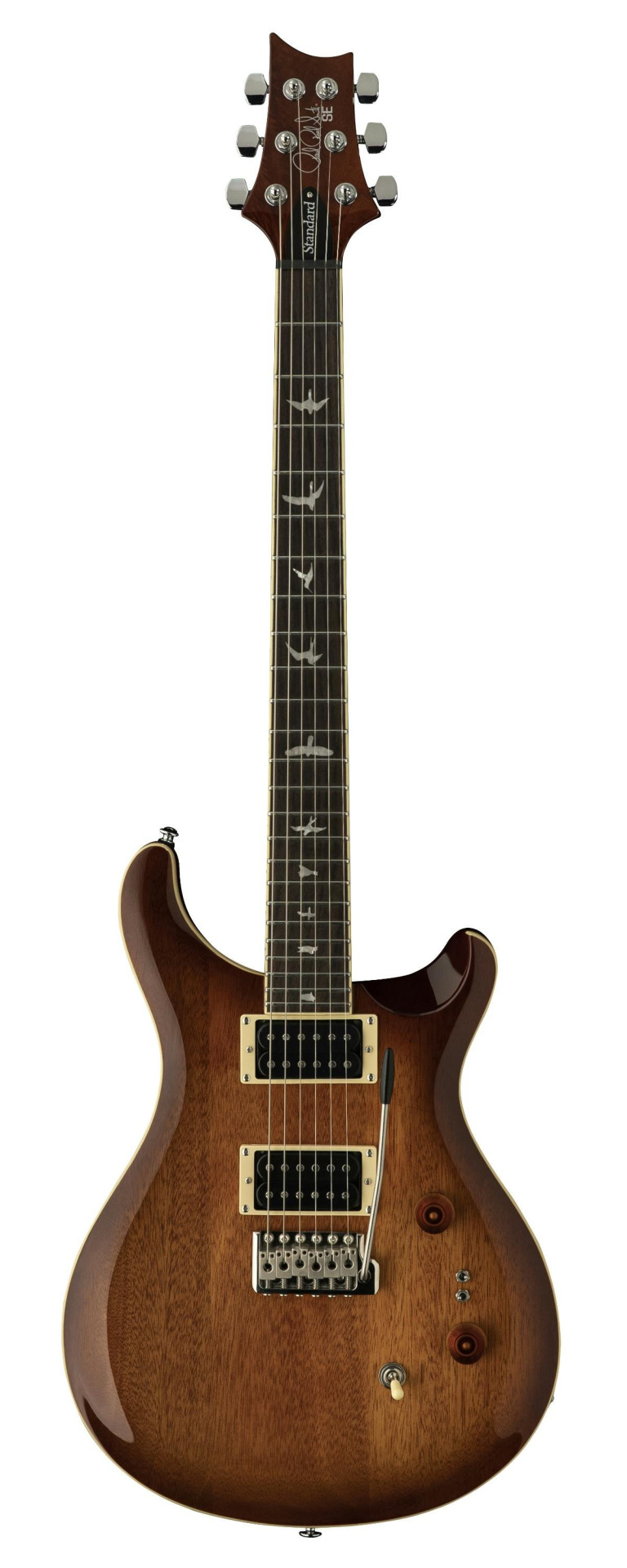
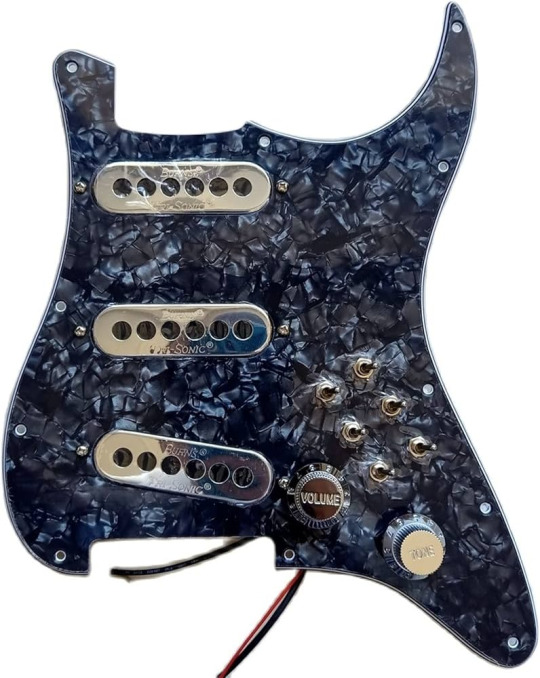

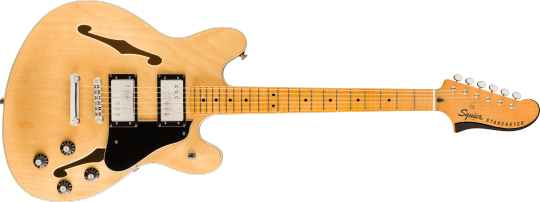
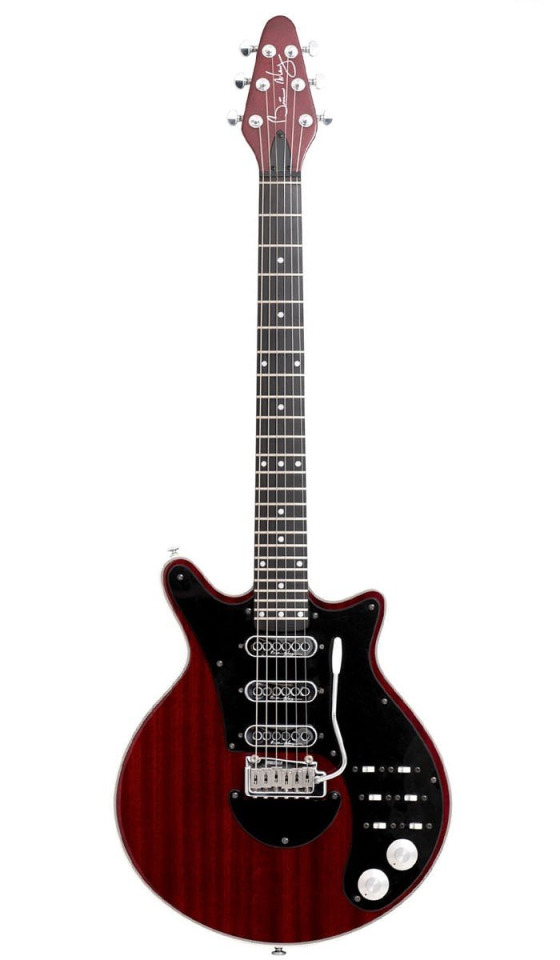

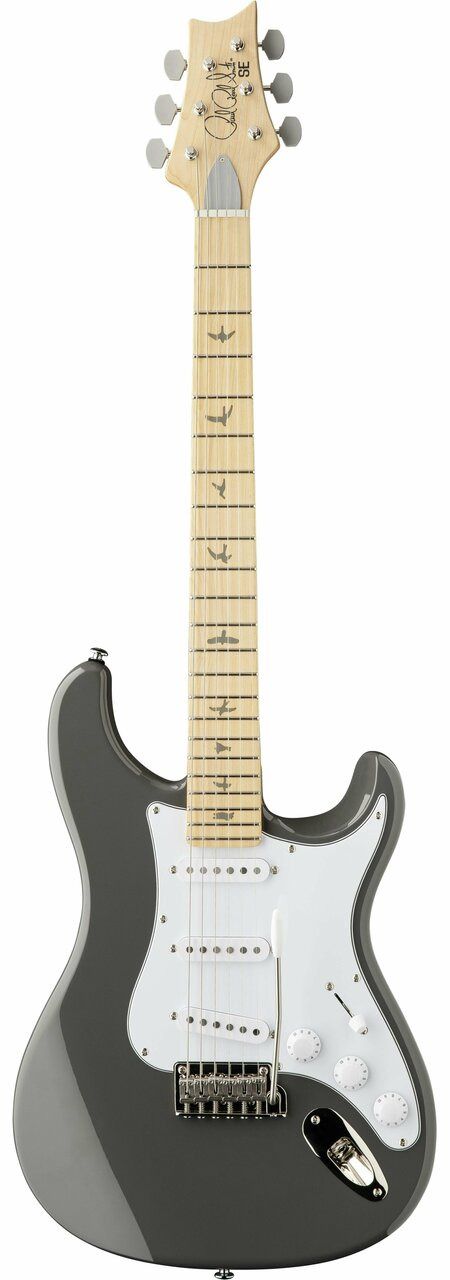
Small note: the Starcaster isn't the original source image I used, it's the one off of Fender's website. I chose the one off of the website because it's less clutter that way, as well as less space to scroll through if you're just reading and don't want to see the images. Also, side note, why does that pre-loaded pickguard have 6 switches. Yeah, I know it's to give you the same switching capabilites as on the Red Special, but he isn't the only guy out there who has used Tri-Sonic pickups. If you want examples, just look at everyone who's used a Burns guitar. There's plenty of examples right there.
Anyway, that was quickly transferred to a proper sketch pad, and coloured, with the results of both coming out like this:

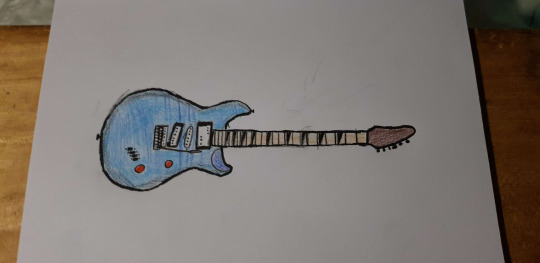
It isn't going to end up like this, of course; I don't think it's going to be offset, for one, and there were spec changes after I made this. That comes later, though. Let's go back to the actual build - how's that going? Well, the week before making this sketch (aka January 3rd), we got up to some shenanigans and, through the use of 3 mugs of coffee and plenty of motivation, did this:

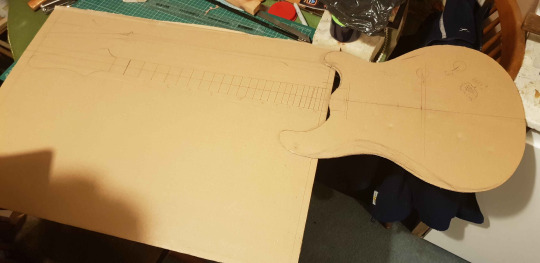
Yeah, see? Not an offset, and the return of Cardboard-Aided Design. Also the start of getting the MDF template sorted, which helps us with the production in ways that should be obvious. If not, the long and short of it is that, because this is a fully custom build, we can't entirely rely on prefab'd router templates, especially not for the body shape, which I could describe as "PRS But Wrong", or "Patrick Eggle Berlin Pro With Bigger Horn".
As you could guess, that Strat-style horn does wonders for the aesthetics. Related to that, you might want to know how we actually adapted that Monster of a design from earlier into something that actually looks like a guitar body. The answer is simple: we used guitars that my aunt has. That's actually where that shading came from on the cardboard version of the body - I wanted to mark that there was a comfort carve, but at the same time, it's just easier to know that there is one, because hey, I'm making this guitar!
Anyway, 2 weeks from that point, we cut out the MDF at about 0.5mm larger than the final size, which ended up looking like this:
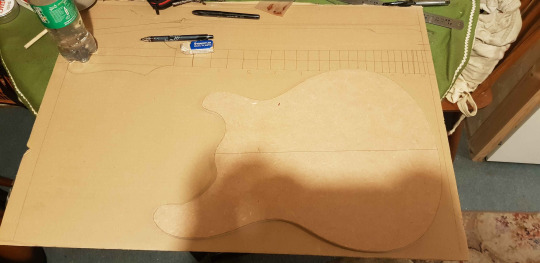
That's my attempt at drawing the fret spacing (and failing the straightness by a mile because I did it from the edge rather than the centre line), with the headstock traced from her second custom scratch build (a Telecaster Deluxe styled like the Hamer she had, which got nicked; her new Hamer was ±6 on the serial number, meaning it was built less than ten guitars before/after her original one, and she did not know this when she first bought it).
Anyway, from here, my next aim was figuring out what I could use. I knew I wanted it to slightly look like a PRS CE24, but I didn't know if I wanted to have a full carved top (like a Les Paul), a flat top (more like a Strat, Tele or SG) or the hybrid of the two, like PRS does. It's a long long story, and half of this guitar has been in both complete full form in my head, as well as unknown flux in a mental quantum superposition unlike anything I've ever done before.
For example, I thought I could simply do a perfect, normal, 1 volume 1 tone, with 2 potentiometers, and run everything through those. If you don't know how the Ghost piezo's electrics works, let's get straight to the point: you can't do that. They separate the magnetic and piezo pickups' volume controls in the documentation, but they didn't show whether that also included the tone controls as well. To rectify this lack of knowledge issue, I asked them about it.
I got a simple answer, saying that I couldn't use just 2 potentiometers, and that I would need to use more pots to have both a piezo and magnetic pickups. I didn't have much issue with that, mind, because it's hard to enjoy playing a guitar you've built, when that build doesn't work due to a fundamental flaw in the electronics.
Now, I don't really like a mismatched number of volume and tone pots, which is strange, because I like Strats. I like Superstrats, quite obviously, I like playing that Hamer pretty well, and the fretless does at least see some sonic action, but the issue is that Strats are... odd, in their designs. The contoured body is fine. The issue is the electronics, really. The first editions, up to 1975, got a 3-way blade that basically acted like a toggle switch on any of the 300 series that were +10 or +15 of the base model, so for 21 years, players were trying to lodge the switch in an attempt to get the 2 pickup tones like middle and bridge, before Fender relented and did 5-way switches.
That's kinda why I like 2 pickup guitars, and why I think the Red Special's pickup selection method is so cool: you get to choose exactly what you want, in whatever phasing you want. Teisco guitars from the '60s are much the same, as far as I know, and the same goes for Jaguars, Bass VIes and Mustangs, albeit with different switching methods, with the former using purely slider switches (except on the rhythm circuit which has mini-pots as well), which are mounted into a metal plate on the treble side, which is the same with the Bass VI, while the Mustangs use a 3PDT (3 pole, double throw) switch, which allows each pickup to be turned off, on, or put out of phase with the other pickup as you see fit.
Anyway, I'm rambling, let's get back to the point. By January 31st, I'd figured all this out, including what I wanted to do with the neck, which had otherwise taken a backseat to the body, mentally. There had been some general ideas there, sure, but this was the first time I had something solid in my head. My idea started off as just "mahogany neck with 24-fret maple fingerboard" but I didn't know what inlay style, what frets, or where the heel would come out.
I think this is why V5 lasted all of a week, from January 28th to February 3rd; that's the fastest it's ever changed, while V6 is the longest any version's lasted, nearing the better part of 2 months. Really, it's only lasted this long because I've been sticking closely to it. It's allowed me to clock what I like and what I feel needs changing. For example, I first thought I was going to leave the headstock face as the bare wood, but through the iterations, I've figured out that I'd do a headstock veneer of some wood or another, and match that wood with what I'd use for the inlays.
Also, neat tidbit about reverse headstocks: they need left-handed tuners! That means I'm far more limited on what tuners I can get, but I managed to find some (thank God that Fender sells aftermarket parts as well as instruments). Anyway, February was mostly spent figuring everything out, and getting ready to do shit. Amazingly, though, and I'm impressed it didn't get done sooner - it took until February 14th, a month and a half ago, to get the neck join properly decided on.
Y'know, one of the really integral bits? Yeah, took 4 months to properly decide on that. Now, the reason why we hadn't settled on it helps to make the amount of time look better, but the timescale is still ridiculous. So, the reason is that we had been going back and forth between neck-through and set-neck the entire time. The thing is, they basically act the exact same way; the sustain of one and the sustain of the other are basically negligible. This is the same reason why wanting one-piece necks is (and this is quite a controversial statement) a complete and utter waste of money.
Now, this isn't saying that they're not something to aspire for, it's just that they're not worth the effort you need to go through. People will say that the glue seam reduces the resonance and sustain of an electric guitar, which is why people want and covet those one-piece necks and bodies that were only possible years ago with such old-growth trees. The downside of such old and dense wood is that it weighs what can technically be described as An Imperial Fuckton (not to be confused with a Metric Fuckton, which is 0.984207 Imperial Fucktons).
But yeah, to put it in a way my aunt did, "if Paul Reed Smith can show me an oscilloscope reading of the differences, I'll agree, but until then, I'll just go with what makes it sound good". She's somewhat well-versed in the art of building guitars from scratch, having done it twice before. They sound good, as well, so yeah, I'm trusting her opinion on this one.
Anyway, the next time I went up was February 28th, which we spent just preparing wood for use in the guitar, separating small pieces from big pieces, and removing any mastic that might be on the pieces we want to use. As I think I've mentioned before, the wood that we're using used to be part of a door that got chopped up and separated into pieces of wood that we can use by my aunt. Main reason why I say "we" and not "I" is because she has her own idea for a build, but hasn't solidly nailed it down yet.
Anyway, it was at this point that we identified some of the wood as iroko instead of mahogany. Now, that's not an issue, the woods look similar, to the point of the former being used as substitute for the latter. However, that ignores the important differences between iroko and mahogany, which I left myself to figure out the next time I went up, on March 14th, 2 weeks ago.
2 weeks ago is also the point where the specs changed the most. How do I know? Because we couldn't find pieces of the mahogany door big enough to fit the MDF over without empty spots. However, this is where iroko comes to save us. I did some small research on iroko while we were getting bits of it straight and (somewhat) square, which leads me to my small tangent:
Mahogany vs Iroko:
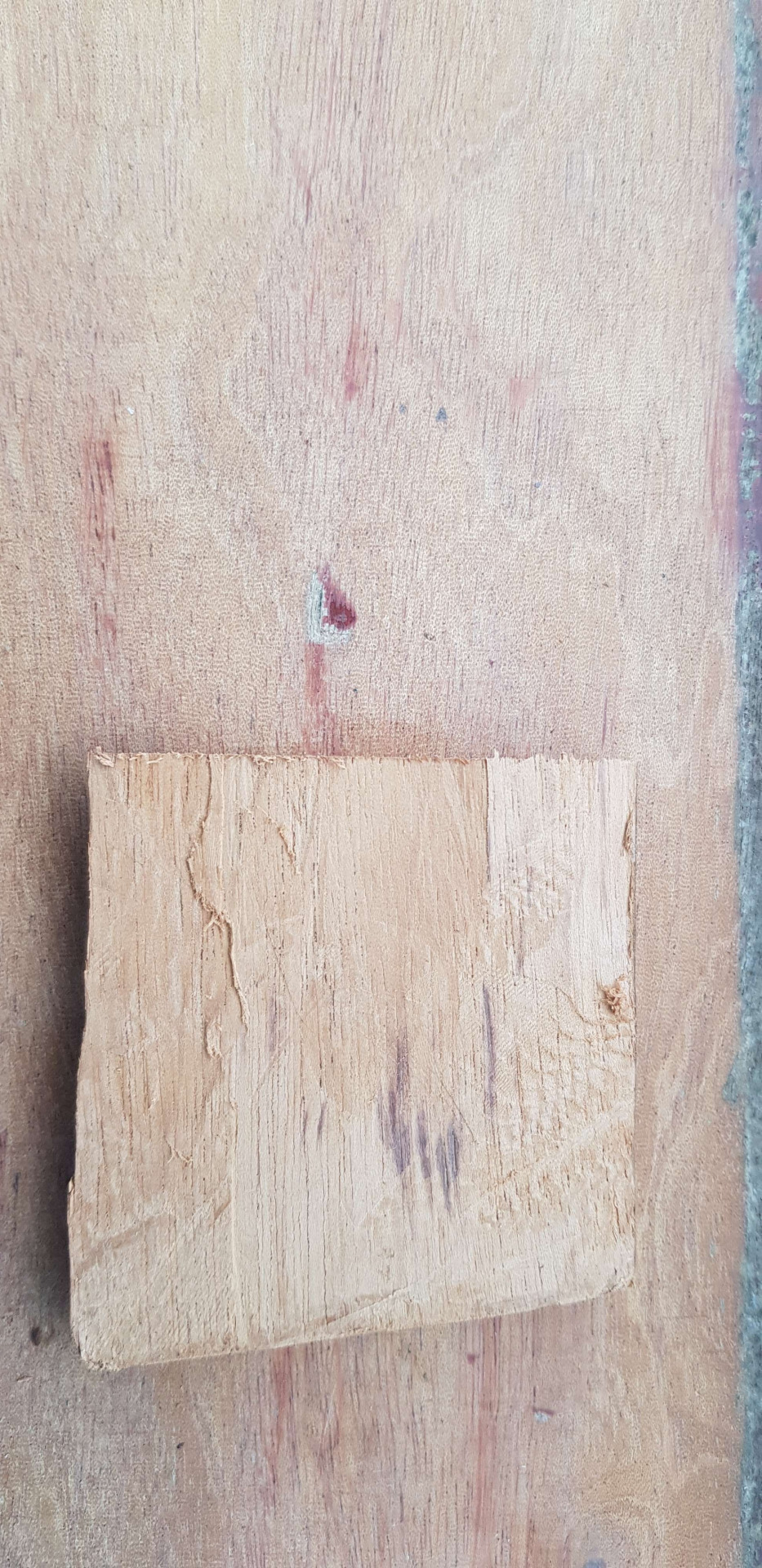
Small thing for the image: the wood under the offcut is mahogany, the offcut itself is iroko, just to show you the wood grains themself. Now, as a preface, there's 3 main categories I looked at: weight, chatoyancy and hardness. The weight is measured in lbs/ft³, the hardness in lbf, and the chatoyancy, I don't know the units for - they just give a "PZC average". As far as I can find, there is no actual units, it just takes an average, so that's what we'll use.
You may be wondering how the hardness is tested. Weight is a matter of taking multiple samples 1ft³ in volume, and measuring each one's weight then taking the mean of those. Chatoyancy can be measured by checking a wood's appearance in the light. Those are the easy ones. But how do you test for hardness, when the division of hardwood and softwood is otherwise entirely arbitrary? And yes, I am serious about it being arbitrary. Hardwoods are from trees with leaves, softwoods are from trees with needles. This doesn't actually account for the wood's hardness, and would otherwise look back-to-front to someone inexperienced with woods.
The answer is the Janka hardness test. The test, created by Austrian-born American scientist Gabriel Janka, was possibly conceived as a way to measure a wood's resistance to denting and wear, though the exact purpose of the test is unclear. Its results do not act as final arbiter, merely as the layman's guide to whether one wood is harder than another. In case you were wondering, yes, balsa is at the bottom of the list - twice, in fact; its average is 70lbf, but has been known to go as low as 22lbf on one sample, squarely in the comfortable range of a person's ability to press with a finger. Much like Spiders Georg, though, this was likely an outlier and perhaps not counted for the hardness average.
Anyway, how do they measure the hardness? This is done through the embedding of a steel ball measuring 11.28mm, or ⁷⁄₁₆" in diameter, halfway (5.64mm/⁷⁄₃₂") into the sample of wood. This is done multiple times, then the force of each press is collected, and the mean is taken for each wood subjected. It's quite interesting, and you might find the results interesting too.
Here are the results for mahogany (Honduran for ease of research)...
Weight: 33.74lbs/ft³
Janka hardness: 800lbf
PZC average: 21.4
...and the results for iroko:
Weight: 41.2lbs/ft³
Janka hardness: 1260lbf
PZC average: 21.8
The result is, the iroko is heavier and harder, with slightly more dance on average, than mahogany. The weight of this guitar is likely going to get influenced by the half-inch ash strips running between each plank of wood. That's by the by. We ended March 14th with the result that we were doing the guitar using iroko instead. That's the big change I was on about, and have been alluding to throughout this entire post.
That's not to say nothing has happened with the wood while I've been absent. Because I only go up once every 2 weeks, my aunt offered to help with the sorting of the wood, which I took her up on, and she's been busy on it. As we can see right here:
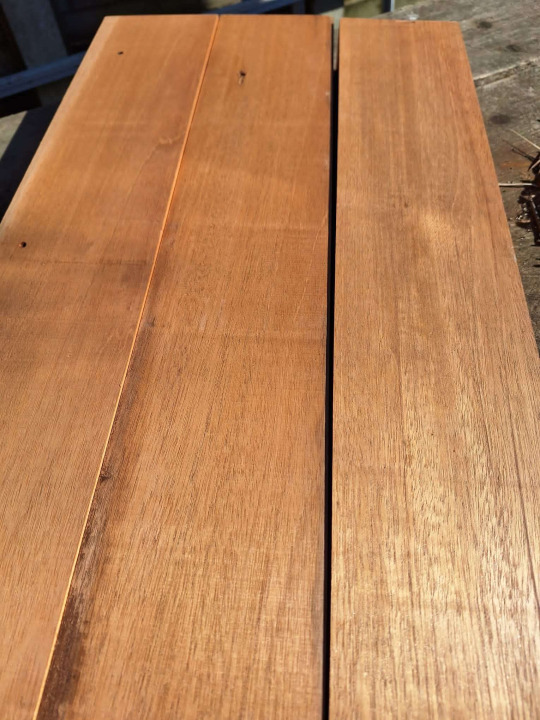
This image shows the wood as it was last Tuesday, planed, square and looking a damn sight finer than it was the Friday before. Now, the guitar isn't going to use all this wood. That'd be selfish. The idea is that we can eke out two bodies from this wood, and we can build our own respective designs from this. Also, to sate your (probably non-existent at this point) curiosity, the ash I'm using is English ash, the same stuff that Morgan car frames are made of (yes, they use wood to make the frames; they're a luxury car brand, what do you expect).
She also sent me this on Monday:

Must admit, she's a better artist than I, so it's easier to tell what this is - this is the back of the guitar. More specifically, this is highlighting the positioning of the ash strips in between the two pieces. She sent me this to ask whether I'd want the one on the left (the more traditional one), or the one on the right (deviation from the norm), to which I chose the one on the right.
As much as I like sticking to more conventional things when it comes to guitars (I don't know why people try and keep reinventing the wheel when it comes to this instrument), the left feels like it might make it look too much like a neck-through. I know it's silly, it's my guitar and such, but I don't really want to confuse someone into thinking this is a neck-through when it's a set-neck, especially when I'm using wood from the same tree for both the neck and body. That'd get confusing real quick.
And, well. That's where we're up to, really. I'm off to do more later (it's 00:40 as I write this), so I'll leave you with a couple more photos, and see you in the next post. See ya!
#lutherie#custom guitar#guitar#god that old design was SHIT#how did i suffer a critical colour theory failure#also yeah i know i used imperial units#it's kinda easier to use imperial for guitars#doesn't mean i prefer imperial tho#tw swearing#takosader's ramblings xiv#wonder how xiv would be pronounced#ziv? something like that? idk#burns guitars#prs guitars#gibson guitars#hamer guitars#rickenbacker#fender guitars#guitar building#hey two posts in the same month#that's kinda rare
1 note
·
View note
Text
Lerxst's Guitars: A History
Welp, new year, new post time.
This is gonna be a catalogue of the guitars Lerxst has used over the past 51 years, or at least as long as he's been playing with Rush. Most likely image source is going to be Juliens Auctions, supplemented with stage or promo photos as and when appropriate. Let's get started, shall we?
We start with the debut album, self-titled, released on March 18th, 1974, or maybe we start with the Debut Single released in September 1973. I would try to start with the latter, but a limited vinyl single release of 500 copies, total? Yeah, no, that's not exactly easy or fun to seek out. Regardless, one thing I can solidly say for that, Geddy's bass will have been the P-Bass, the one that got a Jazz Bass pickup installed right next to the bridge (and shaved into a teardrop shape, but we ignore that).
We're not here about basses, though. We're here about guitars. Starting out, we have the first ES he owned. Made in 1969, it was a tobacco sunburst ES-335TD, which, as explained in the Ideas Archive post, is an abbreviation meaning "thinline deluxe", which translates internally to "thin-bodied 2-pickup (semi-)hollow". Here's what a similar one looks like nowadays:

That one got purportedly got some major damage during the A Farewell To Kings tour, after a radial horn landed on it and his previous EDS-1275 from a suspended PA system. Yes, the Alpine White one wasn't the first, but also, I'm not surprised it was retired after that happened. Apparently it was just cosmetic damage, but I wouldn't be surprised if it damaged the body or neck in some way that affected the tone.
Anyway, the ES was used on the debut album, Fly By Night and (I believe) Caress of Steel. If you look at this, the 1975 promotional video for Anthem, included in the special features of the Rush In Rio live concert film, we see Geddy rocking a tuxedo Ricky, Neil doing his usual fancy drumming, and Alex rocking a particularly dark-finished mid-70s ES-335, most likely to say "this was done with a 335, so I'm playing it with a 335."
So, that's Lerxst's first Gibson - the first of many. Let's look at the next one - the Les Paul.

This Les Paul that he first got was a 1970 Norlin-era Standard. He bought it for the inaugural tour with the advance money from the royalties for the debut album (Geddy recounted doing the same with his first Ricky in My Effin' Life), and has returned to it so often it may as well be the workhorse for him. Oh, sure, the 355 was everpresent between 1976 and 1982, up until he got to using the "Hentor" 'casters, and those will be discussed today, for sure, but this one, "Stan" as he calls it, this was the common denominator.
This guitar is best heard in Overture. Yes, the intro to 2112. It also apparently makes an appearance on Prelude, the first part of Book II, which is intersting, because I assumed that was the 355 as well. Just goes to show that you're always learning something new. Anyway, as it's a 1970 LPS, it's 2 years off them being reintroduced (1968 for those confused) after being retooled into the SG body shape, which Les Paul asked for his name to be removed from.
On a related note to that, if anyone ever tells you that the SG is the only model that's never been out of production, they're a massive liar. For one, the ES-335 and its family has stayed strong since 1958, and the Firebird has done much the same.
Anyway, stepping slightly back, because I overstepped my bound talking about Hemispheres, Lerxst used the Les Paul and the 335 on those first four albums. But, you may recall, 2112 Part III is predominantly an acoustic number in terms of sound. And you'd be correct. There's 2 acoustics known for the 2112 album as a whole: a Dove 6-string and, delight to many a Canadian of the time, a B-45-12 12-string acoustic. Well, just the one - Gordon Lightfoot also famously used a B-45-12 during his career. They go for relatively cheap, and they have the artist attachment, so I'd go for one if I could, but that's neither here nor there.
There was also the cherry EDS-1275 I mentioned earlier. It does exist, you can find photos of him playing the thing, such as this one right here. But, as I mentioned, it got damaged after a radial horn fell on it. For those confused, this is what a radial horn looks like:

Other sources place it as just a speaker falling on the 335 and doubleneck, but I think it's more likely to be a horn specifically. Anyway, this cherry doubleneck got repaired and, around the time of Roll the Bones, it was gifted to Eric Johnson... only for it to be stolen from Eric a few weeks later. I think the doubleneck got bought at the same time as this other guitar:

This is an Epiphone CO60 classical, a model that up until researching this entire thing, I had never heard of before. And I call myself an Epiphone fan instead of a Gibson fan, despite knowing more about the latter. Anyway, this isn't that classical that was featured on A Farewell to Kings, it's just the one that he played on stage. The intro to the title track was recorded entirely in Wales, with Alex playing a different classical, Geddy playing a Minimoog, and Neil playing some bell percussion.
It wasn't included on the recording, but instead it managed to make an obvious appearance in the video for the song too:

This screenshot of the video is unedited, by the by, it actually looks like this if you look at it. It's admittedly kinda bad-looking, so I assume that whoever took the screenshot for inclusion on the Juliens Auctions website clearly didn't know how to do it well.
Now, the classical that was used for the recording, along with The Trees and La Villa Strangiato, was a 1971 Ramirez Studio he bought on the road from a pawn shop in Peoria, IL. It was listed for $700, and he figured it was worth way more than that, so he'd be getting a good deal for it. As stated, the Ramirez is confirmed to have been used for 3 total songs - AFTK, The Trees and La Villa Strangiato. Could it have been used for other songs? Sure, I guess, I just don't know any others that feature nylon-strung acoustic playing, and Broon's Bane was a live-only thing that served to segue into The Trees, and the Epiphone was used for that with a transducer pickup in order to play it amplified.
Now, we get to the Holy Grail of Lerxst's stuff:
Whitey, the 1976 Gibson ES-355TD

This is the guitar that probably comes to mind when you think of Lerxst as a guitarist overall. This was a custom order placed and a dream come true for him, having his own custom-built Gibson guitar, and it's so engrained in my head, I've come around to wanting to make my own replica of it, as tribute and celebration of its splendour.
To date, Lerxst has had 3 total Gibson signatures, plus 2 Epiphone signatures: a 2008 Memphis recreation of Whitey, a somewhat more recent ES-Les Paul Custom Memphis model, the Les Paul Axcess Customs featuring a Floyd Rose fitted with a GraphTech Ghost system (where do you think I got the idea?) for a piezo, and the previous and current Epiphone Les Paul Lifeson Axcess signatures.
The Whitey signature is what I want to try and capture, but... fixed. Remember my last post from last year? Y'know, me scrapping one Gibson signature replica for another? Yeah, that inspired... something, and I ended up listing every spec I could think of for a 1976 355, which also served to help as a reminder of what I'd need to source in order to accurately recreate it:
3-ply maple-poplar-maple "sandwich" top, arched, bound with 7-ply binding.
1-ply maple sides.
3-ply maple-poplar-maple "sandwich" back, arched, bound with 3-ply binding.
Maple kerfing, allowing the top and back to be glued to the sides.
Maple centre block, running up through the middle of the guitar.
Maestro Vibrola tailpiece, allows for "warble" effect when arm is pressed, due to string tension being relieved. If nut is properly cut and lubricated, tuning stability is 👌.
2x 1976 T-Top humbuckers, wound with 42awg polycol wire, equipped with either Alnico 5 or 3 magnets, gold cover over top of both. Neck and bridge at average of 7.6kΩ resistance reading.
3-piece voluted maple neck, with dual-action truss rod installed.
White-bound ebony fretboard with 22 frets and mother-of-pearl block inlays.
Standard Gibson "open book" headstock at 17 degree break angle (volute offsets effects).
Celluloid pickguard mounted by 1 screw at base of fretboard, and bracket mounted to side of body.
2 volume-marked witch hat knobs attached to 500K potentiometers supplied by CTS and 2 tone-marked witch hat knobs attached to 500K potentiometers supplied by CTS.
1 mini toggle switch to exclude the varitone chokes from the signal.
6-way rotary selector corresponding to 6 chokes mounted inside the guitar to filter out a certain band of frequencies.
I also added the stereo output jack to the list, because I didn't know if Whitey was a TDSV or a TD off the top of my head, but from what I can find, it was just a TD. Of interest is that, in the music video on YouTube, you can see that there's no mini-toggle, confirming that it was a mod done much later, later even than Moving Pictures, as it doesn't show up in the music video for Tom Sawyer. This has no specific point to be made, I just thought it'd be neat to mention.
Another thing that's actually important to mention, though, I can't be certain if Lerxst spec'd it out with tar-back Super Humbuckers, or the aforementioned T-Tops. I am, unfortunately, not lucky enough to own Whitey, meaning I can't check for myself, so I'm going with the more typical-for-the-era answer of T-Tops. Again, I credit my knowledge of this era of Gibson's guitars to Trogly, who I'd have effectively zero knowledge of the era without.
Unmentioned in my compiled spec list is the fact of the classic white finish and nitrocellulose lacquer, though I didn't miss off the celluloid guard that discoloured the finish and is commonly excluded from the guitar's appearances. Why? Precisely because it's a celluloid guard. Again, full credit to Trogly as my source for this info, but celluloid guards off-gas in the case if they're left attached, and will thusly eat through your gold hardware, make it go green, and do things that are generally considered as Bad Things for your guitar. The alternative is to get a plastic faux tortoiseshell guard, but that doesn't move like celluloid guards do, even if it is a pickguard that doesn't want to self-destruct for some reason.
Around this time, as previously mentioned, the cherry EDS was retired due to damage, and replaced with an Alpine White one, which got donated to the Canadian Museum of Civilisation in 2003 along with one of the Hentors, the Porkflapsocaster. For the uninitiated, that's the black one out of the three/four that existed, and that slash is there because I cannot for the life of me remember whether it's 3 or 4 Superstrats that he had. Wikipedia says it's four, but I can only find three of them.
This is serving as my transition into the Sportscasters, because there's no other way to be smooth about this. The 3 I can find are the Porkflapsocaster, which I've already mentioned the fate of, the white Sportscaster which got sold in the auction, and the D.E.W. 'caster. I can't figure out what the fourth one is, if there even was a fourth one in existence - Wikipedia is useful for some information, but depending on the article, the amount of information actually available is... variable. There's nothing on the fourth one that I can find, so you know what? Let's avoid all that bollocks, and just list as much as I know from memory.

The Hentors are named such because of the producer for the album Grace Under Pressure, that being Peter Henderson. Why Hentor? No clue, probably one of Lerxst's little jokes. But anyway, the three I can find all have consistent elements - they're all modified Fender Strats, in an HSS configuration, fitted with Floyd Roses and, sometimes, a locking nut, and the bridge pickup is always replaced with a Bill Lawrence L-500 lead variant humbucker. The fact that they're all modded Strats isn't all that surprising, considering that he was after that kinda sound, combined with the fact that Strats are generally good mod platforms, but the extent is the surprising part. You see, the blade switch was removed, with a 3-way toggle taking its place on the lower horn, like a Jazzmaster, the volume replaces one of the tone pots, making it a 1 volume, 1 tone kinda guitar, and the neck was swapped out for a "Shark" neck.
Now, after some research, and the phrase "Now, what that means, I have no idea." being written there as a placeholder for the better part of 12 hours, I figured out what that means. Shark was a company from Canada that functioned similarly to Schecter did in the mid-'70s, that being selling aftermarket parts for big-name guitar companies like Fender and Gibson. No PRS because PRS as an actual company didn't exist until 1985, but PRS himself (yes, he named his company after himself, it's not any different to Fender, Gibson or Epiphone) was building guitars around the time. From what I can find, his earliest-built guitar was made while he was at St. Mary's College of Maryland, some time in 1975.
Anyway, the necks that Lerxst installed were either left unfinished on the back, or were sanded down to the bare wood. I've no clue why he has them like that - maybe he prefers the feel of the bare wood, or something like that. Can't understand it fully myself, I prefer a satin/hard wax finish over "bare" wood. Fast-feeling necks aside, he also flipped the output jack, which is normally recessed on standard Strats.
Now, as mentioned, all 3 Sportscasters were modified in the same or at least similar ways, and 2 of them have modern recreations, courtesy of Godin. Lerxst worsed with Godin in order to recreate the white and red Sportscasters, the white's recreation named the Limelight, named for its original appearance on a Rush album (the solo on Limelight), and the red named the Grace, as a 40th anniversary celebration of its first appearance, the P/G album (that's Grace Under Pressure, if you're confused), and both guitars, as far as I can tell, are pretty accurate replicas, which makes sense - if you have the original guitar there as a guide on what to go for, then of course they'd be pretty accurate.
Other than the Sportscasters, Lerxst had an Ovation Adamas electro-acoustic used for the video and live performances of Power Windows, a Howard Roberts Fusion used mostly for the "playing live" aspect of Moving Pictures, and a 1979 Howard Roberts Artist Acoustic used for the recording of Different Strings from the Permanent Waves album.



Moving on, now we get onto the unique stuff. Why unique? Because here, we go onto a different short-lived Canadian guitar company: Signature Guitars. This one lasted all of... 3 years, from 1987 to 1990.

This was... not exactly his favoured guitar, at the time, as they were "awful to play - very uncomfortable". Presumably the neck shape was too radical a change for him to make. It could also be, and this is an interesting thought, that the necks were, in fact, finished to a shine, and not the bare wood, which Lerxst did say was his preferred feel for a guitar neck.
Then again, it could just be that the guitars were crap. More specifically, the guitars *felt* crap. The whole reason Lerxst stuck with them was for the sound. Those Signature pickups are VERY high output, as can be heard in this version of Tom Sawyer from the Hold Your Fire tour. You can also hear, and partially see, that he broke the high E on the one he was using for the song, causing it to have to be replaced at the end of the song so the string could be replaced and brought up to proper tension.
How can you hear it? Simple - there's loads more whammy usage at the end than would normally be warranted. A stylistic choice? No, you can see him pluck the broken string out of the Floyd Rose to get it out of the way. The excessive whammy use isn't him messing about with the trem, it's him fighting the floating aspect of the trem in order to keep the other 5 strings in tune for the rest of the end of the song. That's one of the downsides of Floyd Roses - they will go out of whack as soon as one string breaks, with another being the sometimes fickle tuning stability. It'll be playing fine and in tune, but it'll suddenly go flat on some strings and sharp on others.
Now, here's the other interesting thing about the Signatures, Lerxst was pals with the luthier that made them, Russ Heinl. So, presumably, as a favour to him, the guitars were used during the tour. Also interesting is the reason why the company was called "Signature Guitars": you could have whatever you wanted, text-wise, inlaid into the 21st fret, be it your name, or an in-joke or whathaveyou. You name it, you could have it inlaid.
An approximate total of 500 were made over the 3 years that the company existed, with parts supplied by either Godin or Larrivee, and Lerxst involved at every step of the process. The necks were designed to his hand shape, the radius specified by him - everything had some of his input. He and Heinl plotted out the design to the Nth degree using a permanent marker while sharing a pepperoni pizza on the floor of the former's home studio.
Or at least, that's the story. I did hear that he drew out the shape for the Signatures, but that's a moot point, because 3 years later, Lerxst would be playing a brand that's got some good solid guitars under its belt: PRS. Now, that's a very biased statement. The first high-value/level production electric guitar I ever actually held was a PRS, and there's a reason my scratch build is taking influence from a PRS in most elements.
That specifically, though, is neither here nor there. What is here or there is the PRS guitars that Lerxst used. He had 3 main ones: a 1990 CE24 he nicknamed "419" to commemorate the 3 flights he took with the 419 RCAF Moosemen squadron, a second 1990 CE24 that was fitted with a Signature pickup stock from the factory, and a 1991 CE24 that, because of its 24 frets, became his primary instrument for the proceeding 13 years.



Now, you may notice that all 3 were made in either 1990 or 1991. While yes, he bought them new (or had them made for him by PRS, as could be gleaned from the Signature pickup in the other 1990 one), it's also a great deal of good luck on his end, because in 1993, the neck heel was extended out by 1/2". Not too big on paper, but everyone apparently loves the old design, because it's less chunky, and PRS won't do it for you if you ask. Personally, it doesn't matter to me. Anyway, those 3 PRS guitars were the guitars that comprised their output from 1991 to 2004.
419 made its debut as one of Lerxst's guitars during the Presto tour, while the Signature PRS was used as a backup for it, unless he wanted a certain sound, I'd guess. The '91 PRS, however, that can be heard on Roll the Bones, Counterparts, Test for Echo and Vapor Trails. It was kinda ubiquitous in that era of albums. Also from this era, a duality of Fender and Gibson, something that some would consider sacrilegious. When the Gibson was used for solos, the Fender, a 1990 Strat with a flame maple neck and a really interesting pickup combo: a Zexcoil (no, not a Z-coil, a Zexcoil, though I did think it was called a Z-coil at first, like the G&L pickup - I guess the weird name is to avoid confusion or something) in the bridge, an Evans Single Coil "Humbucker" that's actually a noiseless pickup before they were properly called Noiseless coils, and a standard Strat single coil in the neck.


As for the Gibson, that wouldn't be bought until 1993 for the recording of Counterparts. That was used for Stick It Out on the album, and for heavier songs when playing live. What he meant by "heavier songs", I'm not sure, because they didn't really do "heavy songs". It mainly appeared live on the tours of Counterparts, Vapor Trails, the R30 tour, Snakes and Arrows, and the Time Machine tour. R30 is very interesting - it's the first time they actually acknowledged the anniversary "publically". Sure, they would have been celebrating it between themselves, but it was the first time it happened outside of that, as far as I can tell.
There's a couple final guitars for the '90s, and they're not all that special. The first is a 1992 '58RI Fender Strat that Lerxst used on Dog Years from Test for Echo.

It wasn't used live, it was only used to record that song, and some little casual demos post-R40. Nothing else that I can find. The other is a 1976 Ovation 1863 Classical, which sounds confusing, I know.

Let me try and explain it - 1863 is the model number, and those 4 numbers are how Ovation distinguishes its models. This is apparent when you look at other models. For example, you might have heard of a Ovation 1615, or a 1658. Those are 12-string electro-acoustic models. They're sometimes called the "Pacemaker" or "Custom Legend", but their main model numbers are 1615 and 1658.
Why do they do this, and not have simple names like their current contemporaries? Well the unorthodox bit is the entire element of their branding. You see, Ovation is a relatively recent addition to the Big Guitar Brands, mainly for their unique style, which goes against the general tradition of acoustic guitars. Their "Roundback" guitars, what would more commonly be called a "bowlback" if it was on a lute or mandolin, use something proprietary, called "Lyrachord", which is effectively a composite fibreglass made to withstand basically anything you can throw at it.
Why do they use it? How does it do that? Well, the answer to both questions is simple: they were made at the behest of amateur guitarist and helicopter designer Charles Kaman. This, of course, needs further explanation. When his company's commercial flight division had financial problems in the early 1960s, they were forced into new markets, such as entertainment and leisure. Kaman, of course, wanted to look into making guitars, so he put together a team to invent a new type of acoustic guitar.
Believe me, I do mean invent. Proper acoustic bowlback guitars have never actually existed since the invention of the guitar - generally, the bowlback shape was used for more ornate instruments like lutes, theorbos, angéliques and archlutes. The closest I can actually think of are archtop guitars, but they use, as the name implies, arched tops, as well as arched backs, making them constructed more like a violin than a guitar. Bowlback instruments, outside of those heavily affected by string tension over many moons, generally have a flat top and a large bowl-shaped back (see where the name comes from?) that serves to project and convey the sound at a greater volume than a flat or arched back would. But I digress from our tangent's topic. Back to said topic, most of the team that he put together were aerospace engineers and technicians, and several of whom were woodworking hobbyists as well. One of the techs, Charles McDonough, was the creator of the Ovation Adamas, a subset of Ovation's models featuring a carbon-fibre top, and one of which Lerxst used for Power Windows, as mentioned previously.
Anyway, Kaman founded Ovation properly in that small period of 1964-65, and set the company's engineers and luthiers to work, the goal being to improve the design of acoustic guitars by changing the conventional materials. Honestly? I think they did well with it, and Leo Fender would have gotten along swimmingly with Kaman, had he not been working under a non-compete at the time. Anyway, the R&D team spent most of 1965 testing prototype after prototype, with the first having the shape and dimensions of a traditional dreadnought acoustic body, with parallel front and back, and the bent sides. The point of innovation with it, though, was that they had used a thinner, synthetic back because of the acoustic properties. However, there was an issue: the seam joining the back to the sides was very prone to breakage, so they needed to solve that problem.
Then the engineers proposed the roundback parabola made of a synthetic material to avoid the back seam problem. In theory and in practice, this causes an increase in projected volume from the soundhole. How? Because the parabola bounces sound waves in such a way that they are directed towards the sound hole. This isn't a joke either, because if you look at the calculations, they support this. The back is constructed in such a way that the sound waves project directly towards the parabola after one or two reverberations.
Of course, now they had the design, they needed to find the right material. It had to be cheap and easily available, lest they face financial troubles for selecting a rare and expensive material, strong and sturdy enough, and have good acoustic properties. What they came up with was the Lyrachord that I mentioned at the beginning of this tangent. Lyrachord is a standard fibreglass composite consisting of alternated layers of bonding resin and layers of glass filament. I'd use the wording from the patent, but fuck that, the wording's weird, and I'm not sure I can use the specific word. I'll just link the original patent here in case you're interested.
Anyway, this whole tangent was to explain why Lerxst's Ovation had such a weird description. TL;DR? It's weird because Ovation as a company is weird from a guitar design standpoint, what's one more thing to add to the pile? Back on topic, this Ovation was used for both the R30 and R40 tours, to play stuff like Broon's Bane, The Trees (for which Broon's Bane is a segue), and Natural Science, meaning basically anything that involved a classical guitar. The exception is A Farewell to Kings, which wasn't played on either tour.
Moving on from a guitar that made me give a miniature explanation of why it exists, to one that needs little to no introduction, we have a 1994 Fender Custom Shop Nashville Configuration Telecaster, hereafter referred to as a Nashville Tele:

What's Nashville configuration, you may be asking? It's a Stratocaster middle pickup, in a Telecaster along with the usual neck and bridge pickup. Now, the next and most obvious question is "Why is it called a Nashville Tele?" and the answer is just as obvious - it was a popular mod done by session musicians in Nashville.
Now, this Nashville Tele was further modified on request of Lerxst by his guitar techs, but this is an arguably quite easy guitar to recreate, as it takes the neck and middle pickups from a Strat, and another one of those Zexcoils, this time configured for use as a Telecaster bridge pickup, meaning it has the baseplate rather than being a self-contained unit, which is why they did the whole bridge plate assembly. Speaking of, this one is a 6-saddle, as opposed to the standard 3 "barrels", for the more accurate intonation.
But you're most likely not here to know how easy it is to recreate, you're here to know about it in relation to Rush: where did it get used? It got used for the live versions of Bravado, off of Roll the Bones, among others. What songs those are, I've no clue, because Juliens doesn't list the songs it was used for. Now, I'd normally be understanding about something like that, because an auction site doesn't have to have everything about something like that. This is my exception, because they say, and I quote, "Stage-Played, Photo and Video Matched". I will be nice and give them the benefit of the doubt, though, because that could just as easily mean "we used officially-released media to determine that this is real." Point is, I think it's a shame they don't list nearly as much about what songs it was used for, compared to the semi-basic condition report and feature list.
Now then, we've had one white EDS-1275, yes. But what about a second white EDS-1275? Remember when I was talking about the Porkflapsocaster, and I mentioned that the first white EDS-1275 got donated to the Canadian Museum of Civilisation? This one is the second of three white EDS-1275s that Lerxst wielded in the 40 years that Rush was a band in general. This second one was the first of many Gibson guitars to start his trend of custom truss rod covers. This one, starting us off simple, is a pair of gold-coloured (most likely brass) truss rods with his name in fancy-ish lettering - a small and simple gesture to start out with.

Also of note here, unlike the first or second EDS models that he owned, this one has gold-plated hardware. Now, I can't say whether that's better or worse than nickel or chrome-plated hardware, but some would say that one of those three are better due to them wearing in different ways to each other. My personal opinion? Go with whatever the hell you want, they serve no purpose aside from being varying levels of flashy. Anyway, this EDS was used, as all of them were, for playing Xanadu, but also for playing some of the stuff off of Vapor Trails, and was used for every performance that required its presence between 2002 and 2013. Considering how often Xanadu got played, that meant it saw a lot of action!
Moving on, I'm breaking from the Juliens order, and talking about a 2004 goldtop reissue that Lerxst used for R30. Why am I breaking the order now? Because this is Lot #68, whereas Lot #67 is a 2008 Les Paul. Now, why's this important? Because up until this point, the guitars have been in chronological order, which makes it kinda annoying to see it crop up while we're on R30 still - this one was still pieces of tree when R30 was going on. But that's by no means important here.

Back to the goldtop, it was used a lot throughout the R30 setlist, for songs such as Subdivisions, Earthshine, YYZ, and Secret Touch, as well as on The Main Monkey Business during the R40 tour. Apparently Lerxst was so enamoured with the goldtop finish that he went onto get 2 more of the things. We'll come back to this later, so for now, let's move on.
The next thing on our list is a... 2002... Les Paul...

... ... ... ... ... ... ...wait a sec. 2002?! Okay, who compiled the order for the lots??? This should be in the position of that 2008 LP! I am being deadly serious here, this is a very silly order we've seen, because it goes in the order of 2002 -> 2008 -> 2004 -> 2002! What kind of chronological order is this mess?!
...upon further review, it appears they just gave up on the chronological ordering at this point. Fantastic, that makes my job twice as hard. No matter, let's follow this along as best we can. So, 2002 Les Paul R8 Reissue - if you weren't aware, Gibson Les Paul reissues can be said as either the year of reissue ('52, '54, '56, all the way up to '60), or as the letter R followed by a number designating the year (R2, R4, R6, etc.), though both mean the same thing. Most commonly, you will find R7 through R0s, reissues of that peak of golden era Gibsons where they figured out the humbuckers, with the R0 also including the slimmer-feeling neck, what Gibson calls their "SlimTaper C" neck.
Anyway, this one was finished in tobacco burst (the difference between tobacco burst and vintage sunburst is the red in vintage not being in the tobacco burst), but not given the Full Burst treatment, which would involve the back, sides and neck all being finished in that same burst pattern. That's usually reserved for the Custom Shop, so it makes sense. And before you ask, no, I don't know why a full finish and historical accuracy have to be left in the higher price bracket. Gibson's stuff is overpriced as is, it's not worth contemplating this stuff.
Back to the guitar itself, "Brownie", as it was nicknamed, has 3 pickups: 2 humbuckers, and a piezo in the bridge. I wish I could get a closer look to see what piezo it is, but alas, the main downside with using Juliens for all the images (not that there's much upside) is that they are REALLY zoomed out. You get full body front, full body back, headstock front and headstock back. Nothing else, apart from with Whitey, which gets body shots because of the celluloid guard, which I've explained in its relevant section. This displeases me. Greatly. I will say, it'd be better if I could get proper photos, but that would require tracking down where every single guitar went, and I have neither the time nor the patience to do that.
Okay, back to Brownie, it was used mostly for The Camera Eye, and was played during the Vapor Trails and R30 tours. Sorry about the many detours and distinct lack of actual info here, I wish I could give more, but there's basically zero real information here asides from what it was used for, what tours, and the fact that it exists. I can't solidly say which pickups it has, though it's most likely to be the Burstbuckers (I just realised they're called that because they're replicas of pickups from a 'Burst LP from the '50s), at least that's from what I can find on the internet at large. So y'know what, let's move on again. I feel like it's just going to be easier to keep it moving rather than trying to get everything right and exact.
Next, a 2006 SG Custom that was, reportedly, used as a studio instrument. No record of what it was used for, like, but whatever. Here, I see the first record of Juliens being factually and completely wrong. You see, because they include photos of everything, you can check what they said about a certain guitar, check that everything is being sold as-described. They said this SG Custom has a Sideways Vibrato. Let me just fetch the image...

That's not a Sideways Vibrato. That's the Maestro Vibrola, distinguishable by the fact that the Sideways Vibrato doesn't have a bent-metal plate. It works like a Kauffman, like I said in the Ideas Archive. That is, quite clearly, a Maestro, and they got that fact flat-out wrong. No beating around the bush, no benefit of the doubt, that's wrong. This is easily-checked information. Hell, they had Whitey to check it against!
Moving on from that terrible disappointment, this is a non-traditionally wired guitar, in that it has the three-way matching the poker chip: up means neck, middle means both neck and bridge, and down is bridge only. You blend in the middle pickup using its respective volume knob. Why is it non-traditional? Because traditional wiring for Gibson means 2 volumes, 2 tones, and a 3-way toggle selecting neck, middle and bridge out-of-phase with each other (bridge still in phase with neck), and bridge alone.
To avoid getting annoyed further by this poorly researched bit, I'm going to go back to Lot #67 and finally talk about that 2008 Les Paul, which was given the nickname "Cheri" because of its cherry sunburst finish.

This one was used for the 2008 leg of the Snakes and Arrows tour, the Time Machine shows, and the R40 tour, usually for stuff like Workin' Them Angels and Spindrift for the former, and Jacob's Ladder for the latter. It also has a piezo pickup installed, like Brownie up there, and is modified with a 2-jack output plate, like Brownie, and every Rickenbacker since God Alone Knows, excepting of course the solid top 325 Capris from the first run, which have a double-jack plate, but only the one jack. In the same vein as Rick-O-Sound, Lerxst's system for these is called "Life-O-Sound", though unlike the Ricky, it's not stereo output, it's magnetic and piezo to different jacks. As for the reason for the name, blame Gibson, they came up with it.
Moving on to our next piece, a 2007 Garrison 12-string acoustic, used almost exclusively for the acoustic solo, "Hope".

Not only was it used for playing the song live, it was used to play the song in the studio. It was mainly used for the sparkle from the piezo, which makes sense, because even by piezo and 12-string standards, when you hear the live version of Hope, you hear how sparkly that thing is; it's like the night sky personified as a sound. I'm not talking a city's night sky either, I'm talking the full shebang that you get when you're out on the moors and similar, far away from all of the bright LED streetlights.
Deviating again from the established order, we have "Lil' Al", Lerxst's first Floyd Rose Les Paul.

Now, Gibson purists will hear that and think, "A Floyd Rose?! On a Les Paul?! No! Get rid of it!" Norlin fans would be warmer in their reception, but only because later Norlin guitars, such as the ES-347, and even some Les Paul Customs, came with Kahlers fitted as stock, including the Gibson branding. As for the fans of the Henry Juszkiewicz era (more commonly known as the Henry J. era), well they're all for it, the Les Paul with a Floyd Rose was an invention of that era.
Personally, I distinctly lack a horse in the race, much like how I don't care about the PRS heel debate. Guitars are guitars, and guitars get played. The way they look has no effect, but they way they play is incredibly important. They need to play well. That's why Lerxst wasn't a fan of the Signatures, he said they didn't play well. Back on topic, Lil' Al was used to play Tom Sawyer live on the Colbert Report, as well as during the Snakes and Arrows and Time Machine tours. It also appeared in I Love You Man, that rom-com bromance film from 2009 starring Paul Rudd and Jason Segel being massive Rush Fans, with the guitar used to play Limelight during the final scenes of the movie.
Notably, it's also got a custom heel carve, similar to an Axcess' heel carve, but it's not the same shape between examples. If I were to describe it, it's more akin to a clean sine wave shape, as if it was made by following a line, rather than a more exaggerated dish carve, like someone taking a chisel and making a bowl out of it. It looks cool, regardless of that. With the shape, you can actually make out the seam like between neck and body, something much harder to do on a guitar we'll come to much later.
For now, let's follow the chronological timeline, which leads to a beautiful example of PRS' style of innovation: a 25th Anniversary Swamp Ash Special, complete with the patented trem (with knife-edge plate and pivot-milled screws), and 3, count 'em, three Narrow Field humbuckers.

If you're confused, the Narrow Field humbucker, normally just shortened to NFH, is much like the Gibson mini-humbucker, designed in a certain way to marry the positive features of a humbucker (fuller sound, distinct lack of mains hum), with the distinct tone and chime of a proper, well-made single coil.
Most people argue over whether this has a noticeable effect on tone, whether the pickups actually sound like single coils or not, but it's otherwise a very nice pickup, and the 2010 SAS 25th isn't the only thing they got used in, considering the existence of the NF3 that recently got reissued onto the SE line-up. I could explain the PRS tiering, but it'd be way too long, and it's not the focus of this post. Maybe another time.
Anyway, this PRS was used mostly as a backup for the Teles and Strats that Lerxst played, which actually means it wasn't used nearly as much as any of the other guitars discussed here. It did get used, however, and I'm not surprised about it in the slightest: PRS guitars play beautifully, so one becoming a permanent case queen would just be wasteful, and a right shame.
Moving on, a reporduction of one of Gibson's classic jazz boxes, the ES-175D.

As mentioned at the VERY beginning of this post (and like... 3 weeks ago), the meaning of the letters after the model identifier was explained in the Ideas Archive. No, I'm not going to include what it is, go and find the Ideas Archive post, and learn it from there! It's literally my pinned post. Anyway, the ES-175 is a classic jazz box of the early Gibson line-up, albeit fitted with pickups. Originally released in 1949, it came fitted with one P90 pickup with the poles around an inch to 1¹⁄₁₆" from the end of the fretboard. Now, when I say "end" there, that does include the binding as well as the wood, so it's slightly longer than an unbound fretboard.
Then, in 1953, the year after Gibson introduced the Les Paul, they introduced the "deluxe" version. In the grand scheme of things, this isn't very important. Both have a floating bridge, 20 frets and a sharp Florentine cutaway, as opposed to a Venetian cutaway, which is softer. 1957 rolls around, they get fitted with humbuckers rather than P90s, though they keep the 20 frets and floating bridge, and they stay... mostly unchanged for the next 60-65 years. The only exceptions there are the Norlin Era models using 3-piece voluted maple necks rather than a one-piece mahogany neck, with the large "boat paddle headstock" (That's why they're called boat anchors! Now I get it!), instead of something more reserved, like what they went back to in the Henry J era.
Anyway, Lerxst never actually used this for a Rush album or concert. Instead, it was used for smaller, local gigs. Much like the ES-335, he called it unusual for a rocker to play, but play it he did, regardless of how weird it was. Then again, another big rocker known for playing a 175 is one Mr. Steve Howe, whose most favoured guitar is a 1964 ES-175, fitted with two Patent Number pickups. Small note about Patent Number pickups - they don't have the actual Seth Lover patent number. The PAF patent number, when granted, was US2896491, otherwise written as Patent No. 2,896,491. However, the patent number used on the baseplates is instead US2737842, also written as Patent No. 2,737,842. What's that patent? Les Paul's patent on a large wraparound tailpiece similar to that used on original 1952 Les Pauls. I would show an image, but I'm at 28/30 images at this point, so I'll hyperlink it instead.
Back on topic, I'm using up my last two images now to introduce you to the biggest and most important guitars that Lerxst used: Keith, and Blackie:


No, I don't know why the image sizes are mismatched either, and frankly, at this point, I don't care. These two guitars are of the same make and model: the Gibson Les Paul Axcess Standard. Now, that's a lot of words to describe a guitar, so let's break it down. We already know what Gibson Les Paul means, that's being skipped, but what does Axcess mean?
For those unaware, the later years of the Henry J. era were... not glamorous. At the start of the 2010s, Gibson got raided by the US Government, specifically the Justice Department, regarding woods that violated CITES protection and import/export laws. In a similar vein around the same time, they were getting lambasted by the traditionalists and their main demographic, who were getting confused by the weird naming conventions of the Les Paul models. You see, they introduced modern chambering methods around this time to reduce the massive weight, which Gibsons, quite famously, have in spades.
This has made a lot of people very angry and been widely regarded as a bad move. So, what were the Les Pauls of the time? Well, there were many options, quite confusingly named:
the Les Paul Standard, which featured coil taps, splits and modern chambering.
the Les Paul Custom, which was mostly unchanged, but had a different fretboard depending on what year you look at.
the Les Paul Traditional/Classic, which had none of the chambering, coil splits or taps, and acted everything like the old Les Pauls.
the Les Paul Modern, which had a swooped heel for upper fret access, but still had a shelf for the player to anchor their thumb on.
the Les Paul Axcess, which had a swooped heel without the shelf and belly carve, all in a Les Paul shape, allowing for more comfortable playing.
Most people were more likely to go for the Standard, because the Traditional openly displayed that on the headstock, even though it was the one emulating the '50s and '60s Standards. This meant that everyone got fooled by the fact that the Standard wasn't a traditional Les Paul Standard, which has been rectified in recent years.
Back on topic, Blackie and Keith, starting with Keith first. Keith is the one from 2011 finished in "royal crimson", which does appear to be a real finish, rather than something made up for the auction listing. It started out as a backup, presumably to Lil' Al, but it kept worming its way back in the more it got used. As such, it made appearances during the Time Machine tour, the Clockwork Angels tour, and the R40 tour as well, meaning it spent no less than 3 years on tour. Lerxst's described it as "the ultimate utility guitar", which I can understand. Looking at the back, you have no less than 5 cavities:
The control cavity
The toggle switch cavity
The trem spring cavity
The piezo battery compartment
The piezo preamp cavity
Each and every one of those is used in some way. Considering Keith as a guitar is a Floyd Rose-equipped Les Paul, I'd say that piezo is a GraphTech Ghost piezo system. Maybe that's where I got the idea first. Either way, this is where Life-O-Sound came from, what's effectively a ripoff of Rick-O-Sound in name only, considering that it doesn't even have stereo output.
Meanwhile, Blackie is the 2010 one, also used on the same 3 tours as Keith, and one small quirk it has is how exclusive it is - the first run of Lerxst's signature Axcess models didn't have ebony as a finish option, only royal crimson and tobacco sunburst. Much like Keith, Blackie has a set of Ghost piezo saddles set up on the Floyd Rose, allowing for both to be used for magnetic and acoustic tones. Admittedly, this sounds like a cool idea on paper, both acoustic and electric running at the same time, through to two different amps.
However, having gone to the Brian May School of Control Schemes, my brain is thinking "wouldn't it just be easier to do a single jack, and swap between magnetic and piezo on the fly?" But, that's just my own thoughts on the matter. Technically speaking, a method that could work is working a 3-way mini-toggle switch into the design, allowing you to alternate between piezo, magnetic and both.
Anyway, I've spent way too long talking about the Axcess guitars. Let's pivot to the acoustic 12-string that he used for the Time Machine tour, a 2003 Martin D-12-28. This was effectively used exclusively for Closer to the Heart on both the Time Machine and R40 tours, as well as the rare live-exclusive "O'Malley's Break" acoustic solo.
I bet everyone's going "who the fuck is O'Malley", and the answer is, it's Neil! Yep! There's two sets of nicknames that they had individually - at the beginning, it was "Lerxst, Dirk and Pratt", which evolved towards the end into "Leke, Deke and Peke", with them collectively referring to each other, usually in communal emails, as "Ekes", which got revealed through Geddy's memoir, "My Effin' Life". As for where O'Malley comes from, that's from the videos they showed on the screen during each show, "The 'Real' History of Rush", in which Geddy played a Jewish-Pole butcher named Gershon, which is actually just what his Jewish name was, Alex played a "stereotypical" fat Serbian guy named Slobovich (which I think was based on what he wanted to avoid?? Idk, can't remember), and Neil played an Irish beat-walking bobby by the name of, as you can probably guess at this point, O'Malley.
Back to the guitar, the D-12-28 is a somewhat iconic 12-string acoustic. Most people familiar with acoustic 12-strings will know "Wish You Were Here", by Pink Floyd. David Gilmour (a man I will probably not do a comprehensive guitar history on, mainly because he used a lot fewer guitars than this) used a 1971 D-12-28 to play the intro for that song, which was then put through a filter in order to make the tape track sound like it was being recorded and played over AM radio.
Yes, that's why the studio version of Wish You Were Here has a recording of part of one classical piece, followed by a radio play (look, I seriously doubt the Beeb's newscasters would have sounded like that, especially in 1975), and finishing off with part of Tchaikovsky's Symphony No. 4 in F minor, Opus 36, written in 1878. The specific part in reference is the 4th Movement of the Finale, which then swiftly segues into the 12-string playing around with the G major and Cadd9 chord shapes (330023 and 33023x, respectively, assuming that you're looking at them in the string order of ebGDAE) [I could talk about this stuff for hours], and playing some weird chords like A7sus4 and Em7.
That's Pink Floyd, though, and we're not talking about them Southerners here. Made some right crackin' music, they did, but they're not why we're here. We're here for Canadians, not my fellow Brits. And apparently, Lerxst loved this guitar, retreating to the hotel room with it in tow. It also has an interesting elongated pyramid shape for a volute, as opposed to the peak I'm used to seeing with Gibson guitars. It's technically not a volute, but rather a "diamond", or "dart", which is far more accurate a name, and was originally intended as a way to reinforce the join between neck and headstock before those got made out of one piece of wood.
Continuing on with guitars used live, and a guitar I only learned of just now, a custom-built AlumiSonic double-cut Les Paul-style guitar. Before you ask, no, this is not the traditional style of double-cut, with a neck that has all the frets off the body. No, what it is, is that it's effectively a single-cut, except there's a small amount of negative space cut out of the body, right next to the neck, which I'd assume is presumably to allow the player to wrap their entire hand around the neck past the neck-body join, presumably to mimic the effects of an Axcess guitar on upper fret access.
Then there's the body. As far as I can tell, it's a chambered thinline body made of actual goddamn aluminium. What that means is that it's likely that it has a tone comparable to an old relic of guitar history, the resonator acoustic, which was originally designed to amplify acoustic guitars to be heard over the rest of the big band, and first properly manufactured in... 1927. 4 years before Rickenbacker invented the electric single coil pickup, with the horseshoe magnets. Yeah. Sorry, lads, you had poor timing on that one.
Anyway, aluminium body. Although I haven't exactly taken an endoscope to one of these, in order to figure out whether or not they're fully hollow bodies, or just a chambered body like a Tele Thinline, but it appears from the website that they are actually chambered bodies more akin to the Rosewood Telecaster reissues. If you wanna learn about the original, go look at my previous full post. These AlumiSonic bodies are, according to the spec sheet, "Show Chrome Plated, loaded with 2 Honduran Mahogany Chambers", which is absolutely astonishing, because normally, aluminium bodies are purely aluminium.
That sounds like an obvious observation, but you would be surprised how heavy a 2" thick body made of pure aluminium would be. You thought Norlin Les Pauls were boat anchors, these would be worse. That's usually why aluminium guitars are either like the Holy Explorer from 2009, about as thin as a veneer, or like the Rosewood Telecaster reissues. No, a Smuggler Telecaster isn't fully chambered, the only empty part is underneath the pickguard. Speaking of the Smuggler Teles, we'll get to those later.
Back to the AlumiSonic itself, Lerxst used his custom one purely for warming up before each show on the Clockwork Angels tour. Presumably he was getting himself used to the weight so it wasn't all that negative when holding Keith or Blackie for the entire duration of the show, even with the belly cut and (presumed) weight relief. Idk, I haven't seen one X-rayed. From the looks of things, though, apparently Gibson just don't do weight relief on the Axcess guitars with the Floyd Rose, and use a thinner body instead.
Onto our next guitar, his 2014 PRS Angelus signature thinline acoustic. Now, before you ask, no, this isn't thinline in the same way as a Gibson hollow-body can be thinline. Gibson make their thinline guitars to the same thickness as an electric guitar. This isn't the same level as that. Angelus acoustics have a tapered back from 3¼" to 3¾" in depth, from the neck heel to the tail end of the body. Doesn't sound like much, but that's a whole inch thinner than a standard dreadnought acoustic, and at least ¾" off an OM or 000.
Another interesting thing about it is that it's got 21 frets, which amazes me for many a reason, not least that it's rare to see any acoustic with more than 20 frets. There's only three other brands I can think of with more than 20 frets on an acoustic, and they are Takamine, BMG (Brian May Guitars) and Yamaha. Not that many people go more than 20 frets, weirdly enough.
Anyway, the signature was developed because of Lerxst's positive experience with the Angelus acoustic, and I don't blame him, it sounds like it would be a brilliant thing to play, as is the case with most PRS guitars. Granted, I've only played a grand total of four PRS guitars since I started playing, but they do seem to be generally good things to play.
Moving on, a 2013 Fender HSS Stratocaster fitted with a Floyd Rose that was custom-built for him, though not by the Custom Shop apparently, as the tell-tale V is missing from the back of the headstock. It's finished in what he called "robin's egg blue" in his provenance description of it, but it's actually more accurate to call it a sonic blue, albeit slightly faded. Not exactly a Friday Afternoon spray job, but not a Monday Morning one, either.
Another thing he mentions is that the humbucker "wails" and that's wound hot. Juliens, on the other hand, say that the humbucker might want to be adjusted due to being twice as loud as the other pickups. They also state in the description, from information sourced from Lerxst himself, that it was used as a backup for the Sportscaster. They are aware that, should one of the strings break, this would have been used to play something like Limelight. This guitar would have been used to play songs off of P/G or Signals.
Considering whoever bought the guitar was likely a Rush fan, I don't think that humbucker is getting adjusted. Anyway, in terms of uses by Lerxst, he used it for warming up before shows during both the R40 and Clockwork Angels tours, but also had the status as backup for the Sportscaster, as stated above.
Now, we move onto some of the many guitars used for the R40 tour specifically. For those unaware, the R40 tour, the final farewell tour, it was the greatest hits of their catalogue in reverse, from 2012 back to 1974. The main set was Clockwork Angels to 2112, and then finishing off with the encore, where they played Lakeside Park from Caress of Steel, Anthem from Fly By Night, and What You're Doing & Working Man from the Debut Album. We'll look at these in the order that Juliens presents them, because I'm not trying to go through all the footage in order to figure out what was used and where.
To start, we have the R40 Axcess Les Pauls, one with Floyd Rose, one without. These are differentiated by their status - the one equipped with the Floyd Rose was one of the main guitars actually used for R40, specifically to play Animate, and is a prototype for a run of ones equipped with a Floyd Rose, as far as I can glean, while the one lacking a Floyd Rose is Artist Proof #1 for the Les Paul Axcess signature.
The signature was produced in limited numbers, 50 of which were signed by Lerxst himself, to add rarity to an already limited set of guitars. They also had a medallion on the toggle switch's cavity, which most Gibson Custom guitars have. The signature, meanwhile, features the Starman logo on the toggle switch medallion, unique to this model, though featured on both the Floyd Rose and stopbar tailpiece variants. It's cool, in my opinion, especially because it's got R40 written in script on it.
Next, a Gibson Memphis ES Les Paul signature made for him. We know what an ES guitar is, and we definitely know what a Les Paul is, but what's an ES Les Paul? An ES Les Paul, for those unaware, is kinda the full culmination of the Les Paul guitar as Mr Polfuss saw it in the '50s: an all-maple guitar. The issue is that it's a semi-hollow, as opposed to a solid-body. Why's that an important distinction to make? Because Les Paul's original vision in the 1950s was an all-maple solid-body guitar. That never happened because maple is so goddamn heavy.
Wanna know an all-maple guitar? Look at Rickenbacker's guitars. They're made almost solely of maple. The exception is the fretboard, which used to be padauk, as far as I know, and switched to bubinga around the '80s, but is Caribbean rosewood in the modern day, excepting some 325c58s, which use the same wood types/species as John Lennon's original 325, serial V81. The best example is actually Geddy's most famous bass, the 4001.
4001 basses have a maple neck-through construction made of a very distinctive "sandwich" of two 44¹³⁄₁₆" strips of maple, combined with a similar length of walnut as the center stripe (though examples of one-piece necks exist in both vintage and modern Ricky basses), with two "wings" of walnut/maple on either side of the headstock in order to allow for the creation of the iconic "cresting wave" shape, while also allowing the mounting of the tuners in a proper manner. As if the neck being made almost entirely of maple wasn't bad enough, the body wings are also made of maple, which means that the guitar is almost entirely made of maple, when it comes to the husk. Do you realise how heavy that is? I know how heavy it is, and that's because I've played an all-maple bass. They are HEAVY.
Now, granted, they're not entirely boat anchors, but they are certainly something, so let's get back to the ES Les Paul. The entire idea of the ESLP, as it is, is a semi-perfect merger between the ES series of guitars, shrunken down into the form factor of the Les Paul itself. Where this is going is that the ESLP is a shrunken down version of an ES-295, with a Venetian cutaway replacing the normal Florentine cutaway, and 2 extra frets, like the bog-standard Les Paul. Lerxst's ESLP appears to be based on a Custom Shop-level guitar in Alpine White, fitted with gold hardware...
It's just Whitey in the form of a Les Paul. As such, it makes sense that it'd be used for a song that originally featured Whitey, that being Tom Sawyer. This Whitey Les Paul is also Artist Proof #1 for the ES Les Paul signature series. This is kinda the only reason the thing fetched nearly $45k during the auction proper, which is... a value. By comparison, the Murphy Lab Light Aged 1958 Collector's Edition Korina Explorer reissue from 2021, of which 19 of the original guitars were made in 1958 - and an equal amount of reissued units made in 2021 - those sold, brand new, for $30,000. Admittedly, this is why I hate Gibson guitars - high price for something that is just barely worth it. In the meantime, Epiphone exists, but that's neither here nor there, especially on the matter of "high-end" models. Let's move on before I start trying to throw punches at Gibson.
Alas, not yet. We are not free of the open books just yet, for here, we have the last of the three white EDS-1275 doublenecks. This one is nicknamed "Heavy Bastard", as a "loving" nickname, and was made to look like the original white one from 1976, complete with the chrome hardware instead of the gold hardware, as was used before 2013. Much like the original, and the Goldie, it was used to play songs that required both 6- and 12-string guitars.
While Goldie was used for both Vapor Trail and Xanadu (yes, the song's called Vapor Trail, not Vapor Trails), due to R40 only having 2 songs off of Vapor Trails, the Heavy Bastard was only used for Xanadu. Considering that the song also requires the use of a 4080/12 by Geddy, I feel for the both of them, because neither the 1275 or 4080/12 are light, especially with the variable density of mahogany.
Next, we escape the influence of Gibson, and move to Rickenbacker, which, as much as they have pricing issues as well, they're nowhere near as bad as Gibson. They make their exclusives, and as far as I know, they make one model of guitar per year. At least, that's what I've heard. I don't think it's true, and if it is, that's a damn surprise, but them's the rumours. Anyway, all this pre-amble to talk about a vintage Rickenbacker, from 1966, a Model 365. This gives me an excuse to explain something that I haven't explained prior: the 300 Series Number Scheme.
From what I can find, the 300 Series doesn't start at 300. Instead, it starts at 310. Rickenbacker guitars are fitted, as stock, with 2 pickups, and no vibrato, instead featuring an "R" tailpiece, or a trapeze tailpiece with slanted upper edge. The Model 310 is no different, but still has its own uniqueness as the base model for the Rickenbacker short-scale guitar. Some would even call it a 3/4 guitar, but I don't know, the body still seems big enough, especially in person. Anyway, adding 5 to the model number introduces a vibrato to the guitar's construction, which, depending on the year, could be either a Kauffman Vibrola (see Ideas Archive), or an Ac'cent Vibrato (yes, it's stylised like that). Adding 10 to the model number gets a third pickup added, placed in the middle, which I still don't get, because they don't change the electronics - it's still a 3-way toggle switch being used, there's no 5-way for in-between tones - and adding 5 to the 3-pickup model gets you the full experience: 3 pickups and vibrato. Back to the Model 310, this means that the Model 315 has a vibrato, the Model 320 has 3 pickups, and the Model 325 has both a vibrato and 3 pickups.
You may recognise, even if subconsciusly, the name "Rickenbacker 325". That's because of one of those likely Liverpool lads who went out and conquered the world of rock and roll with three of some of his best mates. Yep, John Lennon. Ricky 325s are inextricably linked with the Beatles and John Lennon, mostly because he adopted the model in its first year of production. I mentioned earlier V81, the Ricky 325 that John got in Hamburg. Yeah, that was 1 of 6 uniquely solid tops made in the first year of production, all in a single batch. Of those 6 guitars, 4 are known to be in public circulation:
V81, which looks to still be on display in Tokyo
V82, owned by the Beatles Gear Museum, purchased and subsequently modified to John Lennon spec in 2014.
V83, owned by a private US family estate, only one from original known to be in 2-knob configuration
V86, listed twice on Reverb, sold the second time, completely accurate to original vintage specs.
Yes, this does mean that V84 and V85 are still unknowns. Sometimes you'll hear claims of someone seeing or holding V84 or V85, but considering that The Internet Is A Place Where People Can Lie, I'm not trusting that.
Back to the Number Scheme, there are some standout models against the grain of those generally known. For me, I'd consider those well known to be 325, 330, 360, 370, and that's about it. Meanwhile, Rickenbacker nerds can give you a full range of Model numbers. If you'll give me just a second...
Basic rules: +5 for vibrato, +10 for pickup
310-325: Short-scale (semi-)hollow. Included in range: 310, 315, 320, 325, 320/12, 325/12 (latter is a signature model for John Lennon, yes, he was given a 12-string with an impossible model number).
330-345: Budget version of 360. Included in range: 330, 330/12, 331LS, 331/12LS, 335, 340, 340/12, 341/12LS, 345
350/355: Produced nominally as long-scale version of Miami Special (Lennon's second 325), with optional vibrato. Only difference is extra price on the latter.
360/376: Okay, I know what you're thinking. "376? What the hell's that?" That is the Rickenbacker 376/12, a very unique model, even by Rickenbacker's standards. The reason why is because it's a 370/12 with a comb mechanism that allows the muting of the octave strings, allowing it to be converted from 6-string to 12-string and back again, without needing to remove the octave strings. The downside? It's butt-ugly. Anyway, included in range: 360, 360/12, 362/12, 365, 366/12, 370, 372/12, 375, 376/12. If you're wondering what the 362/12 and 372/12 are, they're doubleneck guitars.
380/381: Two admittedly weird designs from Rickenbacker. The 380, or, more accurately, the 380L, featured a standard 360 body design made fully of walnut and entirely lacking a pickguard. Instead of the usual trapeze tailpiece with 6-saddle intonatable bridge, the 380L had the option of featuring a piezo-loaded bridge styled like a top-loaded hardtail, like you would see on a Strat. It also had active electronics, funnily enough, which sounds wrong in my head; "Rickenbacker with active electronics" sounds like a mod project rather than an official product. The 381, meanwhile has a heavily contoured body, designed by Roger Rossmeisl, and made to have a German carve. Other than that, the 381 is much like a 360, including the trapeze tailpiece and 6-saddle non-integrated bridge. Models included in the range: 380L (L standing for Laguna), 381, 381/12.
...Oh dear, I rambled again. This was meant to be about a guitar Lerxst owned, wasn't it? Yeah, a 1966 Rickenbacker 365. Sorry, I rambled a lot there. Admittedly, it is my post, I get to do what I want, but I do at least want to keep the topic focused and on point. Anyway, all this to say that the Model 365 is a 21-fret semi-hollow that Rickenbacker produced, featuring 2 pickups and an Ac'cent vibrato. It was used for the song "The Wreckers" off of Clockwork Angels during the R40 tour.
Finally moving on from the Ricky, we have a PRS Custom 22/12 from 2010, made custom for Lerxst after they finished producing it on a large scale. Interestingly enough, in the images shared, it's... strung like a 9 string guitar? The top 3 strings are doubled, but the bottom 3 are just on their own. This isn't something that happened between the tour and the auction, as I first assumed, this was intentionally used as a 9-string during performance.
Anyway, this "12"-string was used to play "How It Is" on the R40 tour, admittedly quite a surprise, because I was sure that it'd be used as a normal 12-string. At the same time, of course, he had the EDS-1275 for electric 12-string songs, and the Martin for the acoustic 12-string songs, so it does at least make sense that there would be at least some general redundancy, in terms of general instrument use, but I do find it interesting that there's no song in their entire discograpy that exclusively utilises a 12-string electric, which means that there's no need for a dedicated 12-string electric.
Oh, sure, Hope and O'Malley's Break exist, but they're acoustic pieces. Meanwhile, there is quite literally nothing that uses only the 12-string electric. It speaks to the genre that Rush was both inspired and participant of, that being prog rock. While that admittedly is a very stereotypical viewpoint of prog rock, the biggest bands of prog rock, be they Pink Floyd, Genesis, or similar, they all used quite a lot of both 6- and 12-string. Well, Pink Floyd did; I can't exactly speak on Genesis' peak era.
Moving on, we return to the open-book headstocks of Gibson, for another ES Les Paul from 2015, though not an Artist Proof or Prototype model. It's exactly like the signature one that Lerxst had, but, at the same time, different. The reason, of course, derives from its use during the R40 tour. You see, this ESLP had one main use in the tour, which was that it was to be used during Subdivisions, off of Signals. However, for a few nights during the tour, the band performed a second song off of Signals, instead of the first song in the full set, that being a medley of Clockwork Angels and The Wreckers from their final album.
Instead, they played a song that hadn't been played live in the 33 years of its existence, up to that point. They played Losing It, a song that is unique in Rush history, because it was one of the very few songs to feature a musician other than the 4 that have featured on the 19 albums that Rush made over those 41 years. Yes, R40 was done the year after the 40th anniversary of the Debut Album's release, no, I don't know why. Maybe they wanted a year off after the Clockwork Angels tour. Anyway, this song features a musician outside of John, Geddy, Neil or Alex, that being Ben Mink, of the band FM. Mink was also a contributor to Snakes and Arrows, specifically the song "Faithless", and also Geddy's solo album, My Favourite Headache, produced between Test For Echo (1996) and Vapor Trails (2002).
Why was there such a gap between the albums? Well, because Neil had a bit of a trauma conga line, losing both his (common-law) wife, Jackie, and his daughter, Selena. As a healing process, he embarked on a journey spanning 55,000 miles (88,000km) and involving him going from Québec to as far north as Inuvik, and as far south as Belize, a journey which he detailed in one of his memoirs, "Ghost Rider: Travels On The Healing Road".
Anyway, back to the song, the fact that it was never played until R40 is amazing, because aside from Losing it, Rush never really included a string section on any of their songs. The inclusion of Ben Mink on Signals was the first musician that wasn't directly involved with Rush in other ways (e.g. album production, cover art, etc.) to be included on a song in a large way. If you're curious, the first featured musician overall was Hugh Syme, the guy who makes the album covers, and has done for every studio album since Caress of Steel.
Interestingly enough, the Clockwork Angels tour included songs from the album during the second set, which, if it wasn't clear, had a lot of string section parts. As such, a string nonet was assembled, which would accompany them during the second set for the songs which required their participation. According to Geddy's autobio, they noticeably (to him) flinched during the pyrotechnics shots, which makes sense, apparently they get very warm.
Now, moving on from the only guitar used to play Losing It live, we continue onto "Honey", a 2014 R9 Les Paul. As you can tell, Lerxst is a Gibson man, through and through. "Honey" was used for Headlong Flight during R40, which places it solidly in the more aggressive sound profiles of the show, as Headlong Flight itself is quite an aggressive song, tonally. I don't know what the settings on his amps were during that song, but it damn well growls as a result.
Yeah, there's not much more to say about "Honey" now, because that's basically all there is to it. The only other thing of note is that it had a good level of sustain? I say that because apparently it was really good at keeping harmonics going for a while. I guess that's indicative of good sustain, but other than that, it's kinda... well, not exactly boring by comparison, but slightly mediocre, anyway.
Moving onto our next guitar: a 2012 CAR Fender Custom Shop Telecaster, replica of a 1963 Tele specifically.. What's CAR stand for? Candy Apple Red, which is quite funny to me, because it's also obviously indicative of what Candy Apple Red is intended for, that being cars. Anyway, this Telecaster was used for a few dates on the R40 tour, but has extra significance on top of that as well, because it was given to Lerxst by Geddy as a gift.
Other than that, there's not much else to say about it. There's no statement of what dates it was used on, or for what songs, so there's no clues as to where and when or why it was used, if a certain song required that 3-barrel twang of a string-through Tele, just that it was used. This is, admittedly, why I'm not exactly happy with this auction site. It's got some information, but it's also loaded up with mysteries like this, and I've got to sift through to figure the shit out. Why? Because I'm the one writing the post. And if you're reading it, chances are that I have sifted through, to the best of my ability.
Anyway, existentialism over, next up is a model we've technically already talked about: an ES-335TD, from 1961. Now, obviously, it's not exactly the same as what he had in the early '70s. After all, his original 335 was a 1969 model. However, at the same time, his 1969 ES-335 had T-Tops, like his custom-ordered 355 from '76. This 1961 335 has the more refined Patent Number pickups, the second iteration of the PAF pickup. The difference, of course, being that the PAFs have the Patent Applied For sticker, while the Patent Number pickups have Les Paul's wraparound tailpiece patent number on the baseplate. No, I still don't know why the patent number is mismatched, I have no idea.
Anyway, this ES was actually gotten during the Snakes and Arrows tour, in 2007/08, and was definitely used for Working Man on R40. Apparently this was one of two early ES-335s he got as tribute for that '69 335, the other being a first-year example, with actual, 100% genuine PAF pickups. Juliens claims there was a second one, in Lot 113. As far as I can find, there is, or was, no Lot 113. And the stupidest part is, Juliens' website wasn't archived on the Wayback Machine until May 20, 2024, 2 entire years after this auction happened, so I can't even check if it was delisted at any point.
Anyway, from what I can find, the trapeze tailpiece configuration of the ES-335 started in the 1965 model year, which means that while Lerxst's original ES-335 had a trapeze tailpiece, both the 1958 and 1961 335s have a stopbar tailpiece, there's not much appreciable difference in tone, unless you get down to the really nitty gritty bits, including string tension, and distributed forces, at which point, the math says that the trapeze tailpieces have it better than the stopbars.
Also of note is the different markers on the neck. In the first image I sent, you may notice that it has a bound fretboard, normal for the 335, and block inlays, which was the norm for the base 335 model up until the slimming down of the main ES lineup. Meanwhile, both the 1958 and 1961 examples have dot inlays, much like their modern-day counterparts, and while the '61 has a bound fretboard, sufficiently early examples of the ES-335 have no fretboard binding, which is quite interesting, as it shows their original intention: the ES-335 was a lower-scale model, approximately equivalent to the Les Paul Standard in the hierarchy of the thinline ES series.
Meanwhile, the ES-355, which also released in 1958, was the equivalent of a Les Paul Custom, with block inlays, multi-ply binding on the body, headstock veneer and fretboard, gold hardware, and an as-standard vibrato, what looks like a Bigsby B7 from what I've seen. It even had the Custom Diamond emblem. The ES-345 is where the metaphor fails, though, because the 345 is a merger between the 335 and 355, having a bound fretboard, a 3-ply/1-ply binding around the top and back respectively, but an unbound headstock with the same crown symbol as the 335.
In short, the 335 was the standard model, and the 355 was the upmarket "deluxe" model (not actually Deluxe, because the Deluxe is a separate thing in Gibson terms). Anyway, last item on the first page (yes, there's 2 pages of this, and it's 90% guitars), a 1961 Black Beauty Les Paul Custom. Now, that's interesting for many reasons, not least that the Les Paul body shape (which is what you most likely think of when you hear "Black Beauty Custom") was discontinued for the 1961 model year, and replaced with the SG body shape under the Les Paul name until 1964, at whcich point they stopped it altogether until 1968, when they brought it back.
So why does a 1961 singlecut Les Paul exist, then? Simple: getting rid of excess stock. What better way to make some extra money out of old models than using up old stock? As for *how* they know it's a 1961, it's most likely that they checked either the pot codes or pickups, or maybe the serial number signified it. I don't know for certain. Apparently, the guitar was owned by Robbie Robertson before Lerxst got it, so that's something cool about its history.
Other than that, it's not all that exciting. It got used for a couple local gigs, but not much more to speak of. I can't even elaborate on the Robbie Robertson connection, I'm not much of a Bob Dylan fan. If ever I hear one of his songs, it's usually a cover like All Along the Watchtower, or Mr. Tambourine Man. I really should change that.
Anyway, moving onto the second page, and the second of the guitars used for stuff after R40. Yes, the '61 Black Beauty was the first, I just didn't demarcate it becaue I was too lazy. Anyway, our first guitar here on the second page is yet another Les Paul Goldtop. Remember that 2004 Goldtop reissue? Yeah, we're back on this finish. This one is a first-year example of the PAF, being a Les Paul from 1957. Now, before you say "but Gibson started using the PAF in lap steels first," no they didn't. The PAF, patent US2896491A was not used in lap steels, mainly because the PAF wasn't an 8-string pickup. There were Gibson lap steels with PAFs in them, but this was after the introduction of the PAF itself in February of 1957.
Back to the guitar itself, Juliens got something very wrong: they called the inlays "crown inlays". Now, that's not massive, but it is still a pretty massive screw up when you consider that Gibson already have a style of inlay called that, and it's what's used on the SJ-200. Yes, those are called Crown inlays, more specifically Mother-of-pearl Graduated Crowns, from the specs on Gibson's website.
Other than that, they're quite accurate, to my general amazement. They've done a lot worse, even just in this specific category of lots. It is a goldtop, it's a standard, so it's got a rosewood board instead of ebony, it also quite accurately states that it has a mahogany body and neck, with a maple top. Yes, you may be surprised to hear it, but goldtops had those carved maple tops! This is partially why they started doing burst finishes from 1958 to 1960, they wanted to accentuate the flame of the tops they used. That's where you get Bursts from. Good luck getting one of those!
...Oh who am I kidding, you could probably get a Burst at some point. A common joke is "Gibson made around 1,500 Bursts between 1958 and 1960. Unfortunately, only 2,000 survive to this day," referring mainly to the fact that Bursts seem to pop up basically everywhere. If you don't care about the sound, and just want that look of a low-slung Les Paul, I wouldn't blame you on cheaping out and going for something from somewhere less than American.
Next on the page is another ES-335, this one in a cherry finish, and made in 1960, quite rare considering that only around 100 were made and shipped in 1960. Even rarer is the fact that it's a long-guard 335. According to the guy who sold it to Lerxst (this is through his Reverb listing of the thing after he bought it back in 2022), a red long-guard 335 is the rarest production 335, with one from 1958, a "few" from 1959, and 21 in 1960. Black is technically rarer, but it was special order only, like all the red ones in 1958 and 1959.
So yeah, it's a little bit rarer than the other two ES guitars that were tributes to his first. It was used for a one-off show in 2016, celebrating the 10 year anniversary of the opening of the Coppinwood golf club in Ontario, which he's a part owner of. Apparently he used it for some home recording projects in the 6 years he owned it as well, but that's a thing only Juliens says, Lerxst makes no mention of it in the weird NFT thing they did... which they did for all of the guitars. Yeah that's how I've been getting some of these facts. It is, quite simply, the stupidest thing I've ever seen, and it'd probably have been better to get Lerxst to write down what be remembered about each guitar and its use.
Now, small niggling bit may be getting at you here: how do I know the Reverb listing is legit, and not someone passing off a random ES-335 as that specific 1960 335? Because of the inlays. See, on the Reverb listing the dot inlays for the 17th and 19th frets are much darker than the dots on the rest of the neck, to the point where it looks like the dots got taken out, fell out, or just weren't placed in in the first place. Going back to the auction page, it shows an ES-335 with, what a surprise, much darker dot inlays for the 17th and 19th frets. The right-side headstock wing is also much lighter on both the auction page and Reverb listing, so there's that too.
Continuing on, we have a 2007 Gibson Les Paul "Custom" R7 reissue with a Bigsby. At least, it says Les Paul Custom on the truss rod cover. None of the features agree with that assessment. It has a rosewood board, an unbound headstock veneer, no multi-ply pickguard or top binding and, what I and probably others would normally consider the coffin's final nail, chrome hardware. Any Gibson guitar that has the "Custom" level or designation will, with a few very rare exceptions, have gold hardware.
Now, that's not a 100% tell, and Juliens say that the board is ebony, which I'm not fully inclined to agree with, without being able to see the guitar myself. Considering that this listing is from 3 whole years ago, the chances of that are slim to sod all, so that's an undefined tell, meaning my only definitive tells are the headstock veneer and lack of multi-ply binding, even on the fretboard. That, and the fact that the Custom emblem is entirely missing, replaced instead with a "Les Paul Model" silkscreen, which is far more befitting of a Standard, rather than a Custom.
So yeah, I'm calling this a Les Paul Standard. This thing has way too many Standard elements to be a Custom. Anyway, enough diatribe over the model level, what has all this to do with Lerxst? Apparently, Gibson gave him this on a visit to the Nashville headquarters, and it was just sat there in a display case. I... I don't know how to respond to that, beside saying that guitars are there to be played, not to be exclusively stared at.
Considering that they do not have a single guitar below £1k on their website, and they do stuff like the Collector's Edition Korina Explorer Murphy Labs Aged Brazilian Rosewood and Jimmy Page 1969 EDS-1275 Doubleneck Collector's Edition (limited to 19 and 50 units respectively, and priced at $30k and $50k respectively), I wouldn't be surprised if Gibson's secret mission statement was "make guitars that get stared at but not played," or something along those lines. At least Alex played it, even if it was only around the house.
Moving on, something I'm actually quite interested in, just from the "against the grain" stylings of it: a 2012 Les Paul Traditional 12-String. This, according to the NFT, is another gift from Gibson. Interesting, but personally, I couldn't give the slightest toss about that, it's a 12-string Les Paul! As you could probably guess from my... previous posts, I'm something of a 12-string fanatic. Why? Because David Gilmour, and then George Harrison. The Rickenbacker 360/12 effectively kickstarted my true and proper hyperfixation into guitar.
So, what's so special about this thing? From my research, Gibson have rarely made 12-string variants of the Les Paul. Slash had one, as seems to be standard with Slash, but other than that one, I can't find any Les Pauls that had 12 strings until 2012. Not that Gibson didn't have other 12 strings full stop. Obviously acoustic 12-strings, but also from a historical perspective, the ES-335-12, the Firebird XII, the EDS-1275, and more recently, the SG 12-string in both neck-through and set-neck configurations. You may think I'm joking, but yes, Gibson made a neck-through SG just to make it a 12-string.
Back to this, though, instead of having a one-piece mahogany neck, which is the usual Gibson fare, it has a 3-piece maple neck. If you were paying attention something like 300 paragraphs ago (almost definitely an exaggeration, and one I am not going to try and check), you would remember that 3-piece maple necks were introduced during the Norlin era. I think the reason why they went with the maple neck is for stability reasons.
Mahogany is definitely sturdy, but it's really not on the same level of maple. Seriously. If we compare the Janka hardness ratings, the species of mahogany that Gibson uses (Swietenia macrophylla, aka Honduran mahogany) has a typical hardness rating of 800, while hard maple has a rating of 1450, nearly double that of mahogany's rating. It's also got mini Grover tuners (yes, very inventive name from Grover), presumably to cut down the neck dive of that ridiculously large and long headstock.
Going from Gibson to Fender now, our next guitar is an ancient bastard, almost as old as Lerxst himself. This is a 1956 Fender Telecaster, bought later in his life in a nostalgic trip back to "those days when everyone in Toronto seemingly had a Tele." Apparently, the Telecaster was the go-to for every kid starting out on guitar. I can understand it, to be honest: 2 pickups, enough frets to play anything that came before, and generally enough acoustic resonance to be a good practice guitar as well.
At least, that's the case with this one. Now, there's 2 options for the wood that the body is made of, that being ash or alder. The cutoff point was mid-1956, so depending on what part of the year it was made, it could be either wood. They're both very good woods, but one can be ridiculously heavy. Case in point: our next guitar, a 1967 Fender Telecaster. The 1967 Telecasters are notorious for one reason: the chambering hidden beneath the pickguard, earning them the nickname "Smuggler's Telecaster", for the fact that these guitars were advertised as completely solid, with nothing underneath the guard.
Considering their year of creation, it's quite possible that the Smuggler Telecasters are the direct progenitor of the Telecaster Thinline model, in both single-coil and humbucker configurations. The only main difference between a Smuggler's and a Thinline is that the latter has the chambering at least visible, with it showing through the f-hole on the top. It's especially apparent with the body I used for my 12-string, because the body and top are two entirely different woods, which you can tell just from sight.
Moving on, this one is another dream model, from that magical vintage year of 1957, from the other side of the humbucker patent battlefield: a Gretsch G6196T "Country Club" in Cadillac Green. Yes, I think Fender may have inspired a colour revolution, because this is a solid custom colour, and how common were those in the 1950s? For the astute, I do know that Fender introduced custom colours in the 1958 model year, and not 1957 like this, but I'm making a joke.
Anyway, this has the standard Gretsch fare, with the triangular control layout around the treble-side f-hole, and the master volume on the cutaway horn. It also has quite the unique bridge design, called the Melita bridge after its inventor, Sebastiano "Johnny" Melita, or the Synchro-Sonic bridge by Gretsch themselves. It was patented in 1949, 3 years before the ABR-1's patent application, so it might just be the first fully adjustible bridge full-stop.
So anyway, the interesting thing here, as far as the auction page itself goes, is the condition section, where it notes that the neck is starting to develop a twist, along with general fret sprout issues. I'm taking that with a pinch of salt, but it's impressive that it was only just beginning to develop a neck twist, after 65 years of existence. I've played Höfners that are far worse than that at around the same age. Upon further inspection, it's also fitted with DynaSonic pickups, which are some of the best individual-pole adjustable pickups I've ever seen. Gibson tried to fight that, starting in 1954 when they introduced the staple pickup, which used 6 individually adjustible Alnico V magnets, in a cuboidal shape, with some RIDICULOUSLY long screws, unnecessarily so considering that dedicated pickup manufacturers like Mojo make staple P90 pickups that can be retrofit into the slots that normal P90s can fit into.
Other than that, not much else to say about the Gretsch. Onwards we move, going to a 1964 Höfner archtop acoustic, coincidentally enough. And, I must say, it is horrible doing Höfner's brand name on the computer I'm currently on. The thing is, this thing has no number pad. "But how does that facilitate typing the brand name," I hear you ask. My simple answer is this small, neat thing called alt codes, and you may have heard of them. Basically, all keyboards with number pads have a thing called Number Lock, or NumLock. When you press it, it allows you to type any number using it, as an alternative to the 10 number keys above the letters. But, by holding down ALT on Windows, you can type small codes using the numpad to type special characters, for example, ALT + 130 for é, or ALT + 0246 for the ö that I consistently need to use for the brand name.
Now, sometimes you'll see it written as Hoefner instead, which is a weird but technically valid substitution from the history of the German language. However, as the ö is what's used on the actual logo, and has been since at least the 1950s, I'm going to go with that. And yes, I know about the Schlaggitarren they made before the 1950s, but even doing some semi-decent searching, I can find no branded guitars from before the Second Small Disagreement. Maybe I wasn't looking in the right place, who knows.
Anyway, this is an impressively red example of a Höfner archtop, specifically a 464/S, which is the only Hofner archtop I can find with the treble clef and diamond motif where a traditional acoustic would have its sound hole. Yes, I mean traditional like nylon strings, because, if you weren't aware, the most likely candidate for inventor of the archtop guitar is Orville H. Gibson. He was certainly responsible for stuff like the archtop mandolin as well, which we know he invented because he patented it. From what I understand, the requirement for a patent to be granted is that it has to be distinct enough from previous patents. That, however, has no bearing on this specific item.
Speaking of no bearing, I'm finally on a PC with a numpad again. My complaints from earlier were written on February 19th. As I'm writing this, it's March 22nd. I've had 3 months of no posts. This post has taken 2 months and 3 weeks to write. I'm seriously wondering why and how it's taken this long, but I'm continuing on regardless.
And doing exactly that, the next guitar on our list is a 2014 Babicz Identity Spider electro-acoustic. Why's it called a Spider? Because the strings go through the bridge, and out to posts distributed in an arc across the lower bout, like the supporting strands of a spider's web. The website calls it a "peacock tail" but I call shenanigans. Looking at that, yes, the idea of a peacock's tail works, but the guitar's literally called "Spider", I think that the idea was more that it was a web than a bird's tail feathers.
Anyway, interesting and cool stuff about it: the posts aren't just decorative, they're placed in such a way that they spread out vibrations more evenly across the top, and reduce stresses on it, like how the B-45-12's tailpiece does it. The string angles coming out the back can't be doing anything good for the tuning, mind, but that can be ignored in this case.
Secondly, the action can be adjusted using a patented design they use in which the neck sits on a rail, rather than being bolt-on or set-in. Looking at the mechanics of it, it's an ingenious little piece of tech considering what it does, because the neck's prevented from flying out of the body by 2 threaded screws that lock it in place, while the slot for the height just before the neck heel can be adjusted by an Allen key of the right size, assumedly the same one used to adjust the truss rod. Compared to this, the strings being distributed like a spiderweb's support strands seems boring now. It's still interesting, just not as interesting as this.
And Alex must have liked this style, because he got another one! A 2014 Babicz Identity Jumbo, which has the same string vibration distribution thing, and the easy-adjust neck system, which allows me to point out another thing - the area around the neck is a lot like a Les Paul Junior. Not one of the double-cut ones, where it's a case of Every Fret Available, but the single-cuts, like the Billie Joe Armstrong signature. Those have a slight extra bit of the body sticking out on the other side of the neck, making the higher frets a bit further from the cutaway than on a Standard or a Special.
This also means that this needs to be rectified when someone converts a Junior into a Standard, which some people do to old 1957 Juniors to get Burst conversions that have the sustain and the mahogany, but not the "Mortage Your Home and Sell Your Liver" price tag that actual 1958-1960 Bursts have. That is an entirely different thing, though, but these two acoustics both have that style of neck pocket because otherwise there'd be Issues with the rail. Amongst other things.
But, that's enough rambling about that, next guitar! Or rather, next bass, as what's next is quite interesting and/or surprising depending on whether or not you give a damn about who plays what. This is a 2007 recreation of a pre-CBS Fender Jazz Bass, in faded Surf Green. As a slight note, and something I went over in my post about Leo Fender, the Jazz Bass had 2 versions - the pre-1962 version, and the post-1962 version. The pre-1962 version had the same body style, same neck style, same everything, apart from one thing: the potentiometers. Pre-1962 Jazz Basses have a stacked knob to control each pickup, which resulted in what is effectively a 2 volume, 2 tone bass guitar.
For the people who know some obscure Gibson models, they might wonder if that was before or after the Les Paul Bass came into being. Long story short, it was before. The Les Paul Bass came about in 1969, the year after the Les Paul model was revived as a whole after the redesign in 1960, and the removal of Les Paul's name after his contract ended in 1964. Meanwhile, pre-1962 Jazz Basses start with the model's introduction in 1960, which is, coincidentally, the last year of production for the original run of Les Pauls.
Anyway, the post-1962 Jazz Basses got the internal gubbins changed up, because stacked pots probably weren't cheap, and probably only used for very specific things, to the point where it would be easier to use non-stacked potentiometers. As a result, the wiring was changed to, and has stayed as, 2 volumes and a master tone, with each pickup having its own volume.
Now, this is all skirting around the question of just why Lerxst had a bass in the first place, because obviously, we know that he's a guitarist, Geddy's the bassist. Well, your first thought might be that it's to do with the Victor solo album, but that was recorded between October 1994 and July 1995, and released January 1996, while this bass was made in 2007. It can't be Envy of None either, because Envy of None was started scarcely a year before this auction, and Lerxst isn't on bass.
So to answer this question, we go to the provenance that goes in with the NFT, where Lerxst tells us that this was his primary bass for writing songs if he wasn't using one of Geddy's. It also gives us the luthier responsible for creating this bass: Bill Nash. He has his own website, where he does realistically relic'd guitars and basses, accurate to old designs, using only hand-mixed paints (as car paints would be before specialised machinery for such a thing) and nitrocellulose lacquer. It's kinda cool, actually, and even if you're not looking at them to buy, they are very cool to look at.
Now, we have 2 guitars left. This one is the final guitar left on the second page, a 1996 Godin MultiAc Nylon String electro-acoustic. Well, I say "electro-acoustic", it's not got much in the way of depth to it. It's like the Tim Henson nylon-string that Ibanez does: very thin, and I assume requires the pickup in order to actually be heard. It also has a synth controller method of use, but they couldn't test that because they didn't have a 13-pin connector or a compatible synth module to control. It also apparently has a richlite fretboard, which is... interesting.
Richlite doesn't have the best reputation in the guitar community, really, and arguably for good reason. The main issue is that it's not fun to play with. For those unaware, richlite is a composite material, made of partially recycled paper and phenolic resin, according to Wikipedia. The paper is fine, that's not an issue, paper's made of pulped up wood. The issue is the phenolic resin. Being a resin, it absorbs water much in the way that a brick doesn't hang in the air. That is to say, it doesn't.
For some, this may not be an issue, but the reason why it'd be an issue in the first place is because humans sweat. A lot. Think about how much you sweat on average. Quite a bit, right? We sweat from everywhere on our body, including our palms, crucially enough. Now, normal wood fretboards absorb this sweat, which means that we don't suffer from sweaty palms while playing guitars with fretboards like that. But with a composite board made of a resin, that sweat doesn't get absorbed anymore, which means that you're constantly wiping your hands to try and get them dry, all the while still playing. I think it might also be used as a replacement for ebony, or at least it was used like that by Gibson between 2011 and 2019. And no, you couldn't get Customs with actual ebony boards. That's where a lot of the maple-board Customs came from in 2011-2019, people wanted Custom-level guitars with real wood fretboards.
Anyway, our last guitar is one I've specifically saved for last, and it's back on the first page. This one is a 2016 Harper Marilyn semi-hollow decorated with little references to the band's history. The pickguard is decorated with an inner line of the word "blah" in cursive, following the outline of the pickguard. Each inlay relates to a different song: the first fret inlay is The Trees (featuring an oak leaf and maple leaf), the third fret is Fly By Night, the fifth is Roll the Bones, seventh is Counterparts, the ninth is Red Barchetta, and the 12th fret inlay, spanning across 3 frets, is the Red Star, for 2112. 15th to 21st is far more mysterious, due to the amount of space available being reduced, but the 17th is a car radio, for The Spirit of Radio. The 19th might be a reel of film, though I can't be sure what that relates to, and the 21st is a city skyline, perhaps for Subdivisions.
Anyway, moving on to the headstock, the front has a truss rod cover bearing Lerxst's name, with the back featuring a small "Artist Edition" badge, alongside the Harper "pick" badge, and someone's signature on the rear, though whose it is, I haven't the foggiest. Regardless of that, it's a 2-humbucker single-cut thinline semi-hollow with a Bigsby B7 vibrola. Amazing how we started with a thinline semi-hollow with 2 pickups, and are now ending it with a thinline semi-hollow with 2 pickups. What a coincidence. (Yes, it's actually a coincidence, I've been working on this for 3 months, I forget what I wrote a month ago if I don't go back and scan through it all.)
So yeah. Many guitars... and a post I don't know how to end. Crazy, that. I've spent the better parts of 3 months writing this damn post, and I'm only now unsure of how to end it. If I could, I'd slap past me upside the head for thinking that this post was a good idea, and that it could take less than 3 weeks. Past me is an idiot, and should not be trusted to estimate. Granted, present me should not be trusted to do that either.
Y'know what, just don't trust me to estimate time. It's easier that way.
Thanks for reading, everyone. A reblog is appreciated for the sheer amount of effort I've put into this. If you don't wanna reblog, that's fine. Have your fun either way. See you in the next post!
#first post of 2025 - surely this one won't take 3 weeks#the previous tag was written at 00:11 on new year's day#swearing in the ovation tangent and only there#apologies for the rickenbacker tangent#god this took forever#it took so long that the debut single actually got officially released#and yes it was a p bass that geddy was playing#presumably alex was playing his t-top 335#rush band#alex lifeson#geddy lee#neil peart#guitar#fender guitars#gibson guitars#prs guitars#takosader's ramblings unlucky thirteen
5 notes
·
View notes
Text
A Small-ish Update
Hey again, I'm back with what the title says.
So, first: things being shifted around. The Lennon Les Paul Jr. is canned. I've come to the main-ish realisation that I was probably never going to get around to doing it. Plus, with the kits I had available, that all-important accuracy wasn't going to get fulfilled. It was either a bolt-on singlecut Jr, or a set-neck doublecut. So yeah, that's canned.
Next, the Lerxst 355 Replica. It's not being shifted to shelved, but to plausible. It's still going to have to wait, but apparently varitone circuits can be gotten pre-made, so that's at least making a lot more appealing of an idea. As I stated, it's going to be a replica of the guitar as it was in 2008, based on the Memphis versions from that year, minus the fucked-up volute. If any of you are confused at what I mean by "fucked-up volute", let me quickly grab something to explain it for you:

...okay I know this doesn't show much. It's a white guitar on a white background, specifically Whitey on a white background (image source: Juliens Auctions), so discerning the topology of the back of the neck is hard enough as is. But, if you know at least anything about lutherie, like I do, and probably a lot of the guitar side of Tumblr does, the peak of the volute should be in line with the middle of the nut. Key word there: should. As detailed in the original post, the replica's volute is more in line with the middle of the first fret, about an inch away from where it should be.
So, how do I know this much about the 2008 reissue? Because of this guy right here:
youtube
Yes, Trogly was my main source for the 2008 reissue. I mean, he's probably the best current source of information on Norlin guitars, at least that I know of. If any of you have any good alternative sources, I'd enjoy them being shared greatly, because while I despise Gibson with a passion for current-year stuff (see comparison between the main Epiphone Casino production model price and USA production model price for context), their historic stuff is FASCINATING.
Moving on, we have something new in the Plausible pile: a replica of a Fender Electric XII. This one's gonna take some EXPLAINING to do, which will definitely be helped if you read my previous (rambling) post. Y'know, the one that took 3 weeks to write.
If you haven't, here's a quick summary. The Electric XII, stylised as such for... some reason, is probably one of the only purpose-built electric 12-string guitars that has existed in the 90-something years that electric guitars have existed, and the 70-something years electric 12-string guitars have existed. The body design itself is unremarkable, it's a Jazzmaster-style offset, which is why the Jazzmaster XII looks normal with the hockey-stick headstock: it's basically a 1:1 for the original design, down to the shape of the body.
For context, this is a vintage '60s Electric XII body...

...and this is a Squier Jazzmaster XII's body:

As you can see, same contours, same basic shape. If I was a gambling man, I'd say that CBS used up the Jazzmaster's body blanks, and just routed out the body to fit the split-coils, chickenhead knob, and larger bridge design. Admittedly, if that was the case, then that should have been the first sign that CBS was more about cost-cutting than Fender's own aim of innovation. But that's neither here nor there.
What would the aim be here? How would I try and recreate this strange yet cool 12-string? Well, let's start with the chickenhead knob, more specifically how the fuck it works. You see, the chickenhead knob is attached to a 4-position rotary switch, and it's wired in a, shall we say, "interesting" way.
Firstly, yes, it's only the 4 ways, not 5-way like you'd have on a PRS. I'm pretty sure PRS was a kid around this time. Anyway, back on topic, the 4 positions are as follows, sourced from here:
I. neck coils only
II. neck and bridge coils in parallel, in phase
III. bridge coils only
IV. neck and bridge coils in parallel, out of phase
So, you may notice, there's both pickups in and out of phase. What the hell does that mean? Phasing is a thing in terms of guitars that... well, not even I understand. Apparently, an in-phase set of pickups basically have the same, or similar, peak and trough points, while an out-of-phase set will have different peak and trough points. Still don't get it? Yeah, me neither. Lollar Pickups made this infograph to explain it:

That's the gist of what I was talking about.
Anyway, the fact that it's a 4-position rotary means that they were slightly off of including something that'd be rather normal nowadays: a 5th position for neck and bridge coils in series. That's something I do understand, right there! There's two ways to wire up something: in series, and in parallel. The best question to ask, of course, is "what the hell does that even mean?" because it's something easily answered, and it's easier to substitute terms than to use the basic ones you're given.
When you hear "in series", it's better to think "in concert", because, at least to me, "in concert" means "together". And of course, "in parallel" should be thought of like 2 parallel lines - both there, but not touching. Now, most in-between positions on guitars are wired in parallel. In really rare cases, you will have guitars with series-wired pickups, which will, instead of halving your pickups' output, double the output, while also giving it a greater range. Depending on if one pickup is RWRP (reverse-wound-reverse-polarity, basically if it's exactly the reverse of the other pickup), it'll also cancel the hum you naturally get from a single-coil, and in fact, that's how a humbucker works - it's 2 coils wired in series, one coil RWRP, the other wound normally. I could be overgeneralising a bit here, though.
Anyway, where was I... oh yeah! Neck and bridge wired in series would effectively double your output (more resistance, louder sound), and, again, depending on if one set or the other is RWRP, could effectively make a very long humbucker. Again, I could be overgeneralising here. Hell, I might even have the wrong idea entirely. But that's not the point. What difficulties will there be to building this thing? Because, yes, there will be difficulties.
Really, the only difficulty to really exist in the build process is getting the parts. A neck can be built relatively easily; a body can be built, even if it has to be pieced together from scraps of mahogany, sapele or alder. No, the issue here is that the Electric XII's parts are specific and special: it's got a 12-saddle bridge. The pickguard is kinda an awkward shape that has to account for the metal plate and OH YEAH THE METAL PLATE EXISTS.
This is a small tangent to mention I FUCKING HATE THE METAL PLATES. Every Fender guitar designed and released between 1960 and 1969 has them. Oh, the neck plates are fine, they're unavoidable for how Fender built his guitars, but there's a whole-ass pickguard to use, why not just use the pickuguard for the controls, like on the Strat and Jazzmaster?! And also, the trem plate! Stuff like the Mustang's is fine, you can get those aftermarket from Fender, but the Marauder's has to be custom-machined by someone with the correct equipment! That's the main thing that's shelved the Marauder build outside of, y'know, the current build - there is NO ONE on this piteous blue marble we call home that currently sells a template or pre-machined version of the Marauder's bridge plate. Not that I can find, anyway. I can find old Reverb listings, but fuck all besides that, and believe me, I've looked. It's annoying, and really, the only other thing I can think of is to find the measurements and machine it manually, which would require finding thin enough stainless steel, cutting to the right shape, which would be a pain in and of itself, and then drilling out each part. Not fun.
In short, fuck the metal plate, it's the only thing that Fender really did wrong in the '60s in terms of designs. It's also the one thing preventing me from doing a lot of these Fender ones.
Now then, is there anything else I wanted to add... Can't really think of anything. From the previous ramble, I know I'll probably want to use 1Meg pots for the current build, let the Wide Range really speak. What else... oh yeah, I made a CAD (Cardboard-Aided Design) version of the guitar body. Come the New Year, I'm hoping to transfer it to MDF in order to make the body properly.
That's for next year though. For now, I'm just gonna enjoy the Jazz Bass I nabbed from the youth club I went to. Said Jazz Bass is a kit one, and said youth club is the same place I got the kit for the Fretless, and where I was gonna nab the kit for the Les Paul Jr. replica. Due to that place shutting down, that's a no go. Oh well, it's canned anyway for now; if I get it in my head to go back to it, it'll be a from-scratch build.
That's it for 2024, thanks for sticking with me through the past year, and I look forward to the shenanigans of 2025.
While we're in the prep phase for the Crusader...
...let's go through the Ideas Archive, explore the stuff that's shelved, canned or otherwise not happening right now. This'll be the new pinned post, so I'll use this as a place to put everything I'm currently working on, and what I might do at some point.
Current:
The Crusader, a mix of Burns Double Six, PRS CE24 and Rickenbacker 4001, combined with influences from Hamer, Gibson and Fender. Note: this build is currently in the wood prep phase (stripping pieces of mahogany and sapele door for use in the guitar body and neck) as of 21/11/2024, and will likely take a year at my current progression rate.
Shelved:
Fender Marauder Build (yes, I still want to do this. The Crusader evolved from this, so it's still on the cards)
Casino Humbucker Mod
G6122 Country Gentleman '62 Style
Crest Replica (NEW!)
Telecaster Bass VI (kit body, custom neck)
Lennon Les Paul Jr. Replica (kitbash)
Höfner Violin Bass from scratch
Canned:
Lerxst 355 Replica
Acoustic Rickenbacker 360/12C63
Telecaster-Shaped Red Special (TSRS)
Plausible:
A non-specific doubleneck.
Resonator acoustic (kit build)
Completed:
Fretless Stratocaster
Cherry XII/Tele-Shaped Rickenbacker (TSR)
So, let's review top to bottom.
The Crusader:
I don't need to explain this much, I've already made a long-ass post about this. As said above, it's a mix of a Burns Double Six, PRS CE24 and Rickenbacker 4001 combined with influences from Hamer, Gibson and Fender.
The design is set in stone, aside from the exaggeration of the upper horn. You'd understand if there was a picture around here of the Burns. In the meantime, I'll get on with describing the others.
Fender Marauder Build:
Not the wackiest idea here, not by a long shot. As previously described, the Marauder is the culmination of Fender's offset guitars, featuring the switching of a Jaguar, the lead-rhythm circuit of a Jazzmaster, parts of the trem system of a Mustang, modified to fit with the pickguard and general aesthetics of a Jag. It even gave the Starcaster, the only semi-hollow by my reckoning that Fender still produces, it's headstock, something Fender afficionados call the "running shoe", at least, that's what my aunt calls it. Considering the contour gets filled in by paint, it's not hard to see her point.
The issue with doing this one is that barely anyone does Marauder vibrato plates. And to do this from scratch? Yeah, I need to find someone who would do the specific metal pieces I'd need, that being the Jag-style metal plate for the lead-rhythm circuit, the switch plate for the pickup switches, the extra long control plate, and that Marauder vibrato plate.
Yeah, if I ever find somewhere that does metal parts out of aluminium or something, I'm gonna get them to do the metal parts of this. Next item on the list!
Casino Humbucker Mod:
This one should be self-explanatory - take an Epiphone Casino, stick some P90-sized humbuckers in there. The only caveat is that they have to be hidden and mounted via dogear P90 covers, which isn't too much of an ask; this guy in Manchester does custom pickups, even hand-winds them. Certainly sounds appealing, may go for those. Next one!
G6122 Country Gentleman:
Yeah, uh... this one's shelved with good reason.
For context, the G6122, more commonly known as the Country Gentleman, is one of Gretsch's most famous guitar models, up there with the Duo-Jet, the Tennessean (now Tennessee Rose) and the one that Malcolm Young gutted and modded for his purposes as the rhythm guitarist of AC/DC. Gretsch list it as the "Jet" but I have no clue if that's a different model to the Duo-Jet or it's a variation, or whatever.
My aim with this would be to make as accurate a recreation of the Country Gent as I could with the documentation and information present on the internet. That means making it with 3-ply maple veneer top, back and sides, utilisng the thumbnail inlays on an ebony fingerboard, slotted for 24.6" (24.75" if you measure from the middle of the nut), with the same style of tuner, the little plaque on the headstock, the vinyl/leather pad on the back of the body covering a backplate access hatch, and all around trying to recreate this mad thing.
The only downside is the cost, because I'd need to source TV Jones Filter'Trons (not hard), maple veneer (harder), Grover Imperials or lookalikes (very hard!), and figure out how to make a veneer press, and how to shape the slightly arched top and back in a 3-ply veneer, not to mention the Bigsby, all the spare parts, the flip-up foam mutes that Jimmie Webster came up with (and also patented).
In short, the entire project is shelved. For the foreseeable future, until I can source all this stuff myself. Onto the next one!
Crest Replica:
This is a new one, inspired by an admittedly newfound appreciation for the Gibson Crest.
...oh right, I should explain what that is.
The Gibson Crest, as a name, refers to 2 different models, respectively produced around the late 1950s to early 1960s and between 1969 and 1972, with a one-off model of the latter style produced in 1983 for that year's Winter NAMM show. Said model is in the possession of guitar collector and YouTuber Trogly, who runs the eponymous Trogly's Guitar Show on YouTube. At first, I thought he was a bit of a knob, or at least a bit naïve, but as it turns out, his show's a good way to pass the time, and satiates the GAS (gear acquisition syndrome) that guitarists seem to get pretty damn often (as far as I know).
The former is estimated to have been produced a total of no more than six times, each custom orders put in by Gibson salesman-clinician and budding guitarist, Andy Nelson. Due to the nature of being entirely custom orders, no one knows the exact specs as they would obviously vary between examples as each guitarist would want something unique.
The body shape is assumed to be reminiscent of a similar model that Gibson were producing around this time: the L-5CT, that being a jazz archtop around the thickness of a Gibson Byrdland, but with a Venetian cutaway, a singular humbucker, a toggle switch next to the cutaway on "deluxe" models (models with 2 pickups as stock) and a trapeze tailpiece paired with a "floating" or freely moveable bridge.
One example of the original Crest, however, had a thinline single-cutaway body with a Florentine cutaway, as opposed to the Venetian cutaway of the L-5CT. It featured a carved spruce top, maple back and sides, with a 7-ply bound top, and a 3-ply bound back, as well as a pickguard made not of plastic, but of alternating dark and light plies of maple.
Now, that's interesting, because (and this is a personal side tangent because this guitar is so very unknown because of Google's overuse of SEO and keywords) the only other guitar Gibson produced with a wooden pickguard that I can think of is the Gibson The Les Paul, produced between 1976 and 1980, and that was only because the way Norlin-era Gison constructed these things, everything was either wooden or metal, with plastic being used as little and as sparingly as possible. The switch tip was rosewood, the binding for the body was rosewood, the veneer on the headstock was rosewood as opposed to holly, the knobs were rosewood, the pickup rings were rosewood. About the only thing I can find that wasn't wooden or metal is the inlays, which are actual abalone, and the binding for the headstock, which appears to be plastic, though this might not be the case.
Point is, the guitar was designed with one main principle in mind: "Can it be rosewood? Yes? Make it rosewood." That's why they now go for around £35k and rarely ever sell.
But anyway back to the Nelson Crest. Yes, that's what I'm calling it, it's better than calling it Crest 1 or Crest Custom. The example I'm drawing from here had bound f-holes, was stained cherry red like most of the ES models around the time, and had an HS pickup layout, with the usual number of volume and tone controls, and a toggle switch in the usual mounting place for an ES model guitar, that being near the treble-side f-hole.
According to the source I'm getting all this from (an article on the Gruhn's Guitars website), it also had a Switchmaster tone switch and was wired for stereo output. The floating bridge, as it was an archtop, was mounted on a rosewood "foot" which was inlaid with mother-of-pearl decorations. The bridge itself, meanwhile, was your bog standard late '50s, early '60s Gibson ABR-1 without retaining wire for the saddles, while the tailpiece has the diamond ornamentation seen on a Casino/ES-330 while also incorporating a shield and coat-of-arms motif.
This motif is continued on the absolutely gigantic headstock, which had individual Grover Imperial tuners, and an inlay featuring a coat of arms with three Moorish crescents on the shield. The fretboard is given the top-level treatment of the era, as is to be expected of a custom build, with 3-ply binding all-around, and Super 400 inlays up to the 17th fret, unsurprising for an archtop. The truss rod cover, meanwhile, is a sort of merger between the typical shape for a Gibson, and the art deco movement which was starting up in the early '60s, with it being a trapezoid interpretation of the standard Gibson bell shape.
This is one of the few images I can find of the original style of Crest, in all its resplendent late 1950s glory:

As you can see, it's basically everything I mentioned above, down to the cherry red stain.
So, that's the Nelson Crest, in all of its custom and stupidly insane glory. It'd be an interesting challenge to replicate that thing, but that's not the one I want to replicate, not by a long shot.
The Crest that I do want to replicate, however, is more reminiscent of a short-neck ES-330 or, to be more conforming to normality here, the Epiphone Casino. This has its own subsets, referred to as Crest Gold or Crest Silver, for the style of the hardware, those being either gold or "brushed silver". Assuming I was mad enough to build this, I would have to either source vintage-accurate parts or get someone to make them custom.
As you can probably guess, neither sound appealing! However, ignoring that, let's get down to business. What is the Gibson Crest, in this latter format?
The Gibson Crest, in the 1969-72 styling, is a double-cutaway ES-style guitar, as you can probably guess. Now, a double-cut ES-style isn't surprising, both CMI and Norlin loved making those. The surprise comes from the features, starting with the short neck, with the join at the 15th fret. Now, normally, that's weird for an ES-style, they all have long necks, with a meeting with the body at the 19th fret. Why does this one have such a short neck?
Well, it's because it's a hollow-bodied guitar, like the ES-330 or Casino. Then again, that is no excuse, considering the ES-330 and Casino both had long necks at this time, even if the Casino returned to the short neck, dragging the 330 along with it whether it liked it or not (kinda miffed about that, I like upper fret access, taking it away on an electric guitar like the Casino is just annoying).
But anyway, the Crest has this short neck, and that's where the similarities to most ES models end. The toggle switch is placed where the first iteration of the 347 would place the coil-split switch, that being the lower horn, and that's about it for known similarities, with the other features being more reminiscent of the original Nelson Crest rather than an ES-330 or similar guitar from Gibson/Norlin.
Let's start with the pickups, which are mini-humbuckers, most certainly an interesting choice; apparently, the reason they chose P90s as the pickups for the 330 and Casino is because it was a "budget" model, and not because they were fucking cowards. That last bit's not important, though, so we can come back to it at a different time.
As with the Nelson Crest, the Crest Gold and Silver have a floating bridge akin to an archtop, though I cannot for the life of me remember if they're an ABR-1 like the original, or a pre-compensated bridge. It doesn't much matter either way, because the fact of the matter is that this guitar has some nice details to it. A 7-ply bound top, with a 3-ply bound back separated by a decorative strip, and a large heel cap which has a strap button screwed into it.
The electronics are the interesting thing. As noted above, the toggle switch was placed in the location where an ES-347's coil-split switch went, which may even be where they got the idea for that, but as is also noted above, the thing has 2 mini-humbuckers with individual volume and tone controls, and treble-side adjustment screws that go through the pickguard.
None of this is nearly as impactful as what the thing was made of, though, because I have been keeping that bit entirely shtum for surprise factor. Y'see, the Crest was made almost exclusively out of Brazilian rosewood veneer, which, for a time, was entirely phased out of Gibson as a wood option, before even becoming a protected wood by the Washington Convention. Trade in it is restricted, even now, and that means it is incredibly hard to get hold of it, even in veneer form.
Does this mean I am shit out of luck? Well, if I wanted to recreate the thing using the exact same wood, yes. If, however, I wanted to recreate the guitar with just any species in the family Dalbergia, rather than specifically Dalbergia nigra (note: that's the scientific name for Brazilian rosewood), I am not, in fact, shit out of luck, as most other species of rosewood (any wood in the family Dalbergia) is not restricted, and has not been under restriction for almost 5 years.
Here's a photo from Gary's Classic Guitars in case you were having difficulty visualising this thing:
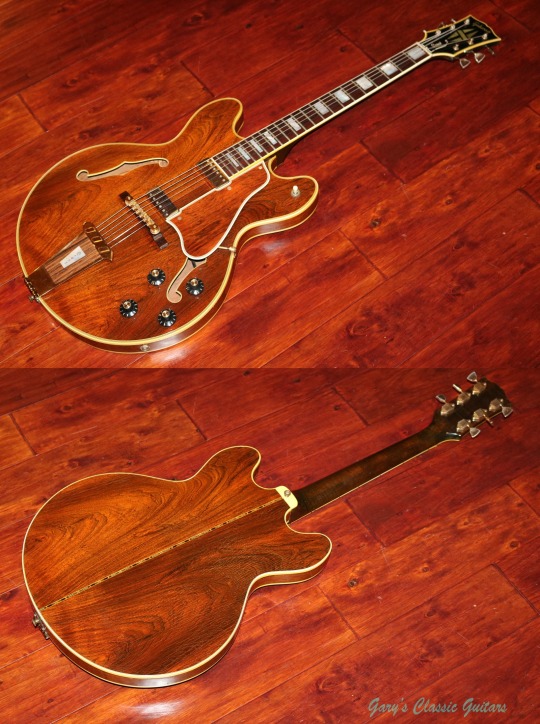
I'll be including images like these for projects that are either replicas, or I feel need the image in some way or another.
So, the rosewood veneer isn't a problem. Why is it still a shelved project, then? Well, the fact of the matter is that we live in a capitalist society. Things cost money, both for the item itself and the labour required to produce it. In short, wood is expensive, and I don't have the money yet. You may notice that "too expensive" is a running theme, even in cases where half of the expense is the guitar itself.
To avoid getting depressing, let's move on (finally)!
Tele Bass VI:
So, you may be wondering, "why's this one shelved?"
The thing is, it wasn't intentionally shelved. It's just that I can't really do anything with it without finishing the Crusader first. I need fret wire, wood for the neck, a nut, and a truss rod. Not that many things, but it's also what I need for the Crusader, and in the case of that, I at least have the wood for the neck, and a nut, but that still leaves me without a truss rod and fret wire (which I also need for my acoustic because it's got fret sprout, but that's neither here nor there).
I was intending a maple neck for it, anyway, and I need maple for the fretboard of the Crusader. Maybe I'll be able to sort that at some point. Moving on!
Lennon Les Paul Jr.:
This one's hard to call "shelved" seeing as I've done jack shit with it for 3 months at this point. Do I want to do more with it? Yes, absolutely. It's just finding the werewithall to actually go do more with it. Part of it's been the stress of organising my college stuff, but part of it's also been laziness and just not being able to decide if I want to do it or not.
I'm sure you don't want me to bore you with this one, and you saw a photo of a replica on the previous pinned post, so I'll move on.
Höfner 500/1 Violin Bass Replica:
This one is very much a doozy, but it's at least sensible.
Höfner's been going for over 100 years, that's an accepted fact, something that makes sense to everyone. Their "peak" of iconicity, however, came in the form of Sir James Paul McCartney, who has used Höfner's basses since 1961. Now, since then, they've done plenty of reissues of his (two) different basses, the 1961 with its close pickups, and the 1963 with the wide, separated pickups.
So which one would I go for? That is a good question, because it's really not what I should be asking. What I should be asking in its stead is "do I want to learn Actual Violin Lutherie to make this thing", because the whole "Violin Bass" is not just a selling point, it actually is constructed like a violin. It's a chambered hollow body, like the Country Gent, but it's the size of a violin, with the construction to match, including the use of flame maple (or, to use its more apt name, fiddleback maple) for the back and sides. The top, meanwhile, is solid carved spruce.
Don't believe me about the body size? Look at this sub-model Hofner do, based on the one you can see in Get Back:
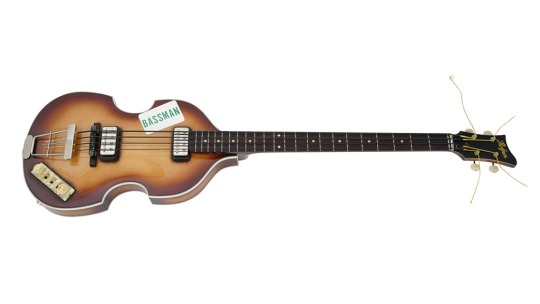
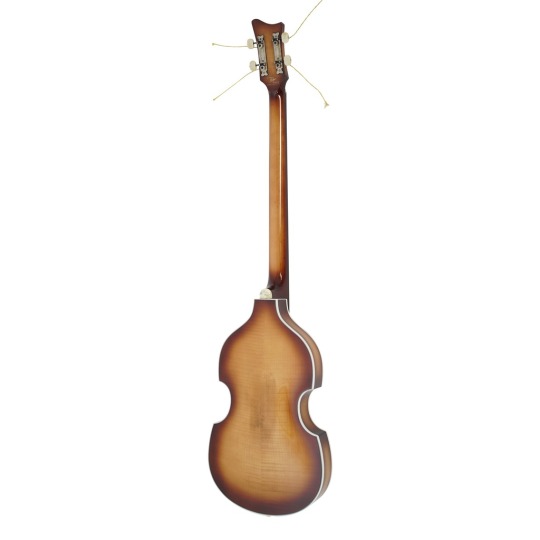
As you can see, the body is tiny in comparison to the length of the neck, especially when you compare it to an actual violin:

Look at the proportions on this, then look at the 500/1. Doesn't the neck seem so ridiculously long now? Anyway, that's gonna take some going at, and thus it's shelved for when I feel confident enough to actually do it, or at least to take a partial stab at it.
Now then, we've seen the ideas that I might get round to but aren't being done now for one reason or another. Let's look at the ones that won't be done at all, for one reason or another.
Lerxst 355 Replica:
To the average reader, that name's going to look like gibberish. To be honest, I don't blame you, the way it's pronounced feels like you're speaking gibberish as well. "Lurks-st". It sounds better if you try and put on a Canadian accent. Not full tilt Canadian, with all the "eh"-ing and being super polite, just a hint of Toronto.
Anyway, what's Lerxst? Or, more accurately, who is Lerxst? Lerxst is the nickname of Aleksandar Živojinović, a man known professionally as Alex Lifeson. He was the guitarist for Rush for as long as Rush had existed, until their semi-functional retirement after the death of their drummer Neil Peart. The remaining two members, that being Alex and the bassist Geddy, have performed together since, including at the Taylor Hawkins tribute concert and at the 25th anniversary concert for South Park.
Now, Lerxst has used many a guitar over the past 50 years, from that ES-335 he used in the beginning, to the large amount of PRSes he used between 1990 and 2010. His most famous, however, is the one this one is talking about: a 1977 ES-355 built by Norlin-era Gibson. It has T-Top humbuckers (named as such due to the bobbins having a slightly raised part in the shape of a T), 22 frets on a voluted neck, a 7-ply bound top (you saw me refer to this in the Crest section; 7-ply bound top doesn't mean the top is 7 plies of veneer thick, it means the binding is 7 plies thick, and is bound around a 3-ply top of maple-poplar-maple) with a 3-ply bound back, a Maestro vibrola unit, an individual set of volume and tone controls per pickup, a simple 3-way toggle, and the key part - a varitone switch, with accompanying bypass mini-toggle for the "raw" tone unmodified by the varitone.
The output jack's also mounted to the top, but considering it's an ES model, I wouldn't think that too revolutionary. So, what's a Maestro vibrola unit when it's at home? For that, we need to explain vibrato units overall.
The history starts with Clayton "Doc" Kauffman, who devised the first ever patented vibrato system in the 1930s, fittingly named the Kauffman vibrola. This worked quite differently to vibratos that we know now, as the action of changing the pitch was much more subtle, and was done through moving the arm laterally, instead of pressing the arm down to the body. The sound was meant to mimic a slide guitar (as that's where Rickenbacker's guitars originally started), but there was an ever-so tiny but incredibly crucial detail: the tuning stability was terrible. Guitarists such as John Lennon decided to replace the Kauffman units on guitars they were installed on with other models, such as the Bigsby vibrola, the second patented vibrato unit, and the first to see widespread commercial success.
The Bigsby works in a much more conventional way, using the standard we know now: push down to lower pitch, release to return to normal. Supposedly, it has terrible stability in and of itself, but that is from players who ended up being like Floyd D. Rose, who overused the vibrato of the Bigsby, requiring that they retune. The Bigsby wasn't intended for that; instead, it was only intended to provide a slight "warble" effect to playing, what some would term a "shimmering" effect.
This, in effect, is what Gibson's vibratos were meant to provide, starting in 1961 with the Sideways vibrola. I have an opinion on these: they suck, both in function and form. They copy the function of the Kauffman nearly wholesale, and the large folded up arm in direct contact with the nitrocellulose finish(!), well. Yeah, no, not for me. The Maestro, however, looks and behaves so much better. It functions like a Bigsby would, excepting that it doesn't copy the mechanism wholesale like the Sideways does with the Kauffman.
To explain this, let's go on a small side tangent about a Bigsby vs. a Maestro vibrola, because I assure you, this is actually necessary to the guitar.
The Bigsby works by loosening tension using the leverage of the tremolo arm to cause a deepening of pitch. It's kept in place and returned to normal pitch by a spring which is compressed in the action of using the vibrato unit. The Maestro, however, uses direct leverage on a bent piece of metal to cause the same loosening of tension and lowering of pitch.
This means that the Maestro, while more primitive, is easier to work with when restringing due to the fact that the strings are threaded into the tailpiece, which is then bent, changing the angle and distance between the tuners and the ball-end of the string, thus affecting the tension. The metal returning to its standard shape (because the force required to permanently change its shape has not been applied) is what returns the guitar to standard and proper tension (as long as it's been set up correctly).
The Bigsby, meanwhile, has a specific way of threading the string through the unit before sending it down the neck to the tuner and the nut. When restringing a Bigsby, there is a massive rigamarole if you don't have a Vibramate spoiler installed. You have to thread the string down from the bridge, under the tensioning bar, then up over the string bar, around it, and slot the ball-end on the tiny little post on the underside, so it can function correctly when the arm is depressed. I honestly wish I was joking about this. I have restrung a Bigsby once, and once was all the experience I needed. Never again. I heavily advocate for people to damn well use a Vibramate spoiler on their units, even if it's just because of a personal gripe.
Back to the point where we were, about... 8 or 9 paragraphs ago, the 355 generally came stock with a Maestro vibrola in 1977, so it's no surprise that Lerxst got it on his. It's even featured on the reissues from 2008:
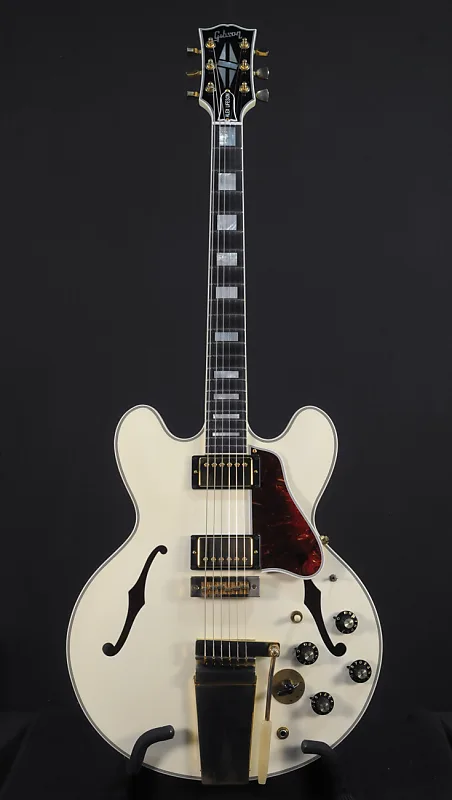
These are the same reissues that have a Fucked Up volute on the neck that's approximately halfway between the nut and the first fret, as opposed to in line with the nut. If I were to recreate this, I'd at least fix that.
So, it all seems possible, right? Then why is the build canned? Generally, it's the fact of the varitone, specifically the chokes. How, the literal fuck, do those things work. If I ever figure how they work, then maybe this will move from the can to the shelf. But right now? Canned. Completely and utterly.
Next, please!
Acoustic Rickenbacker 360/12c63:
This requires much less in the way of explaining. The Rickenbacker 360 is a famous guitar by most stretches of the imagination, soldiered on by its incarnations as the 360/12, used by George Harrison, the 370/12 used by Roger McGuinn, and the 330/12, used by innumerable amounts of famous guitarists like Peter Buck, Johnny Marr, Pete Townshend and The Edge.
But y'see, those are electric guitars. They've got magnetic pickups and all sorts of gubbins in there. My idea with this was to see if you could just... get rid of all that, construct a 360/12 in the double-bound style without that central block and all the electronics, and be left with an acoustic Ricky 12, complete with the compacted headstock and a piezo if I felt like it.
Knowing what I do about how Rickenbacker's shit is made, though, that would require making the body in the form of back, then sides, glued with bracing and then the top, with two sound holes. I'd then have to find somewhere to fit a pre-amp, and make sure that it's the usual thickness before then setting the neck in, which itself would be a 5-piece construction of maple with walnut center stripe and headstock wings, adding the truss rod(s) and the fretboard, before finally assembling the metal bits onto it.
Doesn't sound too hard, sure, but if you look at this example of what the Rickenbacker 360/12C63 looks like...
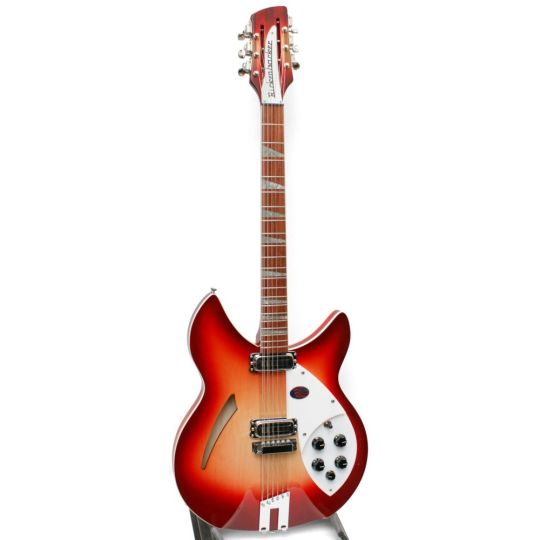
Yes, that is the entire thickness of the body. It's approximately an inch thick and not all that acoustically resonant. It'd be good as an experiment, but considering I'm debating over getting a standard acoustic 12 at some point, it's canned for that reason. Onto the last canned build, and the last build that's overall a hypothetical.
Telecaster-Shaped Red Special (TSRS):
I laid this whole thing out in a Notepad file back in May or June, as we were finishing up the Cherry XII, as a proposal of "maybe this can be the next build," but I scrapped it a month or so later because I fell into a trap I've fallen into so often it might as well be my home: I wanted to recreate a specific thing, without remembering the way that guitar is constructed, and really, what that guitar is built out of.
You see, the Red Special, built between 1963 and 1964 by Brian May and his father Harold, is a very interesting case of guitar design, in that it was designed to feedback in an appealing way. The internal cavities were actually carved out in a very specific way in order to allow for this, and most copies of the thing do the feedback, but struggle to do it exactly like his. He also has his own brand of guitars mainly made up of official replicas fitted with either a standard Strat-style trem system, that being the BMG Special, or the more accurate design mimicking the original's trem arm made of a knitting needle and a bicycle saddlebag holder.
Now, having only a Telecaster body, I couldn't recreate most of this. I mean, where am I going to put all this stuff? And the neck couldn't be slotted for 24" scale length. It just wouldn't have worked. 25", like the Harley Benton copy, maybe, but then I'd have to modify the body to allow for a 25" scale, and then rout out chambers for controls, the cavity, and the trem system's springs.
Looking back on it, I think I had a grand idea, but had bitten way too much off to just go and do it. If I ever do get it in my head to recreate the Red Special, even without a treble boost circuit or a treble boost pedal, I think I'm not going to try and start from a jump-off point, and just go at it from scratch.
Now then, we've gone through those that've been canned, let's look at the ones that aren't shelved or canned, but aren't currently in play. I denoted them as plausible above, but I might go at them at a slower rate than the Shelved builds.
Non-Specific Doubleneck:
When I say "non-specific" doubleneck, I don't mean "bland-name EDS-1275" like a Chibson or a Gear4Music or Harley Benton or anything like that.
For one, the EDS-1275 isn't the only doubleneck out there, nor is it the only doubleneck Gibson ever made. Rickenbacker made a 12/6 doubleneck 360, fittingly named the 362, as well as the 4080 doubleneck which was a bass on top and your option of a 480/6 or 480/12 on the bottom. That latter one was most famously used by Geddy Lee on Xanadu, as well as the former on A Passage to Bangkok (a song about smoking weed, if you didn't know).
Here's him with the former, in a surprising tuxedo (white with black plastics) finish:

And here's him using a Fireglo 4080/12 back in 2015 for the purpose of playing Xanadu:
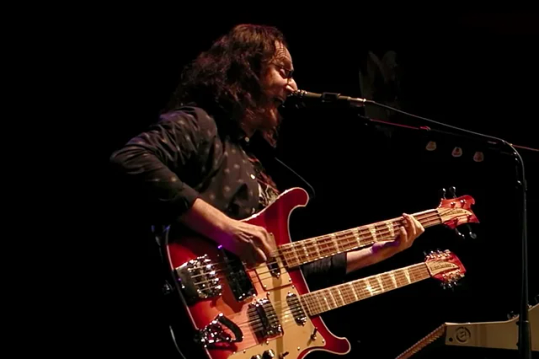
Anyway, that's a Rickenbacker doubleneck, but they're not the only ones to do this stuff. Fender also make doublenecks. Well, "make" is a strong term. This is the only one I know about:
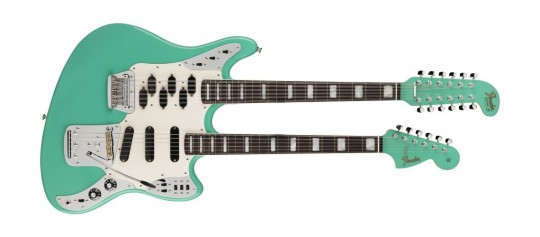
This is the craziest doubleneck I've ever seen. It's a basic 12/6, but actually No It's Not. You've got an Electric XII on top, which is the only "designed to be 12 string" guitar Fender made pre-CBS, and the Marauder on the bottom, with the vibrato merged into the pickguard, and the 5 pickup switches and the kill switch and everything that makes it the Marauder.
If I ever decide "okay, let's make a doubleneck," and then actually go through with it, I think I'm gonna take some design cues from all of these. I'll probably also chamber it so it's not uncomfortable to play for long periods of time, and just hide the chambering under the pickguards because that's a thing that could work.
Now, the other plausible idea.
Resonator Acoustic (kit build):
You know how I said kit builds were out of the question? Yeah, I didn't believe me either.
Resonators are a really cool relic of the pre-amplification era. Like, they're the step between electric guitars with magnetic pickups, and the acoustic guitars we all know, minus the piezoelectric undersaddle pickup. They work by passing the strings over a bridge mounted to a resonator cone, and when a string is plucked, strummed or otherwise makes a sound, the cone takes the vibrations and amplifies them entirely acoustically. They were originally made by a couple companies before Rickenbacker came along and invented the horseshoe pcikup and, by extension, the electric guitar.
Those companies were National String Instrument Corporation, and Dobro Manufacturing Company. The former was founded in 1927 by George Beauchamp (anyone who knows the history of Rickenbacker will know that name), and John Dopyera, a Slovak immigrant who came to America with his brothers and father in 1908, sensing that war would soon break out in Europe.
Smart move, fellas!
Anyway, Dopyera and his brothers, Rudy and Emil, soon left National to form their own comapny, Dobro. Dobro is a name with double meaning, in this case - while it's an abbreviation of Dopyera Brothers, it's also the word for "good" in a lot of Slavic languages, leading to the slogan "Dobro means good in any language!"
Due to Beauchamp's work with Rickenbacker, though, resonators fell off the radar in terms of popularity. After all, they'd figured out a form of amplification that didn't use lots of metal, so resonators ended up failing as a product. Or at least, they did for a while. Nowadays, you can find many brands producing resonators, usually for the specific tone resonators provide: rich and metallic. They're seen nowadays as bluegrass and country music instruments, but you can see people like Mark Knopfler using them for songs as well.
Now, this isn't referring to a specific kit build. I found one that's kinda an ES-style thing, with 21 frets, so that's probably the one I'd go for, not least because I like upper fret access, but it's all dependent on if I still want to build a resonator acoustic after the current build, or if I'd want to do something else entirely. It's an odd thing, my mind.
So, what now? The completed section? Eh, not exactly.
I would do a small piece on the Fretless and the Cherry XII each, I really would - God alone knows I love rambling about these builds enough, this post is testament to that on its own - but I don't need to. I made a full post about the creation of the Fretless, and made multiple posts in the course of building the Cherry XII, starting back in January and leading up to June.
But other than that? That's all there is to this post. There's nothing more I can really do in terms of explaining my ideas. I may have more ideas in between now and whenever I revisit this concept, I may reshuffle things, shelve one idea or can another. But as for everything else? It's in flux, constantly uncertain unitl we reach and observe it. I can't really say what I'll want to build after the Crusader, because I haven't finished the Crusader. Hell, I've barely started it.
Hope you enjoyed reading this. If something needs explaining further for one reason or another, tell me, and I'll try and explain it to the best of my ability.
#guitar building#lutherie#fender guitars#gibson guitars#takosader's ramblings xii - yes this one counts#it's still a post that i rambled in of course it counts#there's still swearing in here#that metal plate tangent was not played up; i do actually fucking hate them. i get it for the trem system - i really do#but good god why does it have to be for the controls as well#welp see y'all in 2025 for more ramblings#au revoir et à bientôt.
8 notes
·
View notes
Text
"I still have nightmares about that cat..."
squeal1.wav, my beloved
29 notes
·
View notes
Text

Continuing the tradition from last year, the meme!
Garry Crimble, and a Merry Goo Year!
#ace attorney#almost christmas#gary crimble ladies gents and nons#crimbus message source: john lennon#if you don't celebrate christmas#happy hanukkah#or whatever you celebrate#idk i don't judge
7 notes
·
View notes
Text
Hello there.
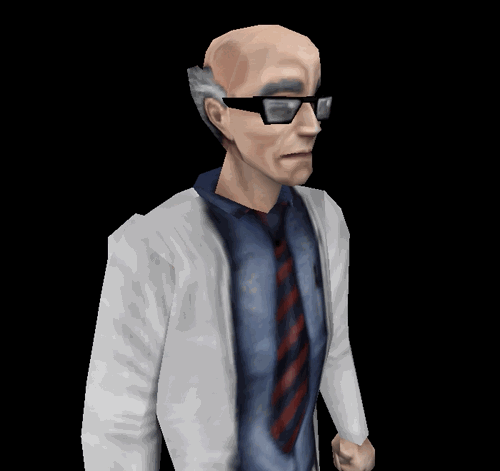
Okay, now that I have your attention, welcome to a subseries of my ramblings I'd like to call:
"X Was A Mad(wo)man"
This is a series in which I will take a look at patents, guitar, bass or drum techniques, and give my own little comments on how crazy they are. People who know me from the Curated Tumblr Discord Server (hereafter referred to as CTDS) will recognise this format from when I rambled about 12-string guitars for 2 straight hours. For everyone not from CTDS, I wish you the best of luck in trying to follow along.
So, who is our first subject? Oh, just a radio repair guy from California, you probably won't have heard of him. Who is he? One Mr. Clarence Leonidas Fender, founder of and innovator for famous companies such as Fender Musical Instruments Corporation (sold to the Columbia Broadcasting System [CBS] in 1965, rescued from CBS in 1985 by William Schultz and the company's employees), Music Man (technically a silent partner to the founders, ties cut in 1979 after issues regarding payment for refinishing), and G&L, founded by himself, Dale Hyatt and George Fullerton.
If you want to go, now would be the time. If you want to read on, buckle in, this one's going wild from the get-go.
Fender was born in August, 1909, to parents who owned a very successful orange grove between Anaheim and Fullerton, California. His childhood was presumably unremarkable, apart from when he developed a tumor in his left eye, causing said eye to be removed, and replaced with a glass one. This, you might be surprised to know, is what made him ineligible for the draft during WW2. That, however, is for later. For now, let's go back to Fender's life and times.
He was interested in piano and saxaphone during his youth, but later developed an interest in electronics, which only strengthened after a visit to his uncle's automotive-electric shop at the age of 14. Why? Because of a project his uncle had made: a radio, cobbled together from spare parts. Soon thereafter, he started repairing radios in his parents' house.
He wasn't doing this as a full career at this point, not by a long shot. If anything, it seems like it was only a hobby from the late 1920s onwards. He went through college majoring in accounting, and later did work as both an ice delivery man and a bookkeeper (alternate title for an accountant, if you didn't know; there's a reason their job is to balance the books), but his biggest job, at that point, was in the mid-1930s, when he was approached by a local bandleader to make six public address systems for Hollywood dance halls.
Now, let's pause there. What is a public address, or PA, system? According to Wikipedia, a PA system is "an electronic system comprising microphones, amplifiers, loudspeakers and related equipment." They're basically used to make people louder for the purpose of addressing many people. For the few, if any, Brits that follow me, we'd call them Tannoys because that was the main brand of them over here.
An interesting subset is one directly used for live music, called a sound reinforcement system. That's the kind where the music's fed through the mixing console, and then adjusted to be louder or quieter depending on the requirement. It's quite ingenious when you think about it. It also allows for feeding in of prerecorded sounds and backing tracks, just to allow for extra accuracy when compared to the studio version.
Back to Fender, he started Fender Radio Service in 1938 after returning to Fullerton with his wife Esther Klosky, and soon after, musicians and band leaders alike began coming to him for their PA systems, which he built, rented and sold, and the amplification for both the amplified acoustic guitars which were becoming popular in big band and jazz music, and the Hawaiian or "lap steel" guitars which were making headway in country music.
But then, the Second Small Disagreement happened. Well, I say it "happened", it had been happening for at least 3 years by the time America got involved. Anyway, during this time, due to being ineligible to fight for America due to his glass eye, Leo Fender was still in America, making these amplifiers and PA systems, and then he met Doc Kauffman. He's another inventor you might know for his work with Adolph Rickenbacher (yes, that's how you spell it as originally written, he only changed it because of his cousin Eddie.)
Kauffman and Fender, upon the urging of the latter, started a company together: K&F Manufacturing Corporation, the purpose of which, was to build amplifiers and amplified Hawaiian guitars, resulting in Fender's second patent; having previously filed a patent for his pickup design in September of that year, Kauffman and Fender filed a patent for their lap steel guitar design, and in 1945, the lap steel was sold as a kit, including a K&F lap steel amplifier.
Very early variants of the lap steel featured a metal tag with the K&F logo on it, while later versions had it stencilled on. The earliest models also have a body design difference - on the left is a 1943 K&F lap steel in possession of the Museum of Pop Culutre; on the right, a 1945 K&F lap steel.


As you can see, there's just a few differences here. First of all, the body shape: the 1945 lap steel is just a slab, while the 1943 model has a slightly contoured body, akin to a violin. Secondly, the headstock: the 1943 model is exactly as the patent depicts, with a rounded rectangular headstock, similar to Martin headstocks, while the 1945 headstock has entirely straight string pull.
Now, considering the era of guitars we're talking about here, that is an actual miracle, because the main two competitors for this were Rickenbacker and Gibson. Martin and Harmony were mostly doing their own thing, and most of the other big names weren't even there. If you didn't know, or couldn't guess without it being pointed out to you, Gibson and Rickenbacker's headstocks are a bit... wacky, when it comes to having manageable string pull. The main issue is that the strings splay out to the sides in both cases...
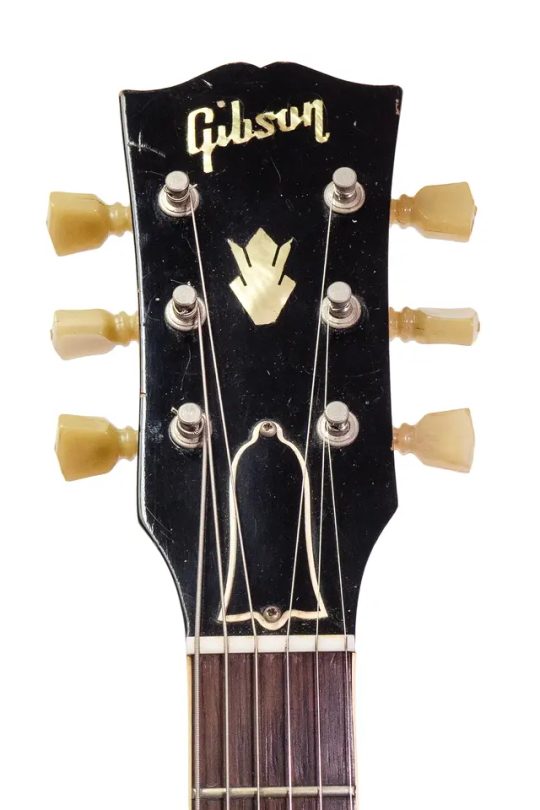
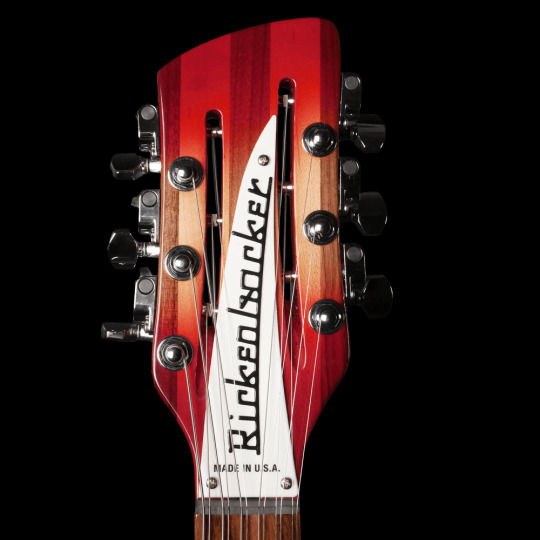
...which places emphasis on the logo of the manufacturer (as if the headstock shape didn't already do that).
Fender wasn't the only one figuring out string pull around this time, either, as Paul A. Bigsby, inventor of the Bigsby vibrola, was also working on guitars around this time. Fender and Bigsby did work together at one point, or at least they both knew each other. Bigsby was, however, an inventive soul, and interested where Rickenbacker's idea of a solid-body electric guitar would go, and so was another madman: Lester William Polfuss, known more by the stage name he recorded under, and the name chosen for his Gibson endorsement: Les Paul.
I will not touch on Les Paul even slightly in this post. Just know that he built his own neck-through semi-hollow guitar out of a 4x4 fence post, and a disassembled Gibson and Epiphone archtop each. Why? In pursuit of the cleanest tone possible. Think of it as like if metal bands tried one-upping themselves every album, making each on dirtier, more distorted, more grungy and crunchy.
There is a story of a feud from about 1949-1950, though. Bigsby built a solid body guitar for a country player, Merle Travis. The original didn't have the vibrola, and looked remarkably like a Les Paul with a Trini Lopez headstock (or an Aldo Nova Les Paul if you're into '80s rock). Fender asked to see this guitar he'd made. Then, in Spring 1950, the Esquire came out. That is to say, version two of the Esquire came out.
Yeah, the Esquire didn't look like that at first. Instead, it looked more like this...
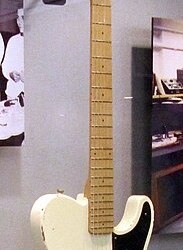
No, your eyes do not deceive you, that is a double-sided headstock on a Fender electric Spanish guitar that wasn't made of surplus 12-string parts. And yes, it only has half a pickguard, and a separated control plate. Overall, the lower half is laid out much more like the Stratocaster than the Esquire, so much so that it makes you wonder if Leo decided to revisit this control layout when it came time to do the Stratocaster design.
Now, this version of the Esquire had no truss rod in the neck, which was one massive block of maple, and had a pinewood body. The Esquire we all know is either alder or ash, rarely roasted pine, with a maple bolt-on neck fitted with either a rosewood fingerboard, or a one-piece neck made of maple with a skunk stripe to hold the truss rod in place.
Now, I've rambled for a while now about a guitar, so surely we must be ending, right? Well, for everyone aware of how big Fender is as a company, it... yeah no, this is only the beginning. Anyway, the Esquire was available in black or in a semi-transparent blond acetate lacquer, which is where the famous Butterscotch Blonde colour comes from. One thing I'd like to note before we move on: the advertisement Esquire, and the commercially released Esquires have one difference between the two: the ad model hasn't got a selector switch. This requires stepping back a couple years to explain, though.
One of the features of Fender's lap steels early on was something referred to as the "Organ Button", a circuit between the pickup and the output jack that, somewhere in there, is meant to try and simulate the sound of an organ. Now, I know what you're thinking: "What's this got to do with the lap steels? The Esquire has a selector switch!" Well, dear reader, you're correct, the Esquire does have a selector switch! However, that almost didn't happen, as can be proven by this April 1950 advert (source: Fuzzfaced):
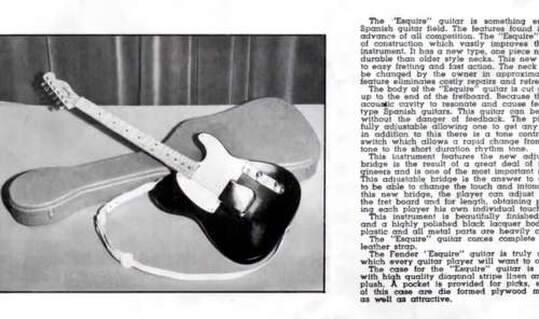
These are what's called "Lamp Button" Esquires, due to using an on/off Leviton lamp switch, designed for military use, and probably gotten as surplus. The 3-way switch it got replaced with was more straightforward, if you know how to work with your tone knob:
Back position (towards knobs): signal from pickup bypasses tone pot, meaning its as bright as it can be.
Middle position: volume and tone pots factor into output signal from pickup.
Front position (away from knobs): through some magical wizardry, as well as a 3.3kΩ resistor and two 0.05 mF capacitors, a tone that's more akin to a bass guitar makes itself apparent.
If you know the guitar order, you know where this goes. If not, let's follow the logical course:
It's 1950, and you've started mass-producing electric guitars for the general market, and everyone seems smitten with this thing for its sound, especially the front position with the filtered sound, and the Broadcaster itself is selling like hotcakes because people want the guitar with 2 pickups.
But wait, this company over in New York already uses Broadcaster for their drums! We didn't think about that! Quick, get the decals modified, we'll sort out new names for them later.
Wait a second, people like the filtered sound? It sounds like an upright bass if you lower the tuning of the bottom string... Oh, there's an idea! What if we made a bass that's more like the Esquire?
(Note: the above is purely a summary of late 1950 and 1951 for Fender, covering the success of the Esquire and Telecaster, the dropping of the Broadcaster name, leading to the highly sought-after "Nocaster" variant, and the creation of our next item.)
As a result of all this rushing about, as stated above, we got the "Nocaster" variant of the Telecaster, and the next item: the Fender Precision Bass. Like its little brother, the Telecaster, the Precision Bass is a string-through body with a bolt-on maple neck complete with the usual Fender skunk stripe. It is, of course, much longer than the Telecaster, with a full 34" scale length and much larger strings, but that's to be expected with a bass.
Original P-Basses were much like the Telecaster in design, albeit with an upper horn, and a finger rest below the strings to allow the player to strike the strings with their thumb. It also had a pickup and bridge cover, which just... existed on there; I think most players tended to toss those in the case and never use them again.
Now, who was this designed for? It can't have been for the standard bass players of the age, they still swore by their upright basses. From what I can find, it was designed for big band guitarists, with two of the biggest original users being Roy Johnson and Monk Montgomery, both of Lionel Hampton's big band. Johnson was actually the first to use this style of instrument in a concert setting, something that surprised contemporary music critic Leonard Feather, who wrote in Down Beat that this was due to hearing bass sounds from a guitar. Montgomery, however, was the one to help popularise the P-Bass, even if veteran bass players called it "a weak note amplified" or "an amplified plink-plonk".
For what it's worth? I think they were just sour that it was getting easier to play bass. I've not played an original-style P-Bass myself, but I have played the more well-known variant, and it certainly doesn't sound weak or like it's going "plink-plonk" at you. Anyway, it's the year 1952, and Fender have settled on a new name for the guitar: the Telecaster, named for this new medium getting really popular, something called "television" or something like that. It's still selling like hotcakes, but all this time, Leo's been collecting feedback from guitarists. After all, he's not just an inventor, he's an innovator; he wants to make these guitars better for people.
One thing he had heard from guitarists is that the intonation is good, but it should be individually adjustible, so they can get it sounding exact all the way up the neck, but by far the biggest critic was Bill Carson, a Western swing guitarist, who said that the next model should have "body contours" which would make it far more comfortable to play and "wear" in comparison to the plank of wood that the Telecaster was, famously remarking that it should fit the body "like a well-tailored suit."
This one was to be the Stratocaster, which entered prototyping in late 1953, with Carson helping beta-test the design. The design was slightly inspired by the dual-horn body of the P-Bass, and when it entered full production in 1954, the P-Bass was modified slightly to include slight contouring, a new two-section bridge, and a new 1-layer white pickguard, while keeping the same control layout, headstock design and general Telecaster aesthetic.
The Stratocaster, though, that became a hit almost immediately. Unlike the competition's guitars, which were either amplified acoustics or something like the Electro-Spanish or Les Paul, it didn't immediately or significantly resemble prior acoustic models, not that Fender previously made acoustic models. Their popularity was so great that, even today, Strats are some of the most recognised electric guitars out there, on par with the SG, Les Paul, Telecaster and some Rickenbacker guitars.
Now, up to this point in time, and up to 1971, with the introduction of the adjustible-tilt 3-bolt neck, all of Fender's guitars were designed with a heel-adjust truss rod in mind, meaning that before 1971, all Fender guitars had to have their neck relief set by either relieving the tension of the strings, and raising the neck high enough to access the heel adjust, or, and this seems to be how it was intended in the '50s and '60s, you take your strings off, you take the neck off, and then you adjust the truss rod, before then putting your neck back on, putting the strings back on, and then checking the relief. Yeah, not fun. I'd imagine it was changed because people were fed up of the rigamarole of doing all that.
Anyway, the other thing that the Strat had going for it is the 6-point synchronised tremolo- wait, tremolo?! Yes, tremolo; Fender quite famously mixed up tremolo (change in amplitude) and vibrato (change in pitch), which carried over to the 1956 Vibrolux amplifier. The synch trem was something else specifically requested from criticism, as the only other options available on the market at the time, the Kauffman and the Bigsby, were both separate units from the bridge, meaning that the strings would be more likely to detune from a slightly more exaggerated warble, what the Bigsby unit was intended for.
Meanwhile, the mechanism and design of the synch trem allowed for two things. First, it allowed for perfect intonation due to its six, freely moveable saddles, each with two Allen screw adjustments to follow and match the 7.25" radius of the fretboard, and second, it allowed for more exaggerated changes in pitch in comparison to both the Kauffman and Bigsby, best demonstrated by players like David Gilmour, whose control over the mechanism is, frankly, amazing.
So, we've seen 1954 come and go, but Fender never stopped. He improved the way his lap steel's tuners functioned, resulting in a classical-style tuner set, 3 or 4 on either side, facing into a hollowed-out peghead which, much like the style of peghead used on the 1945 lap steels onwards, had accurate and straight string pull.
Fender unfortunately doesn't make lap steels nowadays, but they still exist second hand, if you want to look through Reverb and similar sites for those things. Anyway, in 1956, Fender also came out with the previously mentioned Vibrolux amp, an amp that you would think acted much like a Leslie speaker. Well, no. It has an oscillator in the circuit, but audio oscillators for a guitar sounds more like a phaser to me than a Leslie. Leslies give the tonal quality that John Lennon's voice had in Tomorrow Never Knows, or the wavy guitars you can hear on Here Comes The Sun and Badge, or for my fellow prog fans out there, the B note "ping" from the piano on Echoes.
Anyway, moving on, the year is 1957, and we have some upgrades to make! Specifically, the P-Bass needs an aesthetic update, because it's still themed around the Telecaster. That needs a change, to capitalise on the success on the Stratocaster. So, they changed the pickguard, integrated the control plate into the pickguard, changed the headstock to something more like the Strat's, and put a new type of pickup in the body, leading to the quite iconic and well known split-coil. This design emphasised the D and G strings by making them brighter in comparison to the E and A strings, mainly by placing the D and G strings' pickup a whole 1.09375" (1³⁄₃₂", or 27.78125mm) further away from the neck.
An inch doesn't sound like much, but when you're talking about guitars, everything is inches. Never feet, never millimetres (unless it's a European brand like Höfner), always inches. For example, something I've neglected to mention for the entire post, so far, is that the scale length of every electric guitar Fender has made so far is 25.5". That is one of the Big Three scale lengths that everyone goes for, the other two are 24.75" (actually 24.6", Gibson, you lying money-grubbing fucks) and 25", though I don't know how many people use 25" outside of PRS. There's some outliers here and there, for example 24", 22.5", which Fender used the year prior to this (1956) on the Musicmaster and Duo-Sonic, or the insanely short 20.75", but that won't become relevant until the next year on our list. Speaking of...
The year is 1958, and Fender's at it again. Last year, he prototyped using 7 pole pieces with a 6-string guitar, which I've heard makes the top and bottom string less aggressive, but I haven't investigated enough to tell if that's the case or not. But anyway, the year's rolled over and NAMM's coming up. Leo needs to figure out how to compete with Gibson this year, after they came out with the "guitars of the future". This "7-pole on a 6-string" thing isn't exactly going to turn heads, so Fender decides to bring something he and George Fullerton, a longtime associate of his, had been working on over the past year.
They decide to bring the Jazzmaster, Fender's attempt to get the jazz players on board with his guitars. The Jazzmaster is a masterclass of guitar design, specifically because it comes straight out of left field. The biggest point is that the body is offset. Now, what does "offset" mean in this context? Offsets, when mentioned in guitar terms, are a style of body with a waist which dips in at 2 separated points, like the example in this image, courtesy of ATB Guitars:
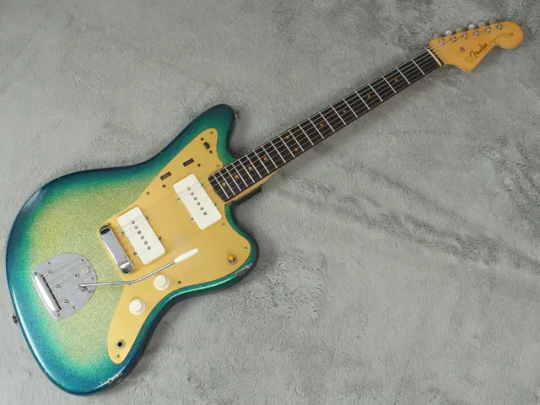
Yes, this is a real example of a Jazzmaster from 1958. Gold-guards are rare, but this is unique beyond belief. Custom colours had only just been offered, and the sparkles were aluminium flake that was mixed into the lacquer. Now, what does that signify? It signifies the beginning of the car colours. Your Surf Greens, your Candy Apple Reds, all sorts of stuff. Why? Because Fender's first factory was just down the road from an automotive place, and why not take advantage of that?
So, the Jazzmaster gets revealed in 1958 at NAMM, and is marketed as the step above the Strat. Yes, the step above. A premium model, marketed as a solid body alternative to the standard jazz guitars that players of that genre used. He tried this, attempting to get them onto Fender's side, at the expense of Gibson, the same company who's been giving this genre's players instruments since they've been making electrified guitars.
As you can probably guess, this failed. However, an interesting thing about this, Fender actually patented the offset body design. Yes, seriously. And, because of its different ergonomics and entirely unique body design at this point, the patent was actually granted. Again, seriously. Don't believe me? Look at this:
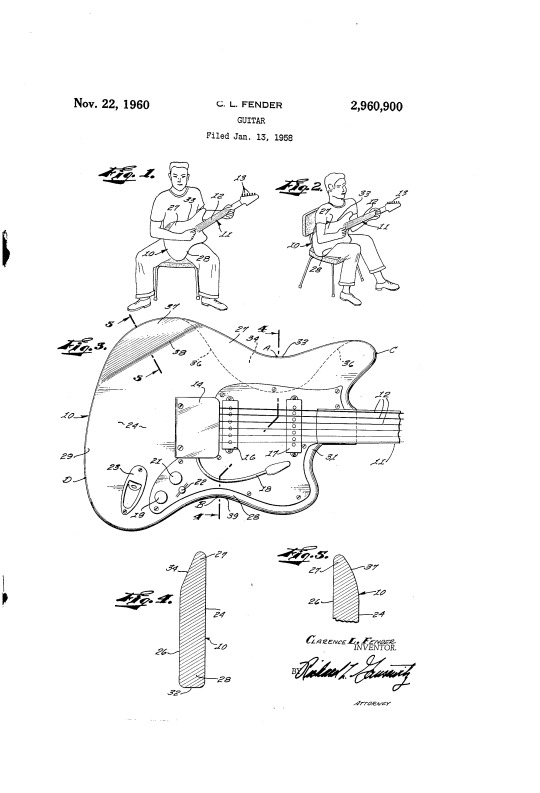
Interestingly enough, that's actually not the design of the Jazzmaster that ended up being used in any way. It never had any top-mounted output jack, and the 7-pole pickup never got used. Moreover, there's no blade switch on the Jazzmaster, and the patent is entirely missing the rhythm-lead circuit, which is an entirely different kettle of fish. The tremolo and bridge is entirely different to the release, and the thing is, that's because this uses the original design of the Jazzmaster!
Strap in even further, because HOO BOY THIS GETS WEIRD.
So, this is a photo from 1957:

The composition of this picture is actually incredible for Fender history. I can't credit myself with having discovered it, though. From what I can find, this was actually a photo taken in Leo's office. With context and external knowledge, I can say with some certainty that this was taken between 1957 and 1958, and features some very interesting variants of guitars.
For one, that third guitar? That's an electric mandolin. Never heard of them? Makes sense. They are rarely ever made, and most, if not all, mandolin players prefer double-course acoustic mandolins like those produced by Gibson. The one seen in the image has a Telecaster-style pickup, a 24 fret neck (wow, who would have thought that there'd be a 24-fret Fender in the 1950s that could be played without a slide?), and an ash body, contrasting the guitar it's next to, the Strat. Strats, by 1956, had been moved to alder bodies from ash because of cost reasons; alder was both more affordable and more readily available than ash was.
But that's not the really crazy thing about this photo. The crazy thing here is the leftmost guitar on display, being the style of Jazzmaster featured in the original patent, complete with 7-pole pickups, a bar that's far more curved than anything the Jazzmaster later got, and the original style of pickguard. It even has the output jack mounted like a Strat, as it was originally. Another thing of note is the Telecaster with Wide Range single coils, or to use their proper name, JM soapbar coils.
Just kidding, no one knows what the fuck to call them! They're about the size of a Wide Range humbucker, but those didn't come into use until 1971 along with the head-adjust truss rod. Fender, the company, has made modified designs of the original pickup that actually are a Wide Range humbucker, just put underneath a modified version of the JM pickup casing. So you know what? Personal opinion time, these are called Wide Range single coils, due to the fact that it's basically what they are. The pickup is wound wide and hot for greater articulation, just like Wide Range humbuckers.
So, what about the Strat? Anything special there? Not really, no. If anything, that's the most normal guitar there, and the only thing I can think of that's of any interest is that the thing's a solid colour. Not a surprise, considering that they had started doing solid-colour finishes at this point, starting off with stuff like Surf Green and Fiesta Red, what the boys called "Fullerton Red", after ol' Georgey-boy, who I mentioned earlier. He'll come back in later.
Also of note in this year, and something especially incredible, at least from Fender: the first solid-body electric violin. Yes, seriously, Fender made electric violins in the late 1950s. They also got reissued later down the line, but that's not until the late '60s, and we've got at least 10 years to get through before we're there.
Now, we're on 1959. Fender's got a patent on a new pedal steel design, which he's still making and doing very well with at this point, and the Jazzmaster has finally entered full-scale production. Does it live up to its name? Does it actually master the jazz market and bring Fender some jazz musicians? Quite simply, no. It doesn't even come close. Why? Well, one thing you need to know about guitarists and musicians is that we are creatures of habit and tradition. Most will go with known factors over unknowns, and Fender just threw all of that out of the window and said to the jazz players, "Here, try this! I promise it won't suck!", all while trying to not look like the cat that crapped on the carpet.
However, Fender lived in southern California, just southeast of Los Angeles. What comes to mind when you think of late '50s, early '60s Cali? Surfing. Yeah, that's right, kick up Misirlou, DIck Dale's here. ...Okay, so maybe not Misirlou, that was released 1962, and we've only just reached 1960. But anyway, Dick Dale was enlisted by Fender himself to test new equipment coming out of the factory from Fender's brain, up to the point where Fender had stated in interviews, "When it can withstand the barrage of punishment from Dick Dale, then it is fit for human consumption."
That quote was about an amplifier, of all things. The reason is that Dale liked to play loud. Not just loud, but loud, like "hear yourself playing over the screaming crowd" loud, to the point where he would regularly break amps by overloading them consistently. Fender then went with Freddie Tavarez, who had previously helped him prototype out the Stratocaster, to the James B. Lansing speaker company to ask for a custom 15" speaker, leading to the JBL D130F, the speaker that was then used in the Fender Showman amp, the first amp that Dale could not explode through the power of high-volume surf rock.
Fender also released a new electric bass unto the world in 1960 - the J-Bass, or Jazz Bass. Like the Jazzmaster, it was envisioned to worm its way into the jazz scene and uproot the traditional. Interestingly enough, though it didn't do as intended, it worked nonetheless, and Jazz Basses are one of the more used basses out there, compared to Gibson's offerings that seem to be hen's teeth by comparison, or Rickenbacker's which have their place, but are usually relegated to use by players wishing to emulate the sounds of Geddy Lee, Macca, Lemmy or the late, great Chris Squire.
The J-Bass, meanwhile, seems to have been used by everyone and their mums, offering some of the most versatile tones imaginable. John Entwistle recorded the bass solo of My Generation using a Jazz Bass strung with LaBella nylon tapewound strings, rather than the roundwound thin strings that came stock on Danelectro Longhorn basses at the time (and weren't available separately). Depending on the source, Entwistle may have played using a pick, or he may have used 3-finger technique, who the fuck knows. Hell, considering when the song was produced (1965), it may have been Betsy, the Jazz Bass now owned by Guy Pratt.
That's far and away past our current range, but something I'd like to mention - a lot of this has been jumping around the timeline, which is something I quite like to do with these posts. After all, what's the fun in talking about your hyperfixations and sticking to a rigid timeline? So anyway, back to 1960. The Jazz Bass was originally produced with stacked volume and tone knobs, probably the earliest recorded use of dual-gang or "stacked" potentiometers in commercial guitars. They got phased out in 1962, though, so any vintage J-Bass with said stacked pots are worth tens of thousands of your choice of currency.
This isn't even me talking out of my ass. Thanks to one guy in Emeryville, California selling one on Reverb, I can show you:

Now, okay, it's not that good a photo. But look at the knobs. See how there's only two? And not only that, see how there's skirting around the bottom? That's the stacked pots in action. I don't know which level does which, because I've not actually had experience with this specific style of J-Bass, only the later style with individual volumes and a master tone. Presumably, though, the knurled part is the volume, and the skirt is the tone.
You may also notice that there's covers over the pickup and the bridge. That's not just something on the J-Basses from 1960-1961. This is something Fender did for every guitar he made until a model later down the line. Every guitar that Fender made from 1943 up until around 1964, all of them had pickup covers, sometimes referred to as "ashtray" covers, which makes sense considering how prevalent smoking was in this era.
Moving on, the year is now 1962- *record scratch sfx*
Wait a second - why are we skipping 1961?
Because no guitars got released in 1961. Some patents got applied for in 1961, but neither were approved until a few years later, so they aren't of relevance.
But something did get released in 1961! The Bass VI!
I assure you, I did not intend to miss this out. I'm writing this bit when I'm partway through the point when Fender sold the company to CBS; everything after this was written before this specific bit is. I forgot about the Bass VI until now. If you couldn't tell by this point, I'm scatterbrained as fuck. So, let's quickly rectify things.
The Bass VI was released in 1961, and it was niche at best. Originally, it was styled like a Jazzmaster in terms of design and controls, but in 1963, it got an aesthetics update to bring it in line with the Jaguar instead. Originally, it looked like this (image credit: RetroFret):
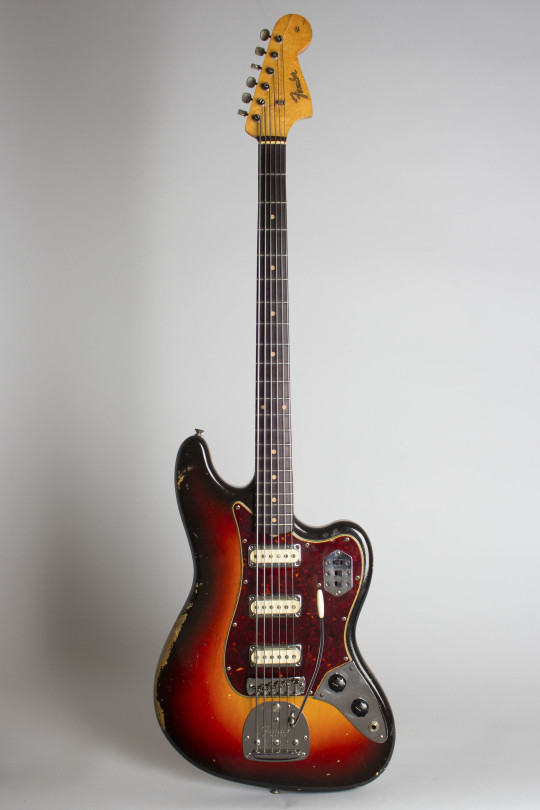
That's unique-to-the-instrument pickups, master volume and tone (using the Jazz Bass' later style of knob), only 3 pickup switches instead of the 4 it'd later be, and no headstock decal. Meanwhile, the rework looks more like this:
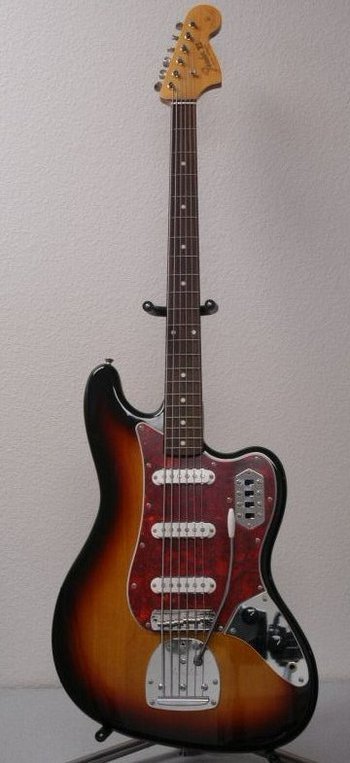
4 switches, Jag-style pickups, and everything else basically the same. Interestingly enough, this is one of two 6-string basses Fender has on offer nowadays. The other is a Squier offering that's a little more contrabass than this.
Now that that's sorted, back to your regularly scheduled timeline-hopping. *reverse record scratch sfx*
I did miss out some student models from the list, like the Duo-Sonic and the Musicmaster, both released in 1956. Both looked much like something we'll get to later, but make no mistake when you look them up - they are both normally bouted, neither have an offset waist.
But anyway, 1962. The Jazzmaster is... sustaining, but it's not exactly popular with the intended market. Jazz players really like those jazz guitars, don't they? "But Dale and his contemporaries like it," goes Fender's thought process, "why don't we try appealing to them?" And thus, prototyping begins for this brilliant thing to release in '62:
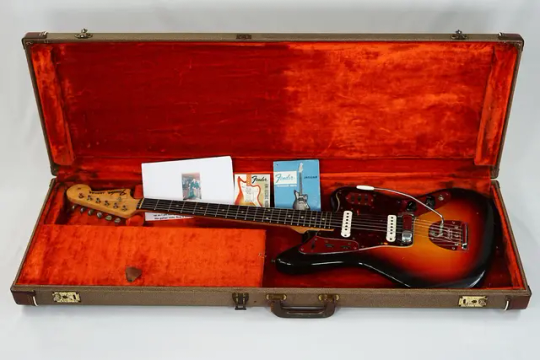
This is the Fender Jaguar, and it was entirely aimed at surf music players in the ads. It's not like that was the original intent; the Jaguar was marketed at the same tier as the Jazzmaster, the top-of-the-line feature-laden tier that was meant to draw people to Fender and away from Gibson.
Now, I've played a Jaguar before, and I speak from experience when I say, they are cool as shit. There is one massive issue, though, and that's the fact that they do not like being set up properly. They'll stay set up properly, but they will give you the greatest grab-bag of grief you've ever experienced in the process of setting a guitar up. There's also a few nitpicks I had with it, but those are mainly from not knowing how a Jag's circuitry works. Coming from blade switches, I had no idea how the fuck this thing worked, which way the switch had to be for "on", and which it had to be for "off". Other than that, though, I had the time of my fucking life playing that thing.
But anyway, this peaked surf music player's interest massively. It wasn't as popular as the Strat or Tele, but it definitely still had its day. The ads featured beach theming, but it didn't get publicised much by surf rockers outside of the odd appearance of Carl Wilson in one of the early publicity photos. In essence, it was a guitar that the target audience enjoyed, but didn't try and promote. It didn't survive the '70s CBS era, though, even with the introduction of custom colours, block inlays, bound neck, and all that, it just didn't get popular enough, and it got axed from production in 1975.
It got better, though, don't worry.
Also of note in 1962, the
Anyway, 1963... last year of the old Musicmaster... Brian May's started on the Red Special... Nope, can't think of anything big. Let's check the patents... Ooh! Electric piano...
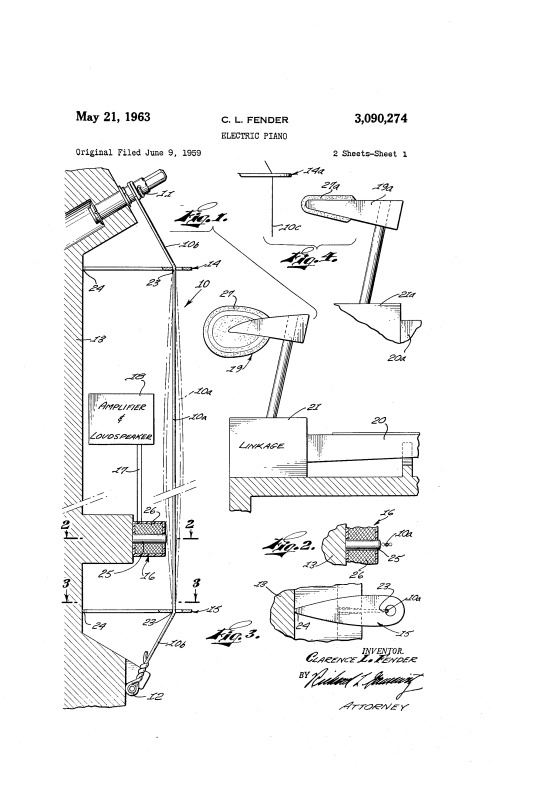
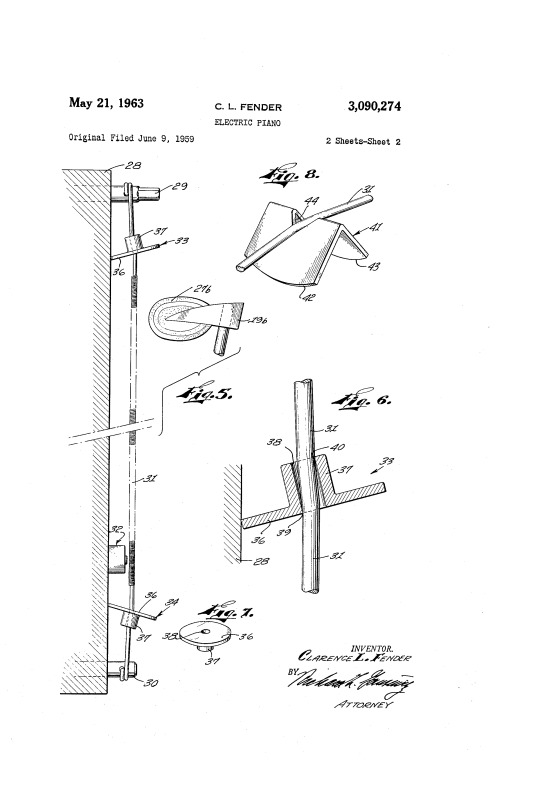
Hmm, I wonder what these are about, as if I didn't know. Yep, this is about the Rhodes, the counterpart to the other famous electric piano, the Wurlitzer. This is a tine piano, while the Wurlitzer is a reed piano. But, we're on about guitars here, so piano's out of the wheelhouse. This'll stay out of the tags, I'm too much of a guitar player to know stuff about the Rhodes and Wurli, even if they operate like how electro-acoustic guitars do nowadays.
Also in 1963, Fender's "broom handle" bracing method had its patent applied for, but that wouldn't be published until 1967, so that's not of importance here.
Moving on, we reach 1964, FINALLY. This is when a very interesting model of guitar was released: the Fender Mustang, which looked quite like this:
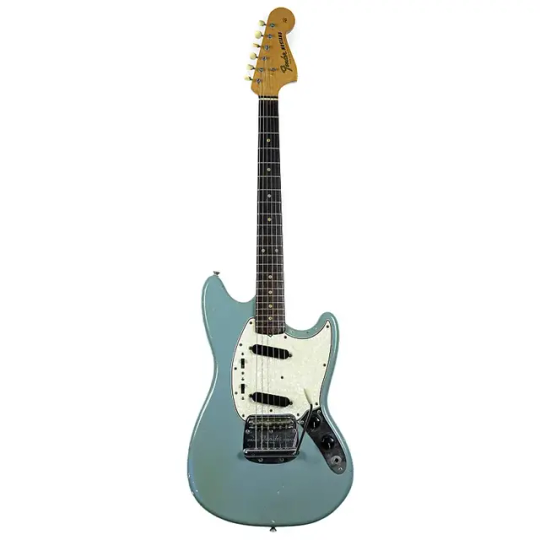
Now, there's one really famous name associated with this guitar, a Seattle-based player sadly no longer with us. Kurt Cobain didn't use a pre-CBS Mustang. No, he used a 1969 Competition Blue Mustang, with matching headstock, in a quite famous left-handed configuration. And yes, he actually was left-handed. It's "common knowledge" that he was right-handed and learned lefty, but no, he was always left-handed, but he was forced to learn to write right-handed, because '70s America is as '70s America does.
Anyway, the Mustang lead to more things: the Musicmaster and Duo-Sonic models both got redesigns using the Mustang's neck and body. "But wait! How does that work? Did they not have shorter scale lengths?" Well, yes they did. You see, the Mustang had 2 sub-variants when it released: a 24" scale length, and a 22.5" scale length. These were produced at the same time as each other, with both being offered in the short scale or the shorter scale. As such, the Duo-Sonic II and Musicmaster II (named with a II to distinguish them from the original, non-offset models) were produced from 1964 until 1969, at which point, they were axed from production, in favour of the Bronco and more deluxe version of the Mustang... is what I would say, if the Musicmaster hadn't lasted until 1982. See, the crazy thing is that these were made from surplus materials. Surplus gets added to constantly. That means they went on for as long as they could, using whatever they had left. We'll get onto that after we talk about Fender selling his company to CBS.
So anyway, we're still in 1964, and Fender's approached by a guy named Porky. No, he's not a pig, his actual name is Quilla Freeman. He'd done his own bit of tinkering with his guitar, and he wanted to present an idea to Fender. A four-pickup guitar with minimal interference between each pickup, and with each pickup actually sunken into the body of the guitar, and hidden by the pickguard. This is what would later become known as the Fender Marauder, specifically the Type I. Freeman and Quilla developed some interesting ideas about this, and Fender even put in a patent application for his design for the hidden pickups around this time:
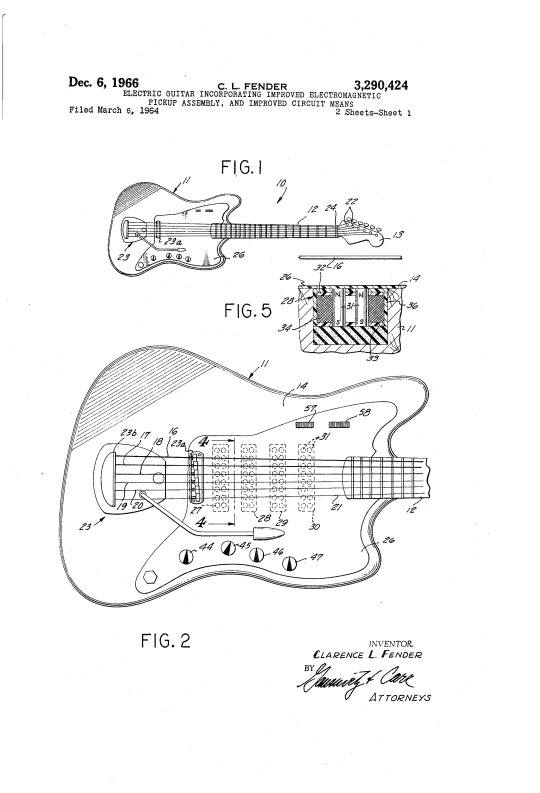
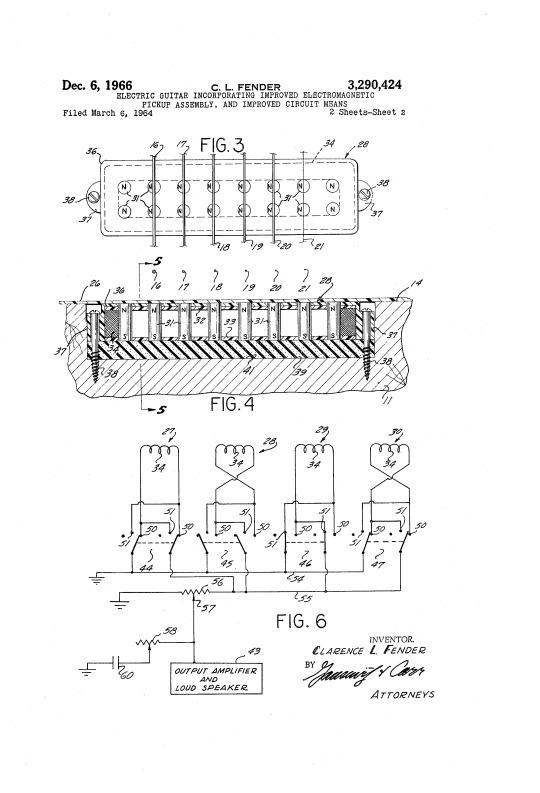
Once again, your eyes do not deceive you, that is 16 individual pole pieces. Per pickup. That's 64 total pole pieces. Also of interest is that the patent features 4 knobs, presumably rotary switches to turn each pickup off, on, or out-of-phase, the thumbwheels from the rhythm circuit functioning as master volume/tone controls, and a Jazzmaster/Jaguar tremolo. It's not as if Fender's options for tremolo systems are limited, at this point in time, he's the only one making good reliable ones, but this is especially interesting.
Now, as you can probably expect, this guitar is shrouded in so many layers of mystery, it may as well be impossible to figure it out. It's also not known why Fender's company bailed on the project, because yeah, that happened. As such, it's all a massive mystery as to why there was no official production-model Fender Marauder until 2010, of which I've made my feelings very clear.
Now you see why I want to build one.
Anyway, 1965 has finally arrived, and the Beatles are playing Strats on Help!, to absolutely no one's surprise. In January, Fender officially sold his company to CBS, and signed his 10-year non-compete clause that prevented him from working for another guitar company until 1976. But we don't care about the bureaucracy of CBS. What we're here for is the guitars, and Fender's insane madness. For example, Fender's appearance in the 12-string business. Rickenbacker had only just entered the genre 2 years earlier, and had quite famously gotten George and John on board, giving them a 360/12 and a 325/12 respectively. But CBS!Fender wanted onto that gravy train.
So Leo's still working for the company at this point, as far as I can tell. He was certainly still a consultant on board at the company, and thusly, anything he came up with became something to try out. Two examples I want to give, both very interesting, are the Bass V and the Electric XII. Let's start with the latter first because that's the most interesting. This also allows me to talk about 2 patents that I've otherwise left alone, mainly because they were filed in 1961, and they only really apply to this guitar.
The Electric XII, as the name implies, is a 12 string guitar. In 1965/66, there were only 18 guitar models, total, that were electric 12 strings being sold, brand new. How do I know this? I spent 2 straight hours in the early morning of February 1st trawling through US patents and vintage guitar catalogs that had been scanned and digitised, and I came up with this list organised by brand:
Fender: Electric XII, Coronado XII
Gibson: ES-335-12, Firebird V-12, EDS-1275
Rickenbacker: 360/12, 366/12 (I know the 370s existed, but they are not distinct enough to be separate models here)
Gretsch: 6075, 6076
Epiphone: Riviera 12, Wilshire 12
Guild: Starfire SF-XII
Vox: Bouzouki, Phantom XII, Tempest XII
Goya: 1209
Hagstrom: F12-S
Danelectro: Bellzouki
Now, the majority of these guitars were just conversions or modifications of previously existing guitars. The only one that may not have been, but I'm not sure enough on, is the Bellzouki, but the one I can absolutely tell you for a fact was not in the slightest a modified guitar is the Electric XII. The Coronado XII is actually a variant of the general Coronado model, which had 3 styles: the I, II and XII. The Coronado's not relevant right now, the Electric XII is.
The Electric XII was purposely built and designed by Fender to capitalise on the folk rock movement of the mid-to-late 1960s, with it being aimed at bands like the Byrds... whose guitarist was Jim McGuinn, an avid user of Rickenbackers, to the point where he still uses them to this day. Seriously. He even owns a ridiculously rare Rickenbacker 331/12LS (one of two known to even exist, which is wild, considering this is what the other was listed for back in 2016; they should probably, and probably do, go for more), a guitar for which no photo currently exists, thus I cannot confirm its existence. McGuinn, however, can be best and most easily seen in this cover of Eight Miles High he published 1 year ago (as of writing this) playing a 341/12LS. This is something I had never heard of, so this is brand new information to me. But this isn't about the 341/12LS, or the 331/12LS, this is about the Electric XII.
So, did it have Fender's desired impact? Did it work? It may surprise you to hear this, considering how Fender's not exactly garnered much in the way of support for the unconventional designs he's made up to this point, but it worked! Gene Clark (of the Byrds, the very same band whose lead guitarist famously exclusively used a Rickenbacker) was seen using an Electric XII in a televised appearance in May 1965, and even long after its discontinuation, Tom Petty, famous for using a 620/12, used the thing for the first leg of the 2006 NA tour he embarked on. Arguably the most interesting and famous users, however, are Pete Townshend, Eric Clapton, and Jimmy Page, all 3 household names even outside the realm of guitar.
Alas, its success was not to last, and it was put to ground in 1969, with surplus bodies and necks being reused for a different guitar: the Fender Maverick, otherwise know as the "Fender Custom", entirely different to the Fender Custom Shop that would come much later. These were 6-string guitars, as opposed to 12, and look... kinda weird? I don't know what to think of them, I'll let you, the reader, decide for yourself:
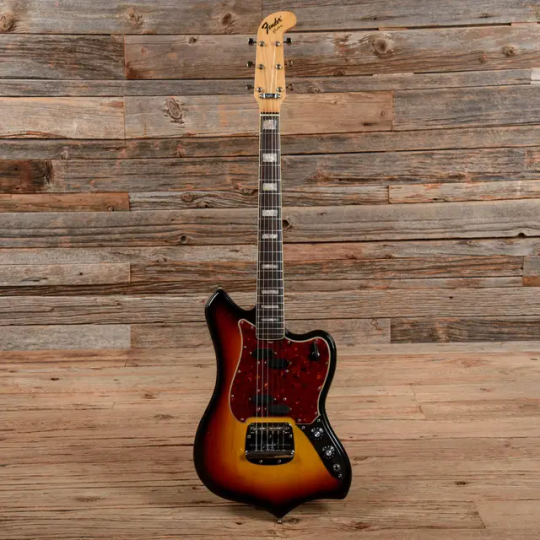
...okay yeah, nah, I'm decided now, they look fucking wrong. That neck looks wrong without 12 strings or tuners on it; the whole point of the hockey stick was to allow for more tuners without elongating the headstock, or incorporating planetary tuners. And the body, God, the body. It looks lopsided. It's had a chunk taken out of the bottom bit by the output jack, the bridge is just slightly too far from the pickguard, the upper horn's too short and got cut off. By comparison, here's what the XII looked like (note: not all the units produced had matching headstocks; this one just got real damn lucky):
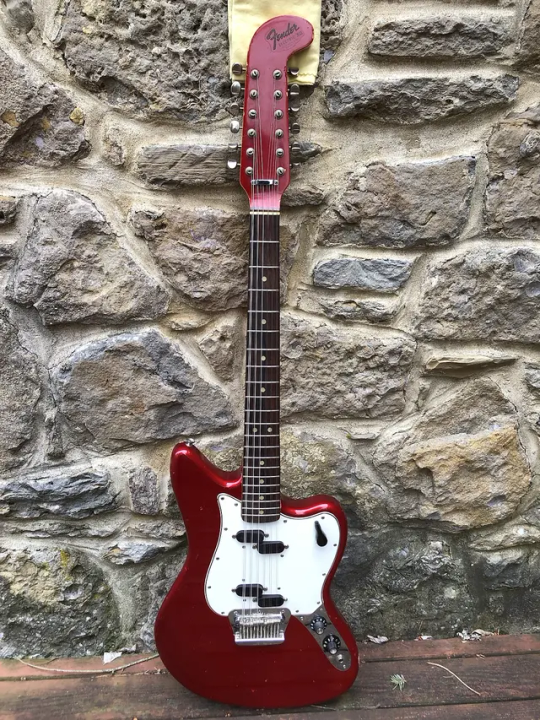
This is far better in my opinion. Anyway, remember how I mentioned the Coronado earlier? Yeah, it's relevant now.
So, the Coronado. It's not the most well known of Fender's designs. Hell, it's not the craziest either. But, it's interesting. Fender didn't have a semi-hollow or fully hollow offering up to this point; prior to 1966, there was no such thing as a "Fender semi-hollow", and frankly, it's not a surprise - they're hard things to make! But, along came Mr. Roger Rossmeisl, a name known far and away for the other California-based company, Rickenbacker.
Rossmeisl probably thought his talents would go to waste at the company. But, Fender proved otherwise, as they put him to work straight away, trying to capitalise on the high-profile usage of hollow-bodied electrics (the Epiphone Casino) by big bands such as the Beatles, the Rolling Stones, and the Kinks. It came in the aforementioned 3 variants: I, II and XII. The I featured a singular neck pickup, the appropriate amount of controls, and no vibrato unit as standard, but could be ordered with a vibrato if one was wanted. Interestingly enough, unlike the Casino, it featured a more traditional floating bridge on both units, as opposed to a fixed bridge such as an ABR-1, which, if anything, makes it more like the 1983 NAMM Crest that I mentioned in the Ideas Archive post. Here's the Coronado I, with and without vibrato, if you wanted to see it without having to trawl through all of Google's search results:

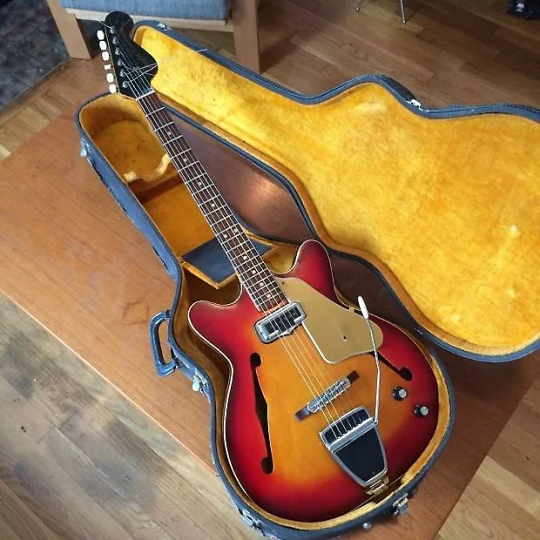
Now, the Coronado II, on the other hand, is the "premium" or, to use a Gibson term, "deluxe" version of the Coronado. If you're confused about that, let me do a quick summary: deluxe just means 2 pickups. That's what the D stands for in something like ES-175D. If there's a T, that's thinline. In short, E230-TD, the Casino's internal model number, stands for Epiphone Casino Thinline Deluxe. While this implies the existence of a large-bodied Casino, don't get your hopes up, a large-body Casino does not exist. Believe me, I've looked for one before, they do not exist.
Anyway, back to the CII. The Coronado II is the premium version for a reason: it has 2 pickups, both DeArmond-made single coils (DeArmond is the company that made the DynaSonic for Gretsch back in the 1940s), and it features that vibrato unit I mentioned earlier, which according to the patent, functions like a Bigsby mixed with the Mustang's trem system. It doesn't appear to have been a stock feature, but rather an extra, as can be attested to by these photos of vintage versions (credits: TheGuitarStore and RetroFret... again):
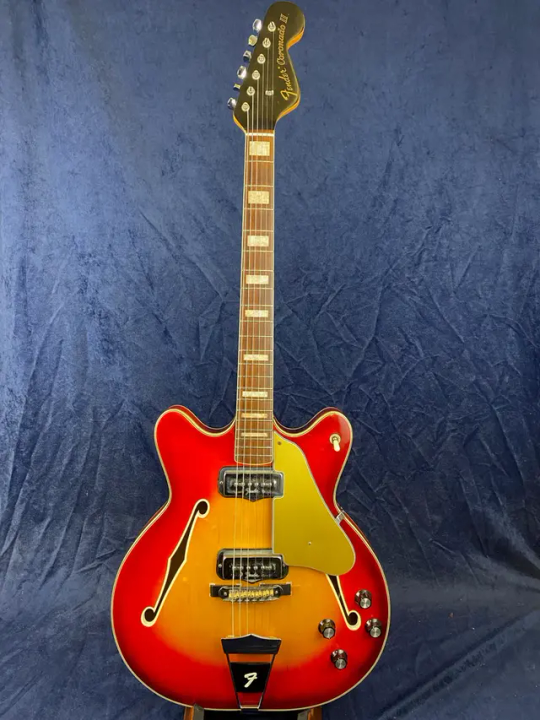
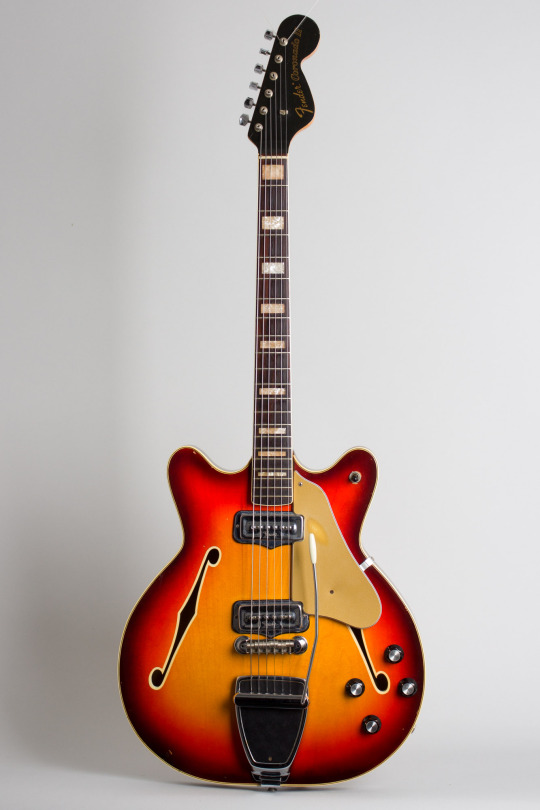
Interestingly enough, these do actually have some design variation between them! On the one with the fixed tailpiece, the bridge is left floating, and thus acts as a standard jazz guitar's bridge would. Meanwhile, the one with the vibrato has a top-mounted fixed bridge, more akin to the Epiphone Casino, but has a longer, bolt-on neck, making the guitar more of a mix between the Casino and its big brother, the ES-330.
The lower horn toggle switch will also come back later, on a favourite model of mine. You'll see. But first, the Coronado XII. This one is interesting, as, like previously mentioned, this was one of 18 models of electric 12 string on offer in the mid-to-late 1960s. It's also, as far as I can tell, the only one that's entirely a hollow body; the only one I haven't got a fully conclusive answer on is the Goya 1209, and that's because it's a Goya, they're kinda weird. It's kinda like Teisco Guitars, because those were happening at this point.
Back to the Coronado XII, the fact that it's a fully hollow body tells me something so incredibly interesting: you could, in theory, get some Lennon-style feedback on this 12 string, if you used it correctly. I wouldn't recommend it though, 12 strings like to continue feeding back once they've started. Anyway, here's what a Coronado XII looks like, with the bonus of a very figured top:
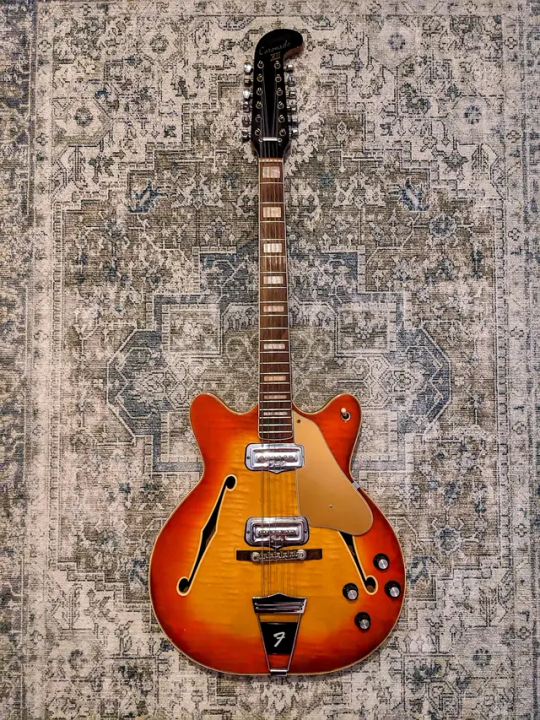
Yes, the headstock is the same as the Electric XII's, it's colloquially known as the "hockey stick", due to the bend at the very top of it looking like the head of a hockey stick. This nickname was actually acknowledged in the descripion of the Squier Jazzmaster XII on Fender's website, but its design comes back all the way to here. More modern Fender XII's will have a curved over upper part, but no hockey stick head.
Anyway, we're finally at 1967. Although the Coronado XII technically existed in 1966, it entered full production in 1967, and ran until 1972. It's actually one of the few things Fender has done that Gibson hasn't up to this point, and even now: a 12-string hollow-body electric. Both sides have done things the other hasn't, actually, because Fender haven't ever done a semi-hollow 12, like how Gibson hasn't done a fully-hollow 12. Who knows, maybe that'll change.
Back on topic, for the next 3 years, nothing of note happens in terms of Fender guitars. The big CBS headstock got introduced and used on some models, but in terms of actual models, none really reared their heads until 1969. Remember Rossmeisl? Yeah, he's still at Fender at this point, and he's now been tasked with making something... a little special. You see, back in the summer, Fender signed a deal (represented by Don Randall, the marketing genius who named the Strat, Tele and Esquire) with Apple Corps., to send the Fab Four a load of brand new Fender equipment.
Now, the late '60s saw 3 models, all brand new, come out for the world to enjoy. Only one still sees regular production to this day: the Telecaster Thinline. The other two are very difficult to explain. You see, Rossmeisl and Philip Kubicki, Rossmeisl's apprentice and later a maker of boutique basses in the US, were charged with making 2 new models of guitar: one was to be sold as regular, with a few prototypes sent out to artists, plus one kept for historical purposes, and for the other, only two would ever exist from the original production, both being the prototypes. These were the Rosewood Telecaster, and Rosewood Stratocaster.
The Rosewood Tele and Strat both started their production cycles in 1968, and before you ask, no, that's not just "rosewood fretboard" or "rosewood neck", like you can get in the Mod Shop. No, it's an entirely rosewood guitar, 2 entire slabs for the body just to make it thick enough. And fuck me, the history on these things are wild. There were 2 prototypes made for each, as stated above - one would go to an artist who definitely used Fender guitars, and one would stay as a prototype for display, so as to say "We made this real!"
The Rosewood Tele made its way into the hands of George Harrison, who used it extensively for the Get Back Sessions, which would later become Let It Be, while the Rosewood Strat was intended for the hands of Jimi Hendrix. The issue with the Rosewood Strat is that the rosewood they used for it turned out to be far too oily to work with; not in a prohibitive way, merely that it had quite a higher-than-average concentration of oil in the wood, which mean that, by the time it was ready, Hendrix had sadly passed away.
Harrison didn't keep his for long, either, giving it quite hastily away to Delaney Bramlett in the 1970s. It stayed in Bramlett's possession until 2003, at which point it was bought back by Olivia, George's widow, during an auction for $434,750, a figure which, when adjusted for inflation, is now $745,437.94. For my fellow Brits out there, that's a figure of £270,936.20, which becomes £536,847.76 in today's money. In short, much moneys were spent on this guitar!
The Rosewood Strat prototype not intended for Hendrix was much maligned as well, as its location is entirely unknown; not even Fender has it! The Rosewood Tele prototype seems to still exist, though I may have been wrong about the "plus one for historical purposes". I'm not going to sugarcoat that bit, sometimes I get stuff flat-out wrong, and if I'm too esconced in a point, I can't just, y'know, go back and change it without writing something new, and it's all this massive kerfuffle that I despise and tend to avoid.
So, to avoid exactly that, and more issues on top, let's just get visuals out of the way. 1 Rosewood Strat, and 3 Rosewood Teles - the top right is the 2022 reissue of the Tele that George got (differentiated from production by a chambered body and an Om symbol on the neck plate), the bottom left is the Tele that Elvis got, and the bottom right is a production model from 1969, courtesy of ATBGuitars:
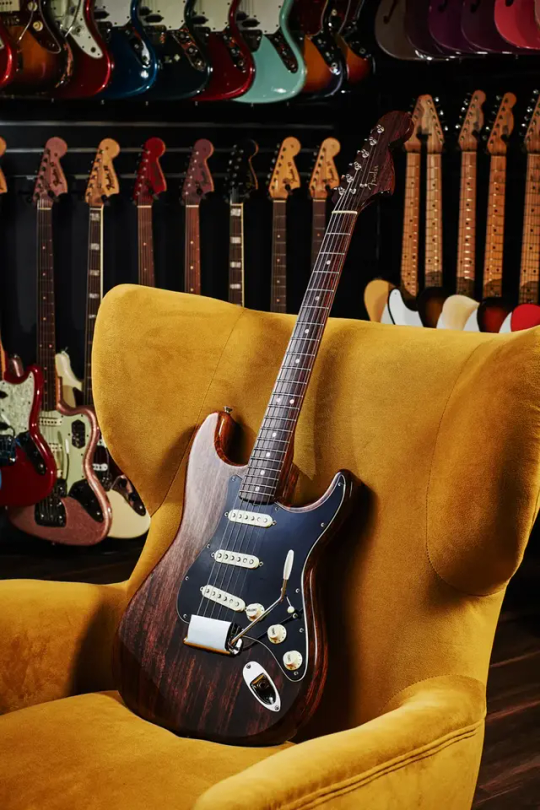
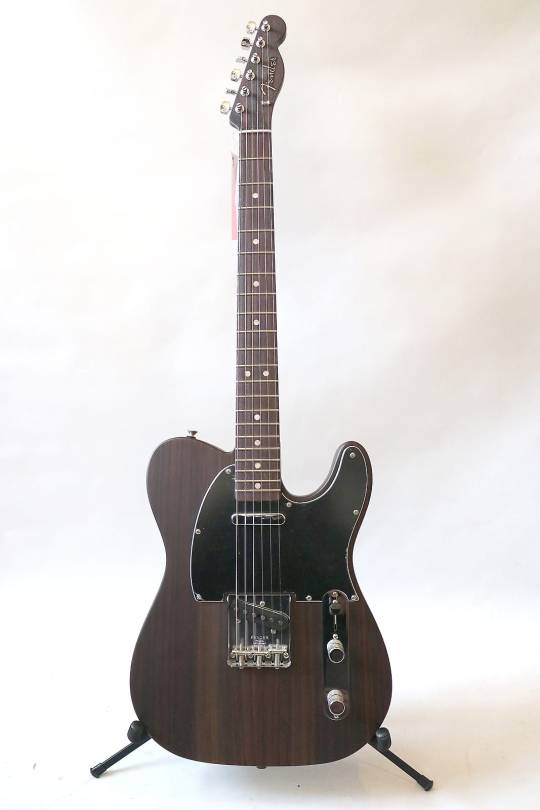
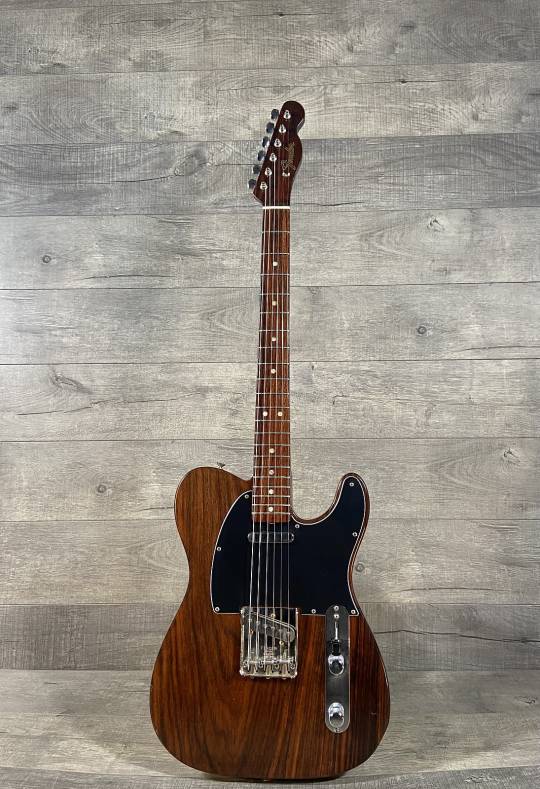
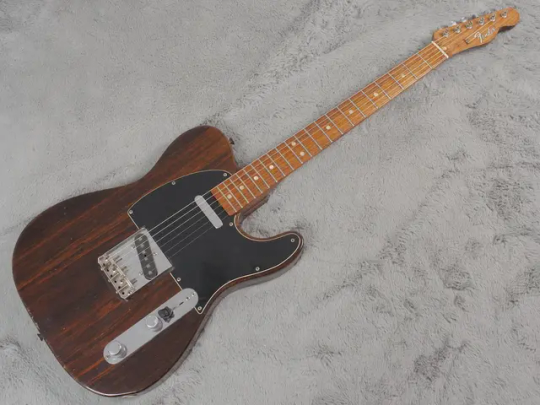
Anyway, now we're past that, let's go back to that personal favourite of mine, the Telecaster Thinline (hey, that rhymed!) The Tele Thinline is a much easier unit to understand in comparison to the Rosewood guitars you see above. It's also really interesting. To start with, it's really interesting to find that, as per usual, these were made in exactly the opposite way that you think. They didn't make these by taking some off the top, routing out the body, then gluing a top on.
They made this by scaling up Rossmeisl's original method: routing out sections both sides from the back, then gluing a "thin" sheet onto the back. If you know where to look, you can see the depth at which the back was removed, and where the new sheet rests, as with this example, courtesy of GuitarPoint... is what I would say if I had any more space to put images.
Alas, I appear to have hit the Tumblr limit, and how lucky am I that I had enough space for the quartet of rosewood models! As always with these things, it's a minor inconvenience, but I have a backup solution: hyperlinks! Here's the image, in hyperlink form. This is how I'll be showing things off from this point on.
Now, where was I... Ah, yes! The Telecaster Thinline is the first semi-hollow offering Fender ever made. But considering that "semi-hollow" usually means "big-bodied guitar with a centre block and two cavities on either side with as many f-holes". The exception here is precisely the guitar we're talking about: Fender were the first guitar company to do something like this, and considering how it's a model that still sees some popularity, I'd say it's going pretty well.
So, we're finally moving on to the '70s, starting with 1970, because of course, where we get the introduction of Rossmeisl's fifth and sixth guitars for Fender: the Montego, and the Hand Carved Ltd., both of which are more traditional jazz guitars than the Coronado or Jazzmaster. As one could reasonably expect of such a guitar from Fender, it quite solidly crashed and burned. They're some of the few guitars that Fender has never reissued, and I mean never reissued, these were only produced in the '70s, and in small number, because they never took off.
Also in 1970, the Fretless Precision bass. Quite an ironic name, no? The P-Bass was so named due to the frets, so going back to fretless seems like a bit of a step back, even if it's better than people tearing the frets out themselves and fucking up the fretboard in the process.
But anyway, we move to 1971. Remember how a few paragraphs ago I mentioned the head-adjust truss rod? Yeah, that comes into effect here. This is what's referred to as the "bullet" truss rod, so named for the adjustment screw looking like the "slug" of a bullet (for those unsure what I mean, bullets come in two main parts - the slug, and the casing). To avoid confusing myself on the matter further, I'm going to move onto my favourite part of this era of Fender design: the Wide Range humbucker.
The Wide Range was designed for Fender in or around 1971 by one Seth Lover. Yes, that Seth Lover, the one who designed the PAF for Gibson in 1954/55. Unlike the PAF, though, the Wide Range was constructed in such a way that resulted in them being tonally closer to Fender's single coils than Gibson's humbuckers, due to being built with the easier-to-machine CuNiFe magnetic alloy as opposed to the usual AlNiCo alloy, which is harder to machine into screw-type pole pieces. The downside to using CuNiFe over AlNiCo is that, by comparison, AlNiCo is "hotter" than CuNiFe, meaning that to compensate for the lower output, more winds had to be added into the construction, which resulted in a larger pickup and a need for a larger casing.
...that's the largest paragraph I've written, I'm sure. Then again, I did do some heavy rambling earlier on in the post, so I could be wrong. Now, where was I. Oh yes! The interesting thing is that the Wide Range was implemented into 4 models, all of which ceased production after 1979, and the original Wide Range design ceased produciton in 1979 as well, with reissues made in later years being made with either ceramic magnets or AlNiCo instead of CuNiFe. At least, until 2020, when Fender reintroduced CuNiFe Wide Range humbuckers. So, all of you with MIM or MIJ guitars with Wide Range humbuckers in them, know that they're normal humbuckers shoved in a Wide Range casing using wax to hold them in place.
Really, you'd never be able to get the high end of a '70s Wide Range-equipped guitar out of a modern reissue because of the electronics, being that the ones with a Wide Range in use were wired up with a 1MΩ potentiometer instead of the reissue standard 250KΩ potentiometer, likely supplied by Chicago Telephone Supply, the company that was, and still is, the usual supplier for electric potentiometers for all the top-tier guitar brands. Yes, this does mean that when "US electronics" is advertised as a feature of the guitar, it means that the main controls for the electronics are US-made.
Regardless of who supplied the damn pots, because that's of no concern here, why is 250K so much of an issue in comparison to 1M? Well, let's do a small tangent into resistance values used by guitars. According to Seymour Duncan (one of the biggest aftermarket pickup manufacturers out there, on par with Bartolini, DiMarzio and EMG), there's 5 common potentiometer ratings, with each having different uses depending on the pickup, those ratings being 25K, 100K, 250K, 500K and 1M. A potentiometer, as you probably already know, or could probably already guess, especially if you've worked with or have modded guitars before, is a variable resistor that changes the signal at the output depending on the setting of each pot on the guitar. For example, a 1972 Telecaster equipped with Wide Range humbuckers, which narrows it down to a '70s-style Thinline, would have been wired up using two 1 megaohm potentiometers, which allow for a more open and brighter top end and sound, due to the higher resistance values in both the volume and tone pot. With these pot, it would have likely been wired with .017 or .022μF capacitors, to counterbalance the harsh, biting, treble-y high end.
If you couldn't guess, guitar wiring is so very complicated. Alas, I do stuff with it anyway, so oh well!
Anyway, as the Wide Range took up the entire year in this explanation (yes, that's the excuse I'm using), let's move to 1972, where the Wide Range was actually put into use, and some patents were granted, such as this one - the B-Bender, for which more information can be found here. Fender didn't invent it, that accolade goes to Gene Parsons and Clarence White of Nashville West and the Byrds respectively, but Fender modified the device's design in order to simplify the mass production of it, and then made a prototype of that design as a proof of concept. However, as he was merely the consultant at Fender at this time, the most he could do was suggest that such a design be put into place, and nothing further.
As a result (which you could probably guess, considering it's CBS), the model was never put into full production, and that's as far as we go with the B-Bender. It did get licensed out to a different company, but it's really niche as a concept - I mean, why would you use a guitar that had a mechanism dedicated to raising the pitch of one string out of six, and it's controlled by pulling on the strap button of all things!
Look, I get you can't just modify the bridge construction to add something like the Hipshot Xtender or the D Tuna (yes, that's how you spell it), but carving out tons of body wood and using the strap button??? Why?! Was it so hard to add a mechanism or something that didn't get rid of valuable tonewood?
With that grievance out of the way, let's see what else happened for Fender in 1972. He was a silent partner for Music Man the previous year, or as it was originally known, Tri-Sonix (yes, with an X - Xtreme Kool Letterz in effect in an alternate use to normal). There's another Rhodes patent, this one in relevance to a "tone generator", something of which I have no clue about. Let's check 1973.
...all I'm seeing is the Tele Deluxe. The Thinline and Custom came out in 1972, but the Deluxe got sent to '73 presumably because of it being a radical departure from the usual Tele design. I mean, a Telecaster with a large headstock? No way they thought that would go down well, not least because it's kinda antithetical to how the headstocks are siloed nowadays. But that's not all. The Tele Deluxe also, in my opinion, inspired Norlin-era Gibson to do something with the Les Paul shape a few years later, in 1980 to be specific. Ever heard of the Gibson Sonex? If not, look it up. Once you've done that, look up a photo of a '73 Tele Deluxe, and then try to convince me that pickguard was not directly copied or at least wasn't a heavy inspiration for them.
Moving on, 1974. Yes, I'm skipping to 1974. The last patent I could make head or tail of was the B-Bender, the last 10 of 59 are just specific design elements being patented in different countries like Canada, Japan or Germany. I'm pretty sure I'm just running through the motions slowly at this point, at least until I can move onto the next few companies.
I guess this is what Leo must have felt like.
Anyway, '74 is when Leo finally gave Music Man that specific name, after changing it from Tri-Sonix to Musitek. Like I said, Xtreme Kool Letterz. '74 was also the 20th anniversary of the Strat, and nothing was done to celebrate that. '79 Strats did celebrate the 25th anniversary though, and the '80-'83 "The Strat" did massive things with it such as 100-micron gold plating. ONE HUNDRED. MICRONS. That is 0.1mm of gold, or about the thickness/diameter of the average strand of human hair. On EVERYTHING that was remotely made of metal, including the scratchplate screws. The FTC only needs 0.381-0.5 microns for something to be gold-plated, and CBS went "fuck it, go big or go home" and did 100. I'm pretty sure they actually lost money making those things.
Anyway, 1975 now, though I did deviate slightly to talk about the "The Strat" models. Yes, it's called "The Strat", like how Norlin made the Gibson The Les Paul from '76 to '79 (technically '80, but I don't know if they actually get counted). The difference is that it's so much easier to find information on the The Strat than it is for the The Les Paul. Guess that's what good documentation does for this sorta thing. Back on topic, Fender's non-compete clause is up, and we're steamrolling into Music Man. And I mean steamrolling, Fender was named the president of Music Man basically as soon as his non-compete expired.
And, by 1976, the other important company was started: CLF Research. This was Fender's way of mass-producing bodies and necks for sale by whichever company. Interestingly enough, this means that CLF Research acted a lot like Schecter did originally; they were both even founded in the same year, in the same state of the US. By June, guitar production had started up, and by August, basses followed suit, the instruments themselves being jointly designed by Fender, and one of the founders, Forrest White.
The instruments themselves first showed up in the 1976 catalog, being a 2-pickup guitar known as the StingRay 1, and the other being a 1-humbucker bass - the StingRay bass. Two things were unique about the bass, which I'm focusing on purely because I know far more about the bass rather than the guitar, those being that it was the original active electronics production bass. Seriously. Even with those 8 massive-ass pole pieces in the pickup, it was an active bass. The other, far less interesting, unique thing about the bass is the tuning configuration: 3+1.
"Wait, 3+1? The fuck does that mean?" Well, I'll tell you. It means 3 on the top, and 1 on the bottom, reportedly to eliminate "dead spots", which, let me tell you now, that is fucking bullshit. Dead spots on a neck don't come from the tuners, they come from the frets. Changing up the way the tuners are positioned does jack shit to improve or hurt "dead spots". But anyway, back to the active electronics, the preamp was mainly designed by the other founder, Tom Walker. The pre-amp is why there's 4 knobs on the control plate: 2 are your volume and tone, and the other two control the 2-band fixed-frequency EQ.
Meanwhile, back at Fender, the last model from the original company that I'll mention, the Starcaster. The Starcaster is... interesting. It's Fender's ES-335, as you could probably guess, and I could be mistaken, but I'm pretty sure it's the first 22-fret, 25.5" scale neck that Fender (the company) ever made. It's got 2 Wide Range humbuckers wired up to 1Meg pots (you remember that tangent from a few paragraphs ago?) with individual volume and tone pots. There's also a master volume pot. Just because. That's the one thing that reissues don't get right, other than the bridge being a 6-saddle string-through hardtail thing rather than a Tune-O-Matic and stopbar tailpiece. Makes me wonder if anyone's ever installed a Bigsby on one of those things.
Anyway, back to Music Man, and mostly leaving the Fender company alone altogether, '76-'79 was mostly uneventful for Fender, but there was a bit of an issue that slowly got worse as that period went on. You see, CLF and Music Man were treated as entirely different companies, and thus were controlled by the company's respective founders. Fender made the instruments, and then shipped them to Music Man for inspection and testing, while Music Man made their amplifiers and accessories in house. This is where that issue I mentioned comes in - every time there was a flaw or defect in the finish of a body or a neck, the guitar was shipped back to CLF for refinishing, and payment would be withheld until the finish was deemed good enough. Not so bad on paper, and, if anything, it's a good arrangement.
Except no it isn't! Due to "fibers" in the finish, a high percentage of instruments were sent back for refinishing. Now, that would be bad enough on its own; a large batch of guitars rejected for finish blemishes can at least be sold as a factory second or B-stock, but in this case, because Fender had no actual control over the Music Man brand name, he couldn't actually sell them, so the refinishing had to be done. Again, this would be fine, except the payment was withheld until the finish quality was deemed "acceptable", which is vague up the wall. If anything, "acceptable" is open to large variances in interpretation, and is thusly unreliable. As you could probably guess by now, this opened up a rift between Fender and Music Man.
This rift culminated in an all-out no-holds-barred office fist fight between Walker and Fender over who was at fault, after it was discovered that a whole batch of guitars had defective necks with truss rods that were installed in the inverse position. Considering they had head-adjust truss rods, this likely means that they were installed as a heel-adjust truss rod would be. Not exactly an easy fix.
As a result of this rift, ties were cut between Music Man and Fender in November of 1979. Fender, as a result, started his fourth company, G&L, with old buddies George Fullerton and Dale Hyatt, making guitars that were much like the old designs he came up with. But instead of doing new guitars exactly the same as the old guitars, his passion for innovation never ceased, and so he constantly aimed to make his guitars better than before.
There's a lot of ways he further innovated on his previous designs. Remember the Electric XII's split-coil pickups? Fender modified the design of those, and turned them into one integrated unit, which he then used on the Comanche model, the unique version of G&L's Strat. I'm not calling it a copy, because can you really call something a copy if it's by the same guy who came up with the original?
In general, though, G&L was partially Leo's excuse to just innovate further, allowing him to do or rectify things that he felt could be done better in one way or another, which can be best seen through the sheer amount of weird and/or interesting things he did with the hardware of the guitars. This includes the:
Magnetic Field Design (MFD) pickups, which are a ceramic bar magnet, combined with individually adjustible pole pieces made of iron, allowing for the setting of each string's output level per pickup. The only other way I could think of this even remotely being replicable on a different guitar would be hexaphonic pickups. As in, pickups that have 6 different signal outputs.
Dual-Fulcrum Vibrato, basically the 2-point synch trem that Fender introduced in 1986, but also taking some inspiration from the Floyd Rose floating tremolo system, in that it allows for the pitch of a note or chord to be raised as well as lowered, rather than only being lowered like the synch trem. I prefer to think of it as the step between a synch trem and the Floyd Rose, in that it's not meant to be set up or used as a floating trem, but it can do both up and down motions.
PTB Tone System, stands for Passive Treble and Bass, gives you 2 master tone controls - one rolls off the treble, as you would expect for a tone control, but the other instead removes low-end frequencies, actually giving the player something approaching a 2-band EQ, like one would have on the StringRay basses. Pretty neat, right? I certainly think so.
Saddle-Lock Bridge, which allows the saddles to resonate like one solid mass by tightening one Allen screw in the side of the bridge, which presses the saddles together. It also makes the string spacing more consistent, and because the bridges used are set into the body slightly, combined with the string-through nature, there's an increased amount of sustain as well, which is admittedly a relic of the '80s, in terms of wants, but it's at least something!
So, Leo's allowed to run wild with ideas. Admittedly, I have no frame of reference for how popular G&L guitars are. I mean, they certainly seem popular, but that's only by the measure that G&L are still around, rather than bankrupt. Like I say, they make Fender-style guitars, which some would term copies, but I don't due to the logic stated above: how can the man who made these shapes copy them?
This is what Leo did for most of the last 11 years of his life. In 1979, his first wife Esther passed due to cancer, and he remarried in 1980, marrying his second wife, who took his last name, becoming Phyllis Fender. She was actually named an honorary chairman of G&L after marrying Leo. Unfortunately, she also became his widow in 1991, after Leo passed due to complications with Parkinson's, which is the only thing that stopped him from working. Even after suffering a series of minor strokes, he continued to work.
But, nothing good ever lasts, and alas, neither did his life. His wife's did though, she only passed in 2020. But her late husband, that Leo Fender, and his buddies George and Dale, they sure had their own impacts. I'm sure there's an area of California where it's Fullerton Red and not Fiesta Red, but that's not important. Leo remained a household name in the guitar world for long after his death, winning a Technical Grammy Award in 2009, and the G&L USA guitars are, to this day, made in Fullerton, California, on the street named in his honour: Fender Avenue.
This took way too long to complete. I've been working on this on and off since December 3rd, at least, that's what the date stamp at the top of the draft says. Luckily, got it ready in time for Christmas. Consider it my gift to the guitar community. I hope you enjoyed, have a happy Christmas, Hanukkah, or whatever you celebrate, and were enlightened by this post. I'm pretty sure this entire post is just over 71k characters total, an achievement in and of itself for me, so if you didn't learn at least something from this, I'm impressed.
#takosader's ramblings number sqrt(121)#yeah that's right we doin math puns for this tag#x was a mad(wo)man#yep it's getting its own tag and everything#guitar#fender guitars#g&l guitars#fender esquire#telecaster#precision bass#fender stratocaster#fender jazzmaster#fender jazz bass#fender bass vi#fender jaguar#fender mustang#fender electric xii#fender coronado#fender starcaster#music man#sorry fnaf fans - wrong music man#stingray bass#no sense tagging any of the g&l guitars#it appears no tags exist for them#bit of a shame really#there's that many tagged guitars here#i'll probably attract the hordes with promises of strings amplification and a free set up#not that i could reasonably provide those over the interwebs#but oh well here we are#jeez this is a load of tags
1 note
·
View note
Note
it's easy being a guitarist who likes rush, guitars are expensive but you can use any to play rush songs. try being a DRUMMER who's a fan of rush. now that's hard.
but fr i love rush yay
Depending on what you get and how you get it, it could be expensive, but at the same time, it's also worth it to learn to build your own guitars and basses! I've got enough ideas in my head for this shit.
On the drum side of things, though, I'd never be able to match Neil. The Professor was VERY skilled, as can be shown by the many drum covers available on YouTube, and now he keeps time for the universe.
Good to have found another Rush fan on here, though!
#rush band#rip the professor#lutherie#i may try and source a 70s style varitone circuit#if i can find one i'm moving the lerxst 355 to shelved#would still have to find a lyre vibrola though
5 notes
·
View notes
Text
Holy shit, the image the body is made of is the album cover of 2112. @mitzo, you are based.
The full image:

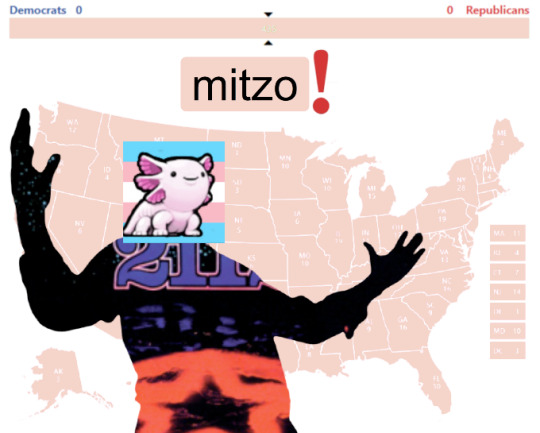
don't worry guys, i'll handle things from here
381 notes
·
View notes
Text
While we're in the prep phase for the Crusader...
...let's go through the Ideas Archive, explore the stuff that's shelved, canned or otherwise not happening right now. This'll be the new pinned post, so I'll use this as a place to put everything I'm currently working on, and what I might do at some point.
Current:
The Crusader, a mix of Burns Double Six, PRS CE24 and Rickenbacker 4001, combined with influences from Hamer, Gibson and Fender. Note: this build is currently in the wood prep phase (stripping pieces of mahogany and sapele door for use in the guitar body and neck) as of 21/11/2024, and will likely take a year at my current progression rate.
Shelved:
Fender Marauder Build (yes, I still want to do this. The Crusader evolved from this, so it's still on the cards)
Casino Humbucker Mod
G6122 Country Gentleman '62 Style
Crest Replica (NEW!)
Telecaster Bass VI (kit body, custom neck)
Lennon Les Paul Jr. Replica (kitbash)
Höfner Violin Bass from scratch
Canned:
Lerxst 355 Replica
Acoustic Rickenbacker 360/12C63
Telecaster-Shaped Red Special (TSRS)
Plausible:
A non-specific doubleneck.
Resonator acoustic (kit build)
Completed:
Fretless Stratocaster
Cherry XII/Tele-Shaped Rickenbacker (TSR)
So, let's review top to bottom.
The Crusader:
I don't need to explain this much, I've already made a long-ass post about this. As said above, it's a mix of a Burns Double Six, PRS CE24 and Rickenbacker 4001 combined with influences from Hamer, Gibson and Fender.
The design is set in stone, aside from the exaggeration of the upper horn. You'd understand if there was a picture around here of the Burns. In the meantime, I'll get on with describing the others.
Fender Marauder Build:
Not the wackiest idea here, not by a long shot. As previously described, the Marauder is the culmination of Fender's offset guitars, featuring the switching of a Jaguar, the lead-rhythm circuit of a Jazzmaster, parts of the trem system of a Mustang, modified to fit with the pickguard and general aesthetics of a Jag. It even gave the Starcaster, the only semi-hollow by my reckoning that Fender still produces, it's headstock, something Fender afficionados call the "running shoe", at least, that's what my aunt calls it. Considering the contour gets filled in by paint, it's not hard to see her point.
The issue with doing this one is that barely anyone does Marauder vibrato plates. And to do this from scratch? Yeah, I need to find someone who would do the specific metal pieces I'd need, that being the Jag-style metal plate for the lead-rhythm circuit, the switch plate for the pickup switches, the extra long control plate, and that Marauder vibrato plate.
Yeah, if I ever find somewhere that does metal parts out of aluminium or something, I'm gonna get them to do the metal parts of this. Next item on the list!
Casino Humbucker Mod:
This one should be self-explanatory - take an Epiphone Casino, stick some P90-sized humbuckers in there. The only caveat is that they have to be hidden and mounted via dogear P90 covers, which isn't too much of an ask; this guy in Manchester does custom pickups, even hand-winds them. Certainly sounds appealing, may go for those. Next one!
G6122 Country Gentleman:
Yeah, uh... this one's shelved with good reason.
For context, the G6122, more commonly known as the Country Gentleman, is one of Gretsch's most famous guitar models, up there with the Duo-Jet, the Tennessean (now Tennessee Rose) and the one that Malcolm Young gutted and modded for his purposes as the rhythm guitarist of AC/DC. Gretsch list it as the "Jet" but I have no clue if that's a different model to the Duo-Jet or it's a variation, or whatever.
My aim with this would be to make as accurate a recreation of the Country Gent as I could with the documentation and information present on the internet. That means making it with 3-ply maple veneer top, back and sides, utilisng the thumbnail inlays on an ebony fingerboard, slotted for 24.6" (24.75" if you measure from the middle of the nut), with the same style of tuner, the little plaque on the headstock, the vinyl/leather pad on the back of the body covering a backplate access hatch, and all around trying to recreate this mad thing.
The only downside is the cost, because I'd need to source TV Jones Filter'Trons (not hard), maple veneer (harder), Grover Imperials or lookalikes (very hard!), and figure out how to make a veneer press, and how to shape the slightly arched top and back in a 3-ply veneer, not to mention the Bigsby, all the spare parts, the flip-up foam mutes that Jimmie Webster came up with (and also patented).
In short, the entire project is shelved. For the foreseeable future, until I can source all this stuff myself. Onto the next one!
Crest Replica:
This is a new one, inspired by an admittedly newfound appreciation for the Gibson Crest.
...oh right, I should explain what that is.
The Gibson Crest, as a name, refers to 2 different models, respectively produced around the late 1950s to early 1960s and between 1969 and 1972, with a one-off model of the latter style produced in 1983 for that year's Winter NAMM show. Said model is in the possession of guitar collector and YouTuber Trogly, who runs the eponymous Trogly's Guitar Show on YouTube. At first, I thought he was a bit of a knob, or at least a bit naïve, but as it turns out, his show's a good way to pass the time, and satiates the GAS (gear acquisition syndrome) that guitarists seem to get pretty damn often (as far as I know).
The former is estimated to have been produced a total of no more than six times, each custom orders put in by Gibson salesman-clinician and budding guitarist, Andy Nelson. Due to the nature of being entirely custom orders, no one knows the exact specs as they would obviously vary between examples as each guitarist would want something unique.
The body shape is assumed to be reminiscent of a similar model that Gibson were producing around this time: the L-5CT, that being a jazz archtop around the thickness of a Gibson Byrdland, but with a Venetian cutaway, a singular humbucker, a toggle switch next to the cutaway on "deluxe" models (models with 2 pickups as stock) and a trapeze tailpiece paired with a "floating" or freely moveable bridge.
One example of the original Crest, however, had a thinline single-cutaway body with a Florentine cutaway, as opposed to the Venetian cutaway of the L-5CT. It featured a carved spruce top, maple back and sides, with a 7-ply bound top, and a 3-ply bound back, as well as a pickguard made not of plastic, but of alternating dark and light plies of maple.
Now, that's interesting, because (and this is a personal side tangent because this guitar is so very unknown because of Google's overuse of SEO and keywords) the only other guitar Gibson produced with a wooden pickguard that I can think of is the Gibson The Les Paul, produced between 1976 and 1980, and that was only because the way Norlin-era Gison constructed these things, everything was either wooden or metal, with plastic being used as little and as sparingly as possible. The switch tip was rosewood, the binding for the body was rosewood, the veneer on the headstock was rosewood as opposed to holly, the knobs were rosewood, the pickup rings were rosewood. About the only thing I can find that wasn't wooden or metal is the inlays, which are actual abalone, and the binding for the headstock, which appears to be plastic, though this might not be the case.
Point is, the guitar was designed with one main principle in mind: "Can it be rosewood? Yes? Make it rosewood." That's why they now go for around £35k and rarely ever sell.
But anyway back to the Nelson Crest. Yes, that's what I'm calling it, it's better than calling it Crest 1 or Crest Custom. The example I'm drawing from here had bound f-holes, was stained cherry red like most of the ES models around the time, and had an HS pickup layout, with the usual number of volume and tone controls, and a toggle switch in the usual mounting place for an ES model guitar, that being near the treble-side f-hole.
According to the source I'm getting all this from (an article on the Gruhn's Guitars website), it also had a Switchmaster tone switch and was wired for stereo output. The floating bridge, as it was an archtop, was mounted on a rosewood "foot" which was inlaid with mother-of-pearl decorations. The bridge itself, meanwhile, was your bog standard late '50s, early '60s Gibson ABR-1 without retaining wire for the saddles, while the tailpiece has the diamond ornamentation seen on a Casino/ES-330 while also incorporating a shield and coat-of-arms motif.
This motif is continued on the absolutely gigantic headstock, which had individual Grover Imperial tuners, and an inlay featuring a coat of arms with three Moorish crescents on the shield. The fretboard is given the top-level treatment of the era, as is to be expected of a custom build, with 3-ply binding all-around, and Super 400 inlays up to the 17th fret, unsurprising for an archtop. The truss rod cover, meanwhile, is a sort of merger between the typical shape for a Gibson, and the art deco movement which was starting up in the early '60s, with it being a trapezoid interpretation of the standard Gibson bell shape.
This is one of the few images I can find of the original style of Crest, in all its resplendent late 1950s glory:

As you can see, it's basically everything I mentioned above, down to the cherry red stain.
So, that's the Nelson Crest, in all of its custom and stupidly insane glory. It'd be an interesting challenge to replicate that thing, but that's not the one I want to replicate, not by a long shot.
The Crest that I do want to replicate, however, is more reminiscent of a short-neck ES-330 or, to be more conforming to normality here, the Epiphone Casino. This has its own subsets, referred to as Crest Gold or Crest Silver, for the style of the hardware, those being either gold or "brushed silver". Assuming I was mad enough to build this, I would have to either source vintage-accurate parts or get someone to make them custom.
As you can probably guess, neither sound appealing! However, ignoring that, let's get down to business. What is the Gibson Crest, in this latter format?
The Gibson Crest, in the 1969-72 styling, is a double-cutaway ES-style guitar, as you can probably guess. Now, a double-cut ES-style isn't surprising, both CMI and Norlin loved making those. The surprise comes from the features, starting with the short neck, with the join at the 15th fret. Now, normally, that's weird for an ES-style, they all have long necks, with a meeting with the body at the 19th fret. Why does this one have such a short neck?
Well, it's because it's a hollow-bodied guitar, like the ES-330 or Casino. Then again, that is no excuse, considering the ES-330 and Casino both had long necks at this time, even if the Casino returned to the short neck, dragging the 330 along with it whether it liked it or not (kinda miffed about that, I like upper fret access, taking it away on an electric guitar like the Casino is just annoying).
But anyway, the Crest has this short neck, and that's where the similarities to most ES models end. The toggle switch is placed where the first iteration of the 347 would place the coil-split switch, that being the lower horn, and that's about it for known similarities, with the other features being more reminiscent of the original Nelson Crest rather than an ES-330 or similar guitar from Gibson/Norlin.
Let's start with the pickups, which are mini-humbuckers, most certainly an interesting choice; apparently, the reason they chose P90s as the pickups for the 330 and Casino is because it was a "budget" model, and not because they were fucking cowards. That last bit's not important, though, so we can come back to it at a different time.
As with the Nelson Crest, the Crest Gold and Silver have a floating bridge akin to an archtop, though I cannot for the life of me remember if they're an ABR-1 like the original, or a pre-compensated bridge. It doesn't much matter either way, because the fact of the matter is that this guitar has some nice details to it. A 7-ply bound top, with a 3-ply bound back separated by a decorative strip, and a large heel cap which has a strap button screwed into it.
The electronics are the interesting thing. As noted above, the toggle switch was placed in the location where an ES-347's coil-split switch went, which may even be where they got the idea for that, but as is also noted above, the thing has 2 mini-humbuckers with individual volume and tone controls, and treble-side adjustment screws that go through the pickguard.
None of this is nearly as impactful as what the thing was made of, though, because I have been keeping that bit entirely shtum for surprise factor. Y'see, the Crest was made almost exclusively out of Brazilian rosewood veneer, which, for a time, was entirely phased out of Gibson as a wood option, before even becoming a protected wood by the Washington Convention. Trade in it is restricted, even now, and that means it is incredibly hard to get hold of it, even in veneer form.
Does this mean I am shit out of luck? Well, if I wanted to recreate the thing using the exact same wood, yes. If, however, I wanted to recreate the guitar with just any species in the family Dalbergia, rather than specifically Dalbergia nigra (note: that's the scientific name for Brazilian rosewood), I am not, in fact, shit out of luck, as most other species of rosewood (any wood in the family Dalbergia) is not restricted, and has not been under restriction for almost 5 years.
Here's a photo from Gary's Classic Guitars in case you were having difficulty visualising this thing:

I'll be including images like these for projects that are either replicas, or I feel need the image in some way or another.
So, the rosewood veneer isn't a problem. Why is it still a shelved project, then? Well, the fact of the matter is that we live in a capitalist society. Things cost money, both for the item itself and the labour required to produce it. In short, wood is expensive, and I don't have the money yet. You may notice that "too expensive" is a running theme, even in cases where half of the expense is the guitar itself.
To avoid getting depressing, let's move on (finally)!
Tele Bass VI:
So, you may be wondering, "why's this one shelved?"
The thing is, it wasn't intentionally shelved. It's just that I can't really do anything with it without finishing the Crusader first. I need fret wire, wood for the neck, a nut, and a truss rod. Not that many things, but it's also what I need for the Crusader, and in the case of that, I at least have the wood for the neck, and a nut, but that still leaves me without a truss rod and fret wire (which I also need for my acoustic because it's got fret sprout, but that's neither here nor there).
I was intending a maple neck for it, anyway, and I need maple for the fretboard of the Crusader. Maybe I'll be able to sort that at some point. Moving on!
Lennon Les Paul Jr.:
This one's hard to call "shelved" seeing as I've done jack shit with it for 3 months at this point. Do I want to do more with it? Yes, absolutely. It's just finding the werewithall to actually go do more with it. Part of it's been the stress of organising my college stuff, but part of it's also been laziness and just not being able to decide if I want to do it or not.
I'm sure you don't want me to bore you with this one, and you saw a photo of a replica on the previous pinned post, so I'll move on.
Höfner 500/1 Violin Bass Replica:
This one is very much a doozy, but it's at least sensible.
Höfner's been going for over 100 years, that's an accepted fact, something that makes sense to everyone. Their "peak" of iconicity, however, came in the form of Sir James Paul McCartney, who has used Höfner's basses since 1961. Now, since then, they've done plenty of reissues of his (two) different basses, the 1961 with its close pickups, and the 1963 with the wide, separated pickups.
So which one would I go for? That is a good question, because it's really not what I should be asking. What I should be asking in its stead is "do I want to learn Actual Violin Lutherie to make this thing", because the whole "Violin Bass" is not just a selling point, it actually is constructed like a violin. It's a chambered hollow body, like the Country Gent, but it's the size of a violin, with the construction to match, including the use of flame maple (or, to use its more apt name, fiddleback maple) for the back and sides. The top, meanwhile, is solid carved spruce.
Don't believe me about the body size? Look at this sub-model Hofner do, based on the one you can see in Get Back:


As you can see, the body is tiny in comparison to the length of the neck, especially when you compare it to an actual violin:

Look at the proportions on this, then look at the 500/1. Doesn't the neck seem so ridiculously long now? Anyway, that's gonna take some going at, and thus it's shelved for when I feel confident enough to actually do it, or at least to take a partial stab at it.
Now then, we've seen the ideas that I might get round to but aren't being done now for one reason or another. Let's look at the ones that won't be done at all, for one reason or another.
Lerxst 355 Replica:
To the average reader, that name's going to look like gibberish. To be honest, I don't blame you, the way it's pronounced feels like you're speaking gibberish as well. "Lurks-st". It sounds better if you try and put on a Canadian accent. Not full tilt Canadian, with all the "eh"-ing and being super polite, just a hint of Toronto.
Anyway, what's Lerxst? Or, more accurately, who is Lerxst? Lerxst is the nickname of Aleksandar Živojinović, a man known professionally as Alex Lifeson. He was the guitarist for Rush for as long as Rush had existed, until their semi-functional retirement after the death of their drummer Neil Peart. The remaining two members, that being Alex and the bassist Geddy, have performed together since, including at the Taylor Hawkins tribute concert and at the 25th anniversary concert for South Park.
Now, Lerxst has used many a guitar over the past 50 years, from that ES-335 he used in the beginning, to the large amount of PRSes he used between 1990 and 2010. His most famous, however, is the one this one is talking about: a 1977 ES-355 built by Norlin-era Gibson. It has T-Top humbuckers (named as such due to the bobbins having a slightly raised part in the shape of a T), 22 frets on a voluted neck, a 7-ply bound top (you saw me refer to this in the Crest section; 7-ply bound top doesn't mean the top is 7 plies of veneer thick, it means the binding is 7 plies thick, and is bound around a 3-ply top of maple-poplar-maple) with a 3-ply bound back, a Maestro vibrola unit, an individual set of volume and tone controls per pickup, a simple 3-way toggle, and the key part - a varitone switch, with accompanying bypass mini-toggle for the "raw" tone unmodified by the varitone.
The output jack's also mounted to the top, but considering it's an ES model, I wouldn't think that too revolutionary. So, what's a Maestro vibrola unit when it's at home? For that, we need to explain vibrato units overall.
The history starts with Clayton "Doc" Kauffman, who devised the first ever patented vibrato system in the 1930s, fittingly named the Kauffman vibrola. This worked quite differently to vibratos that we know now, as the action of changing the pitch was much more subtle, and was done through moving the arm laterally, instead of pressing the arm down to the body. The sound was meant to mimic a slide guitar (as that's where Rickenbacker's guitars originally started), but there was an ever-so tiny but incredibly crucial detail: the tuning stability was terrible. Guitarists such as John Lennon decided to replace the Kauffman units on guitars they were installed on with other models, such as the Bigsby vibrola, the second patented vibrato unit, and the first to see widespread commercial success.
The Bigsby works in a much more conventional way, using the standard we know now: push down to lower pitch, release to return to normal. Supposedly, it has terrible stability in and of itself, but that is from players who ended up being like Floyd D. Rose, who overused the vibrato of the Bigsby, requiring that they retune. The Bigsby wasn't intended for that; instead, it was only intended to provide a slight "warble" effect to playing, what some would term a "shimmering" effect.
This, in effect, is what Gibson's vibratos were meant to provide, starting in 1961 with the Sideways vibrola. I have an opinion on these: they suck, both in function and form. They copy the function of the Kauffman nearly wholesale, and the large folded up arm in direct contact with the nitrocellulose finish(!), well. Yeah, no, not for me. The Maestro, however, looks and behaves so much better. It functions like a Bigsby would, excepting that it doesn't copy the mechanism wholesale like the Sideways does with the Kauffman.
To explain this, let's go on a small side tangent about a Bigsby vs. a Maestro vibrola, because I assure you, this is actually necessary to the guitar.
The Bigsby works by loosening tension using the leverage of the tremolo arm to cause a deepening of pitch. It's kept in place and returned to normal pitch by a spring which is compressed in the action of using the vibrato unit. The Maestro, however, uses direct leverage on a bent piece of metal to cause the same loosening of tension and lowering of pitch.
This means that the Maestro, while more primitive, is easier to work with when restringing due to the fact that the strings are threaded into the tailpiece, which is then bent, changing the angle and distance between the tuners and the ball-end of the string, thus affecting the tension. The metal returning to its standard shape (because the force required to permanently change its shape has not been applied) is what returns the guitar to standard and proper tension (as long as it's been set up correctly).
The Bigsby, meanwhile, has a specific way of threading the string through the unit before sending it down the neck to the tuner and the nut. When restringing a Bigsby, there is a massive rigamarole if you don't have a Vibramate spoiler installed. You have to thread the string down from the bridge, under the tensioning bar, then up over the string bar, around it, and slot the ball-end on the tiny little post on the underside, so it can function correctly when the arm is depressed. I honestly wish I was joking about this. I have restrung a Bigsby once, and once was all the experience I needed. Never again. I heavily advocate for people to damn well use a Vibramate spoiler on their units, even if it's just because of a personal gripe.
Back to the point where we were, about... 8 or 9 paragraphs ago, the 355 generally came stock with a Maestro vibrola in 1977, so it's no surprise that Lerxst got it on his. It's even featured on the reissues from 2008:

These are the same reissues that have a Fucked Up volute on the neck that's approximately halfway between the nut and the first fret, as opposed to in line with the nut. If I were to recreate this, I'd at least fix that.
So, it all seems possible, right? Then why is the build canned? Generally, it's the fact of the varitone, specifically the chokes. How, the literal fuck, do those things work. If I ever figure how they work, then maybe this will move from the can to the shelf. But right now? Canned. Completely and utterly.
Next, please!
Acoustic Rickenbacker 360/12c63:
This requires much less in the way of explaining. The Rickenbacker 360 is a famous guitar by most stretches of the imagination, soldiered on by its incarnations as the 360/12, used by George Harrison, the 370/12 used by Roger McGuinn, and the 330/12, used by innumerable amounts of famous guitarists like Peter Buck, Johnny Marr, Pete Townshend and The Edge.
But y'see, those are electric guitars. They've got magnetic pickups and all sorts of gubbins in there. My idea with this was to see if you could just... get rid of all that, construct a 360/12 in the double-bound style without that central block and all the electronics, and be left with an acoustic Ricky 12, complete with the compacted headstock and a piezo if I felt like it.
Knowing what I do about how Rickenbacker's shit is made, though, that would require making the body in the form of back, then sides, glued with bracing and then the top, with two sound holes. I'd then have to find somewhere to fit a pre-amp, and make sure that it's the usual thickness before then setting the neck in, which itself would be a 5-piece construction of maple with walnut center stripe and headstock wings, adding the truss rod(s) and the fretboard, before finally assembling the metal bits onto it.
Doesn't sound too hard, sure, but if you look at this example of what the Rickenbacker 360/12C63 looks like...

Yes, that is the entire thickness of the body. It's approximately an inch thick and not all that acoustically resonant. It'd be good as an experiment, but considering I'm debating over getting a standard acoustic 12 at some point, it's canned for that reason. Onto the last canned build, and the last build that's overall a hypothetical.
Telecaster-Shaped Red Special (TSRS):
I laid this whole thing out in a Notepad file back in May or June, as we were finishing up the Cherry XII, as a proposal of "maybe this can be the next build," but I scrapped it a month or so later because I fell into a trap I've fallen into so often it might as well be my home: I wanted to recreate a specific thing, without remembering the way that guitar is constructed, and really, what that guitar is built out of.
You see, the Red Special, built between 1963 and 1964 by Brian May and his father Harold, is a very interesting case of guitar design, in that it was designed to feedback in an appealing way. The internal cavities were actually carved out in a very specific way in order to allow for this, and most copies of the thing do the feedback, but struggle to do it exactly like his. He also has his own brand of guitars mainly made up of official replicas fitted with either a standard Strat-style trem system, that being the BMG Special, or the more accurate design mimicking the original's trem arm made of a knitting needle and a bicycle saddlebag holder.
Now, having only a Telecaster body, I couldn't recreate most of this. I mean, where am I going to put all this stuff? And the neck couldn't be slotted for 24" scale length. It just wouldn't have worked. 25", like the Harley Benton copy, maybe, but then I'd have to modify the body to allow for a 25" scale, and then rout out chambers for controls, the cavity, and the trem system's springs.
Looking back on it, I think I had a grand idea, but had bitten way too much off to just go and do it. If I ever do get it in my head to recreate the Red Special, even without a treble boost circuit or a treble boost pedal, I think I'm not going to try and start from a jump-off point, and just go at it from scratch.
Now then, we've gone through those that've been canned, let's look at the ones that aren't shelved or canned, but aren't currently in play. I denoted them as plausible above, but I might go at them at a slower rate than the Shelved builds.
Non-Specific Doubleneck:
When I say "non-specific" doubleneck, I don't mean "bland-name EDS-1275" like a Chibson or a Gear4Music or Harley Benton or anything like that.
For one, the EDS-1275 isn't the only doubleneck out there, nor is it the only doubleneck Gibson ever made. Rickenbacker made a 12/6 doubleneck 360, fittingly named the 362, as well as the 4080 doubleneck which was a bass on top and your option of a 480/6 or 480/12 on the bottom. That latter one was most famously used by Geddy Lee on Xanadu, as well as the former on A Passage to Bangkok (a song about smoking weed, if you didn't know).
Here's him with the former, in a surprising tuxedo (white with black plastics) finish:

And here's him using a Fireglo 4080/12 back in 2015 for the purpose of playing Xanadu:

Anyway, that's a Rickenbacker doubleneck, but they're not the only ones to do this stuff. Fender also make doublenecks. Well, "make" is a strong term. This is the only one I know about:

This is the craziest doubleneck I've ever seen. It's a basic 12/6, but actually No It's Not. You've got an Electric XII on top, which is the only "designed to be 12 string" guitar Fender made pre-CBS, and the Marauder on the bottom, with the vibrato merged into the pickguard, and the 5 pickup switches and the kill switch and everything that makes it the Marauder.
If I ever decide "okay, let's make a doubleneck," and then actually go through with it, I think I'm gonna take some design cues from all of these. I'll probably also chamber it so it's not uncomfortable to play for long periods of time, and just hide the chambering under the pickguards because that's a thing that could work.
Now, the other plausible idea.
Resonator Acoustic (kit build):
You know how I said kit builds were out of the question? Yeah, I didn't believe me either.
Resonators are a really cool relic of the pre-amplification era. Like, they're the step between electric guitars with magnetic pickups, and the acoustic guitars we all know, minus the piezoelectric undersaddle pickup. They work by passing the strings over a bridge mounted to a resonator cone, and when a string is plucked, strummed or otherwise makes a sound, the cone takes the vibrations and amplifies them entirely acoustically. They were originally made by a couple companies before Rickenbacker came along and invented the horseshoe pcikup and, by extension, the electric guitar.
Those companies were National String Instrument Corporation, and Dobro Manufacturing Company. The former was founded in 1927 by George Beauchamp (anyone who knows the history of Rickenbacker will know that name), and John Dopyera, a Slovak immigrant who came to America with his brothers and father in 1908, sensing that war would soon break out in Europe.
Smart move, fellas!
Anyway, Dopyera and his brothers, Rudy and Emil, soon left National to form their own comapny, Dobro. Dobro is a name with double meaning, in this case - while it's an abbreviation of Dopyera Brothers, it's also the word for "good" in a lot of Slavic languages, leading to the slogan "Dobro means good in any language!"
Due to Beauchamp's work with Rickenbacker, though, resonators fell off the radar in terms of popularity. After all, they'd figured out a form of amplification that didn't use lots of metal, so resonators ended up failing as a product. Or at least, they did for a while. Nowadays, you can find many brands producing resonators, usually for the specific tone resonators provide: rich and metallic. They're seen nowadays as bluegrass and country music instruments, but you can see people like Mark Knopfler using them for songs as well.
Now, this isn't referring to a specific kit build. I found one that's kinda an ES-style thing, with 21 frets, so that's probably the one I'd go for, not least because I like upper fret access, but it's all dependent on if I still want to build a resonator acoustic after the current build, or if I'd want to do something else entirely. It's an odd thing, my mind.
So, what now? The completed section? Eh, not exactly.
I would do a small piece on the Fretless and the Cherry XII each, I really would - God alone knows I love rambling about these builds enough, this post is testament to that on its own - but I don't need to. I made a full post about the creation of the Fretless, and made multiple posts in the course of building the Cherry XII, starting back in January and leading up to June.
But other than that? That's all there is to this post. There's nothing more I can really do in terms of explaining my ideas. I may have more ideas in between now and whenever I revisit this concept, I may reshuffle things, shelve one idea or can another. But as for everything else? It's in flux, constantly uncertain unitl we reach and observe it. I can't really say what I'll want to build after the Crusader, because I haven't finished the Crusader. Hell, I've barely started it.
Hope you enjoyed reading this. If something needs explaining further for one reason or another, tell me, and I'll try and explain it to the best of my ability.
#guitar building#lutherie#fender guitars#rickenbacker#gibson guitars#takosader's ramblings - this time into the double digits!!!#holy shit we did it#10th in the series baybeeeeeeee#anyway there's swearing in here...#somewhere i think#too many things to put in the tags so i'll hit the highlights and do the small postscripts#one - yes i'm aware that the chokes in a varitone system are capacitors and inductors#the issue's not the construction it's the values and the tones; what's the point in making a varitone if it doesn't function like it should#two - i know trogly's crest is a different variation on a normal crest#i watched his video while writing that section and clocked it because of the full hbs and the longer neck#otherwise it's exactly the same as the late '60s crest#three - if some of these feel like they came out of left field it's likely because they did#a lot of the ideas were listed on day 1 of writing this but others got added while i was writing mainly because i wanted this to be complet#comprehensiveness was another aim. yeah - as if i'll ever wring comprehensive and understandable documentation out of my head#wow this is a long post#wasn't expecting the tags to be so big either#guitar#hofner doesn't have a tag on here#but i'll put it down here for completeness
8 notes
·
View notes
Text
So, about that "Marauder" build I was doing...
Breaking news: it is no longer a Marauder build!
For context of the people who randomly stumble across this post without all the lore and shit from my megapost back in August, first of all, hi, welcome to the blog, second of all, this was originally intended as a "recreation" or full copy of a pretty obscure mid-'60s Fender guitar that never saw full, mainstream production - the Fender Marauder.
For further context, the Fender Marauder was a guitar that got a mashup of all of Fender's offsets, plus the Stratocaster, getting the Strat's pickup layout, a pickup selection method similar to the Jag, the Jazzmaster's lead/rhythm circuit, plus a vibrato like the Mustang, and the headstock of the Starcaster, which didn't exist at that point, so it's technically that the Starcaster had the Marauder's headstock, rather than the other way around...
Where was I? Ah, yes, not doing the Fender Marauder. Yeah, no, it's not happening anymore. Instead, the build has, for lack of a better term, "pivoted", thanks to an idea my aunt gave me: doing something original.
Now, in Current Year (2024 is soon to end, and oh dear god it's almost a year since I had the idea for the Tele-Shaped Rickenbacker), originality in the guitar-building world is... not exactly a thing? There's that many Telecaster and Stratocaster copies, combined with the fact that there's only so many ways you can shape a slab of wood into a pleasant experience to play.
My solution? The academic method! And by that, I mean "instead of ripping off one guitar and calling it a day, I'm ripping off multiple guitars," or at least taking from multiple sources, as an academic should.
If you want to see more of this madness, keep reading under the cut.
You still here? Awesome. So, now that you've chosen to read on, let's go through the spec sheet that I made for this exact purpose! Surely, it can't be that incomprehensible, ri-
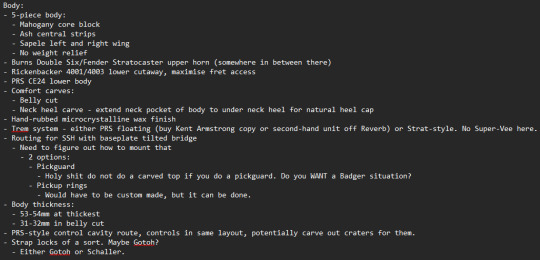

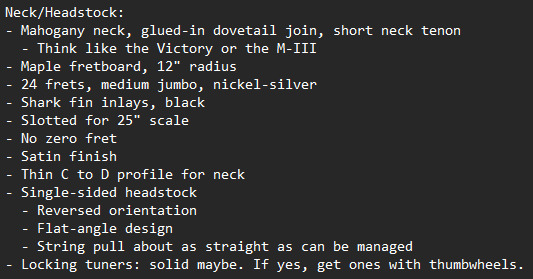
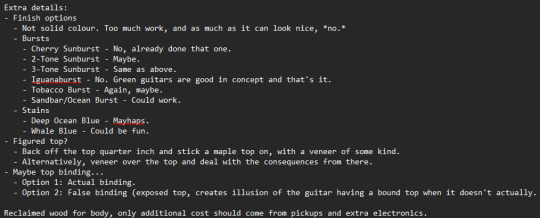
...oh.
Yeah, I went really in-depth. I even mentioned the fucking fretboard radius, that is how in-depth I went. Now, does this in-depth nature help? Oh yeah, certainly. Is it comprehensible? Nope. Not in the slightest. Not unless you browse Wikipedia for fun or watch way too much of Trogly's stuff.
So, a small glossary of terms, before we get into this shit properly:
Comfort carves: bits of wood removed from the body of the guitar to allow for better playing experience, originating with the Stratocaster.
Trem system: also known as a whammy bar or vibrato, this is how you get those reductions in pitch.
Coil split and coil tap: either factoring out one coil's output (split) or removing the effect of some of the windings of the coil (tap).
That's nowhere near all I've got to explain, but if any of you wanted, I'll put out a "translated" spec sheet that attempts to properly explain the shit. Anyway, where was I? Ah yes!
The build no longer being a Marauder has freed me up to do whatever I want now, which leads me to the body design (further screenshots will come from the translated spec sheet mentioned above):

So, let's discuss why those three specifically. But first, were they the original ideas? Not in the slightest! Originally, this was going to be FAR more Gibson-inspired than this, taking from the Scarred Reaper (a Jagstang style merging of the Les Paul and SG created by the aforementioned Trogly, I would recommend you watch his stuff if it wasn't so Guitar Nerd) and the SGV/ZV (that Zakk Wylde signature thing the Gibson custom shop cooked up), with maybe a single-sided headstock.
That idea's gone, DOA when further thought was brought in. The new idea, as specified in the image, is a hodge-podge of 2 guitars and a bass, all 3 of which I've played previously in some manner or form. The upper horn of a Burns Double Six, which (for those less educated in guitars, or can't just visualise a guitar from memory as soon as it's brought up in a conversation) looks like this:

Yes, the guitar body looks like that. Plays beautifully, or at least the one I played does.
So that's the source of the upper horn, even if it'd be less exaggerated than that. What about the other two? Let's start with the lower cutaway, inspired by the Rickenbacker 4001 (or 4003) bass.

Note how the fret access is incredibly good? Yeah, that's not just a thing on the bass. Rickenbacker also make/made a guitar version of this, the 480 (plus a short-lived version known as the 481 with slanted frets - not fanned, slanted), with at least 21 frets of perfectly fine access to frets, and 24 frets total on the neck.
Finally, the PRS CE24, which is being used for the lower body of the guitar:

I could go on for several paragraphs about how and why I'm going with the lower bout of a CE24 for this, or even that I'm basiclally making this a more PRS-style Strat than the John Mayer Silver Sky. But, I won't. Quite simply, I have neither the time nor the energy. Instead, what I'll do is summarise, because I can't put a second read-more link in here.
So, why is it a PRS-style Strat? Well, many reasons. I'm thinking of putting in a PRS floating trem system, doing a 10-degree headstock angle (enough to have the tension, but not enough to risk headstock breaks - looking at you, Gibson, with your 17-degree headstocks!), and, most importantly, I'm going for a 25" scale length, which effectively gives me the very basics of a PRS guitar, minus the construction and the pickups.
But continuing from there, the only thing preventing this from being a "normal" PRS build or similarly designed guitar is the pickups I'm using. They're not any of the usual fare that PRS use, not by any stretch of the imagination. What I'm planning on using is, as laid out in the spec sheet, a Fender-style Wide Range Humbucker, a reverse-wound, reverse-polarity Tri-Sonic imitator (because I don't want to try and source Burns or Adeson pickups for this, so Kent Armstrong it is), and a Tonerider Hot Classics Broadcaster bridge pickup (it's the bridge pickup specifically because a Telecaster's bridge pickup is tilted with a black bobbin). Now, dear reader, can you guess what positions I'm going to put them in?
If you guessed that I'm going to be sane and normal by putting the humbucker in the bridge, you're entirely incorrect, unfortunately! Instead, I'm going for an at least sane positioning for the Broadcaster pickup, putting that next to the trem system, or at least as close as can be within reason, that RWRP Kent Armstrong Tri-Sonic in the middle position, and the humbucker in the neck position.
The result of that, in concept, should be a fuller sound in the neck, and depending on how I wire the pickups (which will most likely be in series) a really bitey sound in the bridge, the kind that gives some levels of distortion a run for its money. A comparatively "thin" sound is to be expected, as this project is to have 24 frets, and thus a tighter pickup spacing.
The idea is similar to this guitar made for Alex Lifeson by Paul Reed Smith (yes, that's what PRS stands for), which uses an EMG in the neck, and a Signature Guitars single coil in the bridge, with Signature Guitars being a short-lived brand that Lifeson worked with in the mid-to-late '80s until the company's dissolution in 1990.

That's partially what's inspiring me on this specific pickup configuration, as I've heard the tones that this specific guitar's made, going back to at least 1991, for the solo on Dreamline. Considering the guitar's serial dates it to 1990, so it's likely he got it from PRS for the explicit purpose of recording the Roll The Bones album.
But that's not important, nor is it even the point, because damnit, I love rambling about tangential shit! Anyway, to get back to the point of this rambling, this is a PRS-style Strat in the least Strat-like manner. None of the parts I took from are a Strat, or really have any relation to it outside of the Double Six. The CE24 is inspired the double-cuts that Gibson made, and the 4001 was made back when originality was actually a thing in guitar design.
But the result of all that designing, combined with a little bit of image compositing, was this:
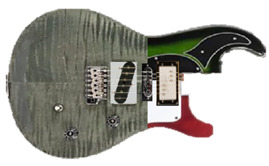
Now, I'm aware that this design, for lack of a better term, looks like shit. It's way too stretched out, and nowhere near like realistic. In my full defense, this was made in Paint at close to midnight, so I doubt I was thinking at full brain power. I'll probably de-stretch it at some point, if I can be arsed to do so.
The neck, by comparison, doesn't look nearly as bad, but considering how hard it is to fuck up the look of a neck, it's not that big a deal. The idea of a neck is to give an anchor point for the non-ball end of the string that allows for a tension adjustment point, with the fretboard acting as the point where frets change the note/pitch the guitar plays.
As God Pythagoras Intended.
Side note, fuck that guy! He broke music 2000 years ago, and we still haven't recovered!
Back to the matter at hand, though, my compositing process for the neck was based on inlay style, number of frets, and headstock shape. Now, I mentioned above that I was doing a 2-octave neck, 24 frets total. The "neck" (by which I mean the fretboard) was taken from a Rickenbacker 360, and the headstock shape was taken from a Gibson Firebird, the last remaining relic of this thing's Gbison influences, resulting in this composite:

Please note that the transparency for all this was done in Word, which is the best I can use to get specific bits and pieces of guitars to mash up and weld together like fucking Victor Frankenstein.
The full thing, combining both neck and body composites, came out of this process looking like this...
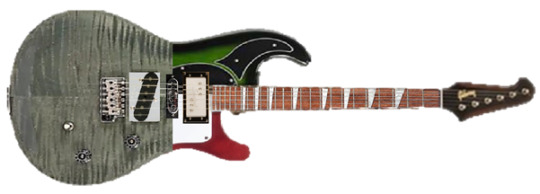
...as you can see, very squashed, very stretched, which was not the intention, I assure you! So, as a help to my brain, and possibly to the very few people who stumble across this who know good proportioning, I squashed the width down a bit further, albeit at the cost of making the neck feel too short for the body:

I could throw a squashed down version of the body back into Paint, add the standard-sized neck, and operate from there on the image front, but there's a small issue of CBA to contend with. In short, I can't be bothered to do it.
Now, you might note that the headstock lacks tuner tips. Why? Because the Firebird had planetary tuners, what some would term "banjo tuners". The basic idea is that, to facilitate string pull, they made a new headstock design (because before this there were 3 Gibson headstock styles - open book, which was the standard one, triangle, for the Flying V and related models, and hockey stick, which only got used on the Explorer until Aldo Nova came along in 1982). This new design utilises the planetary tuners for... some reason, Idk, I can't find it. Point is, at first, this is what I was going to go with, Firebird headstock shape and all.
However, upon further rational thought, I'm just going to go with a Hamer-style headstock, specifically one like the Hamer USA Centaura, which looks like this:
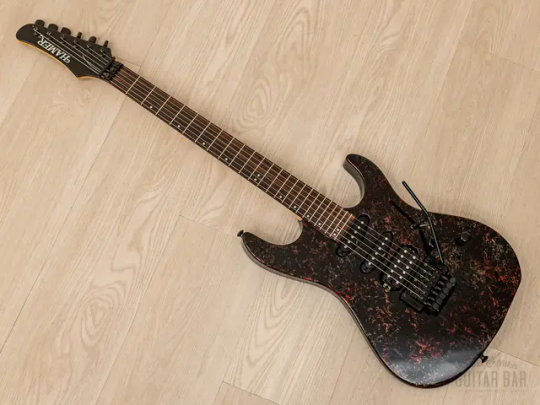
I was kinda debating on putting a Floyd Rose or similar on this, being influenced by this thing, but they're not exactly cheap to install, replace or repair, so that's why the PRS trem. The one thing I'm still debating on from this is the "sweet switch", which was designed for Carlos Santana by PRS, purely because he was known for using a long cable prior to going wireless. But that's not the point.
What is the point? Fuck if I know. I've been writing this on and off over the past 2 or 3 days, I just set out to make an in-depth Tumblr post about my guitar build, and here I am talking about a Hamer and Carlos Santana. To try and steer myself back to the point, let's talk the unique bits, stuff I've only seen done... 2 or 3 times, total. In this case, I'm talking about unique pickup selection methods.
There's a couple I have in mind for this build: a rotary switch, and individual slider switches. Now, why are these unique? Because both are rare to see on production-level guitars. The former comes from PRS guitars from the '90s, which worked really well, except people couldn't figure out what pickup they were on, while the latter I've only seen in 2 different styles on a total of 3 guitar models.
Style 1 is what I'm thinking of doing: Jag style, where there's a control plate to select what pickup you're using, and you can select and swap on the fly, which is similar to the Red Special, which has 3 pickup switches and 3 phase switches - the top row is pickups, and the bottom row is the phasing. Brilliant bit of kit for a guitar built 60 years ago.
Now, the other style of switching is a bit more convoluted than that, because it's Mustang switching, which is 3-position sliders mounted horizontally above each pickup. Position closest to the bridge is off, central is on, and position closest to the neck is out of phase. Sounds like the Red Special's method but condensed into 3 switches, right?
Well, the fact of the matter is that Brian's design and build was done between 1963 and 1964, and the Mustang didn't enter production until the latter year, so it's likely but not certain to be a case of convergent design/evolution.
Each idea has its merits. While, yes, a rotary switch would be less clunky, not to mention easier to install, you then have to manually wire each and every pickup combination you want. Now, that's fine and dandy with 2 humbuckers, you can do full neck, outer coils, both pickups, inner coils, full bridge, and in fact, that's how PRS did it. The issue is doing 3 pickups, one being a humbucker, and the other two being single coils, because then you need at least 7 positions, by my measure:
Neck
Neck + Middle
Neck + Bridge
Middle
Middle + Bridge
Bridge
All 3 together.
Now, I could be missing the forest for the trees, or at least the wood for the figuring, but I'd rather avoid having to wire up 7 different positions, especially because I'm not doing any fancy pots here. By comparison, individual switching seems more appealing, as there I can just have 3 switches for neck, middle and bridge, and be done with the whole matter.
Moving on from that, we have the aesthetics of it. I don't know what finish I'm gonna go for, considering I've debated at least 6 different finishes in my head for this build since I started it. I've debated on 2-Tone Sunburst, 3-Tone Sunburst, Tobacco Burst, Sandbar Burst, deep ocean blue, whale blue, grey black, all sorts. In theory, any of these 6 I listed could be the one I go with, which is pretty obvious.
Then again, I could go with some mad bastard finish like Faded Whale Blue Smokeburst (diluted Whale Blue stain, add on top a black ring on the front, dark sides, kinda tear drop figure on the back like an old '70s silverburst, the works) and deal with the convolution of doing that on a flame top.
Maybe I'll end up doing that. Who knows.
Oh, I almost forgot! I even gave it a name: the Crusader, acknowledging that a) it's my design, and b) it was based on the Marauder. It's going to be a long road to its completion, possibly a full year (remember, this is with hand tools, no large scale machinery) instead of the 6 months it took to build the Cherry XII. Most of it's going to be either mahogany or sapele, with the odd bit of maple or ash in there, but by the end of it, I'll have something unique to call my own. You couldn't get me to give it up if you tried.
Things I didn't go into detail about:
Binding stuff
Neck heel carve
Locking tuners
Inlay style
Possibly other shit I'm forgetting
Hope you enjoyed reading my ramblings this time!
#guitar building#lutherie#takosader's ramblings number nine... number nine...#that's a beatles joke btw#prs guitars#burns guitars#rickenbacker#not really a fender anymore#gibson guitars#if y'all want the translated spec sheet#don't be afraid to ask#otherwise it's languishing on my hard drive#and no one wants that#also did i mention this is mostly reclaimed wood#yeah the body's gonna be mostly made of door#it's solid fucking mahogany!!!#the kinda stuff you wish for when building this kinda stuff!#anyway there's swearing in here...#somewhere in here; i'm not scrolling through 3 days' worth of ramble just to tag hyper-accurately
3 notes
·
View notes
